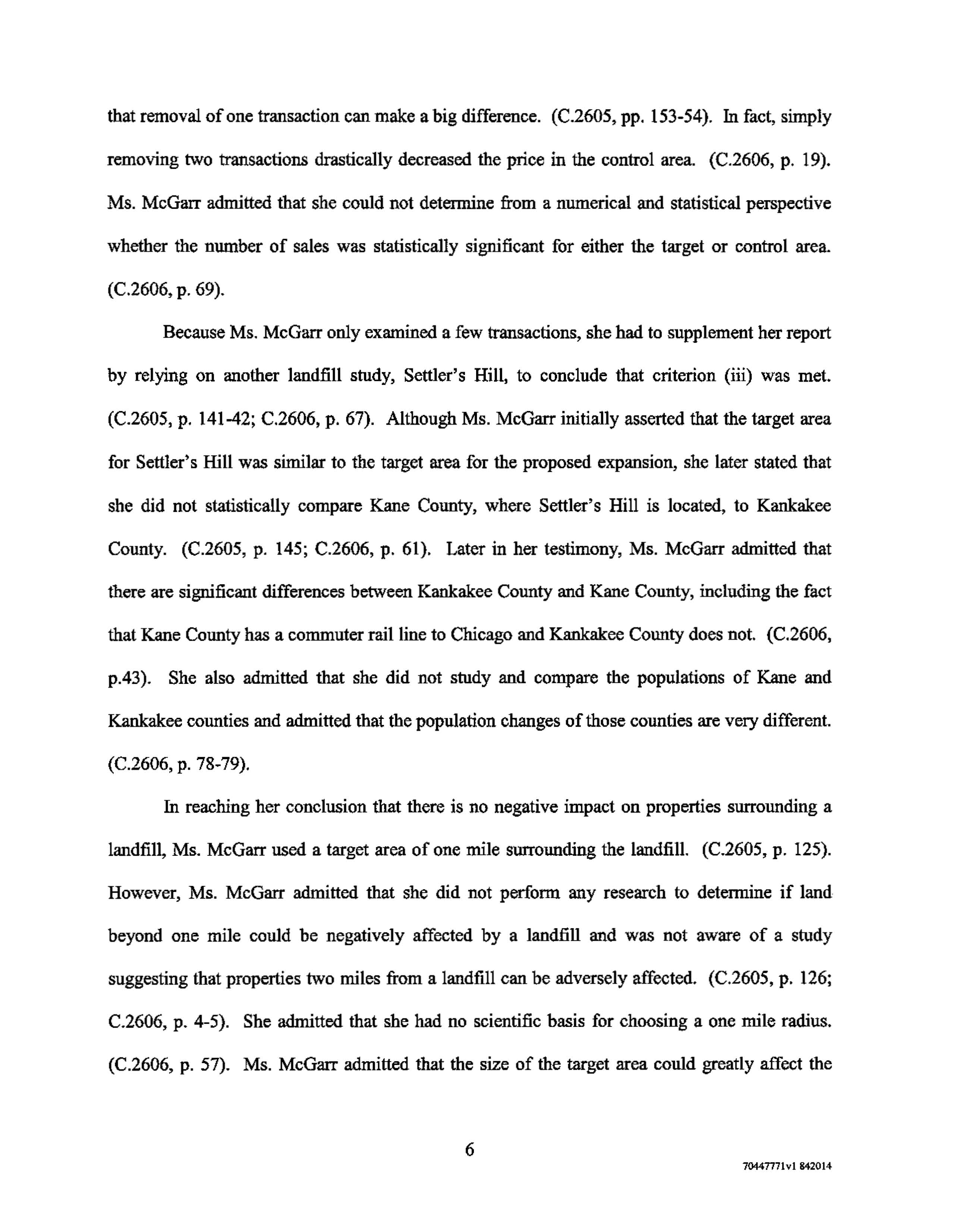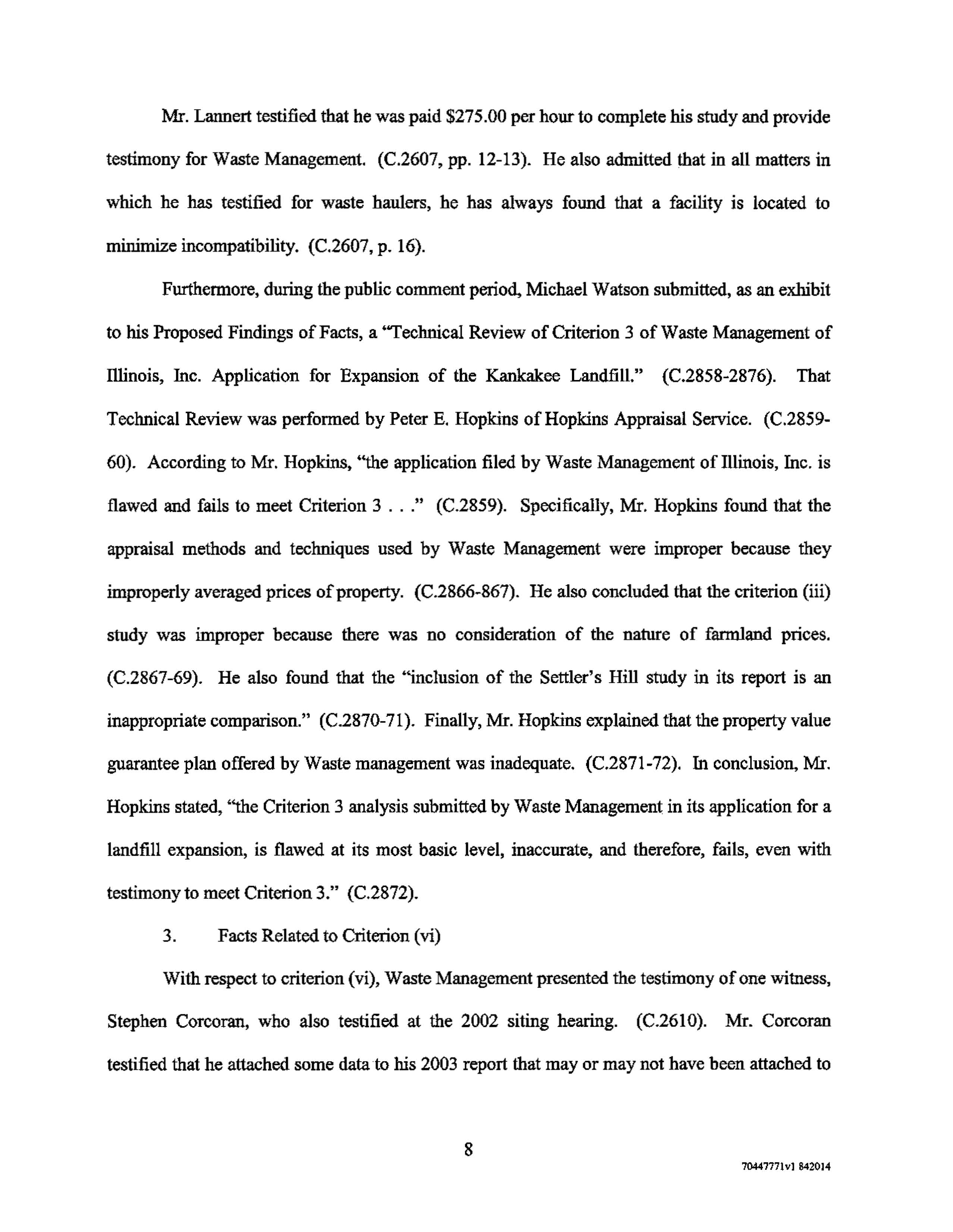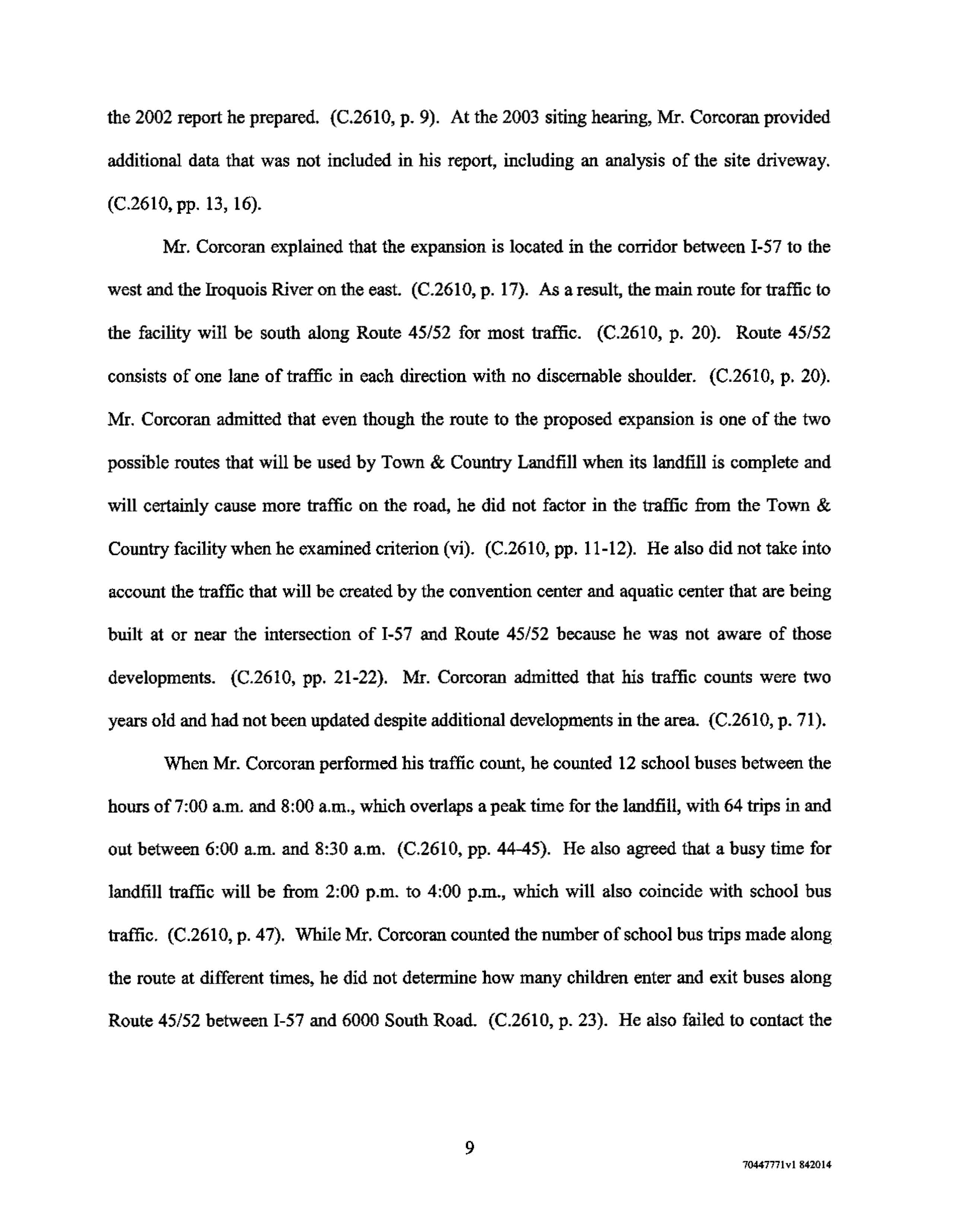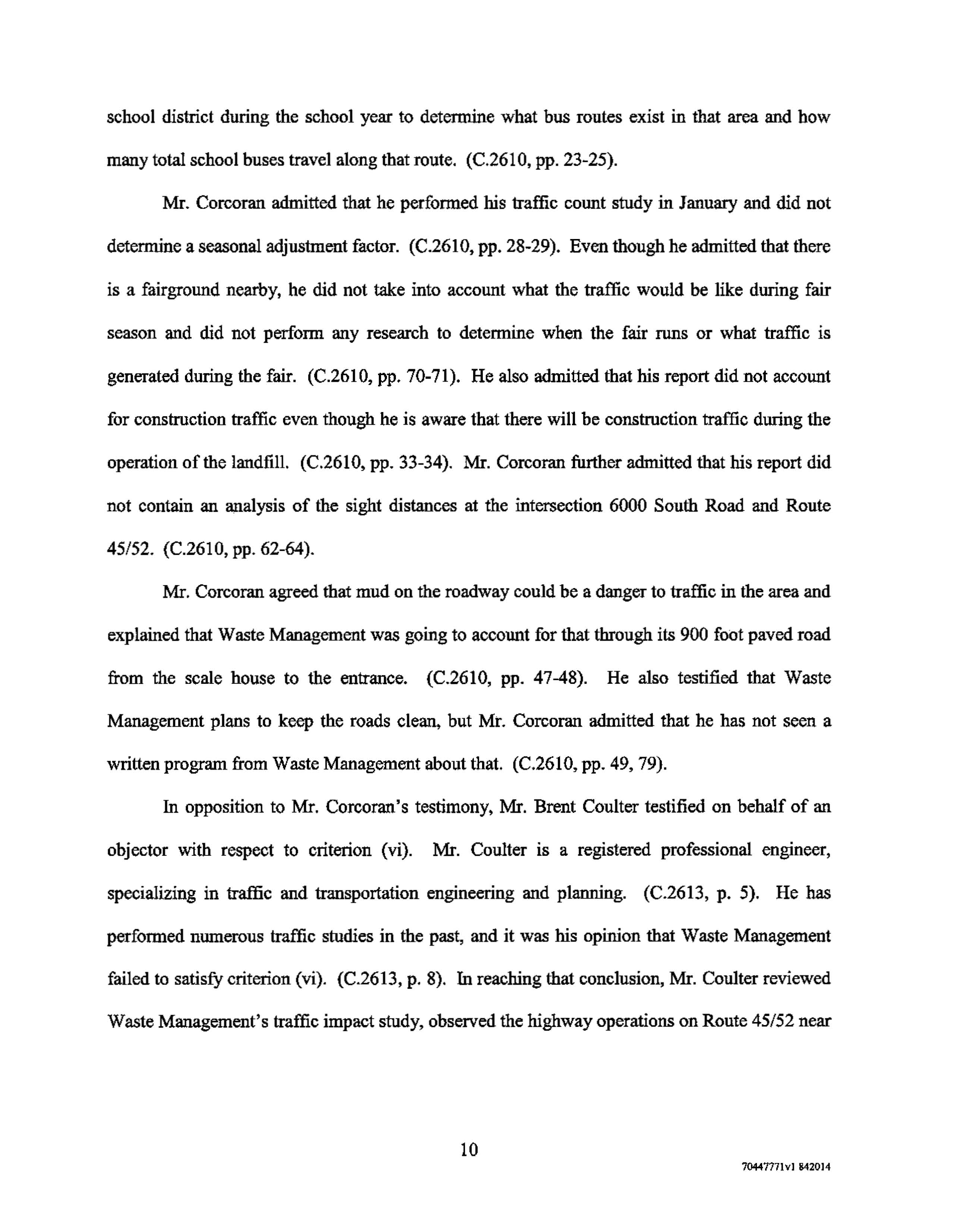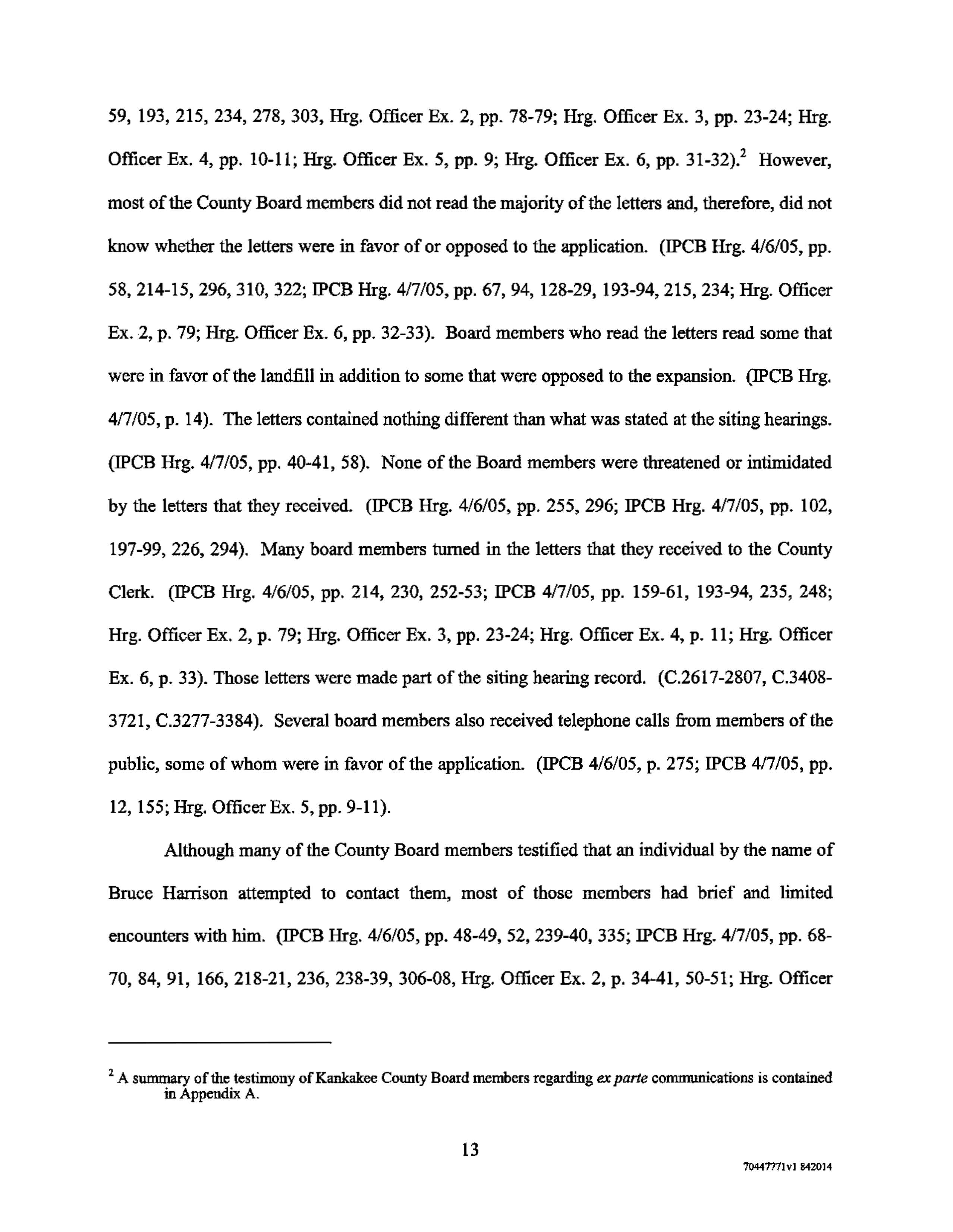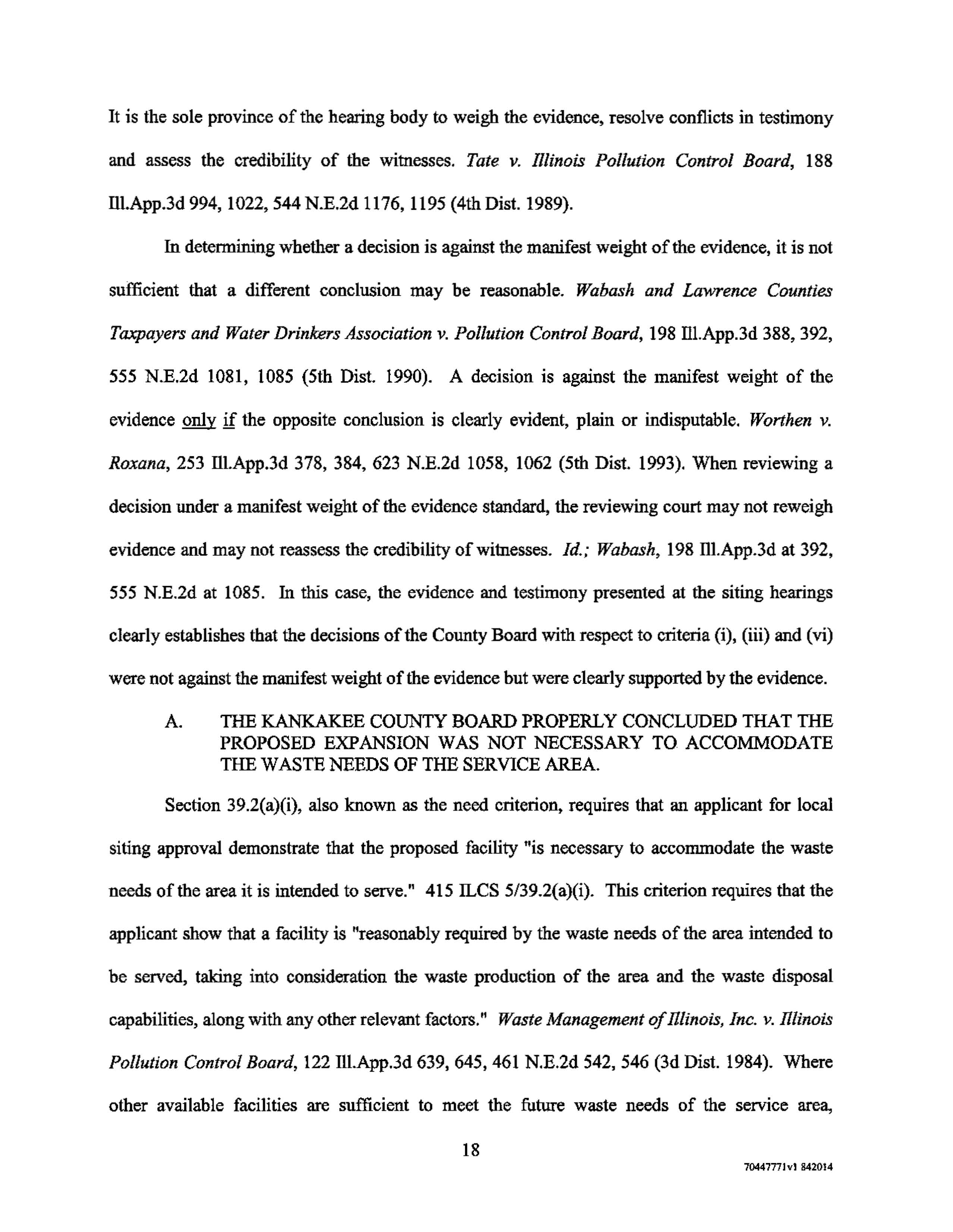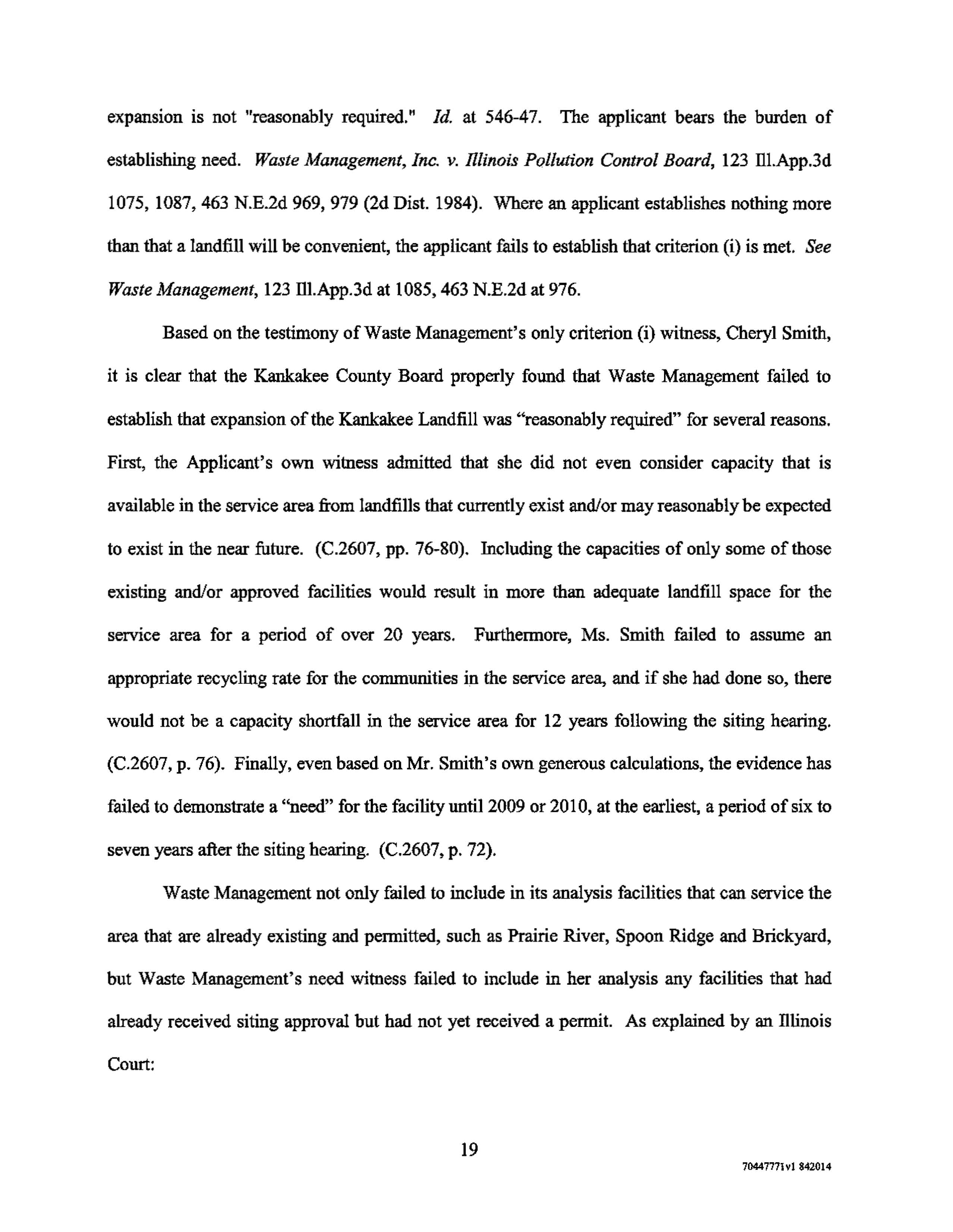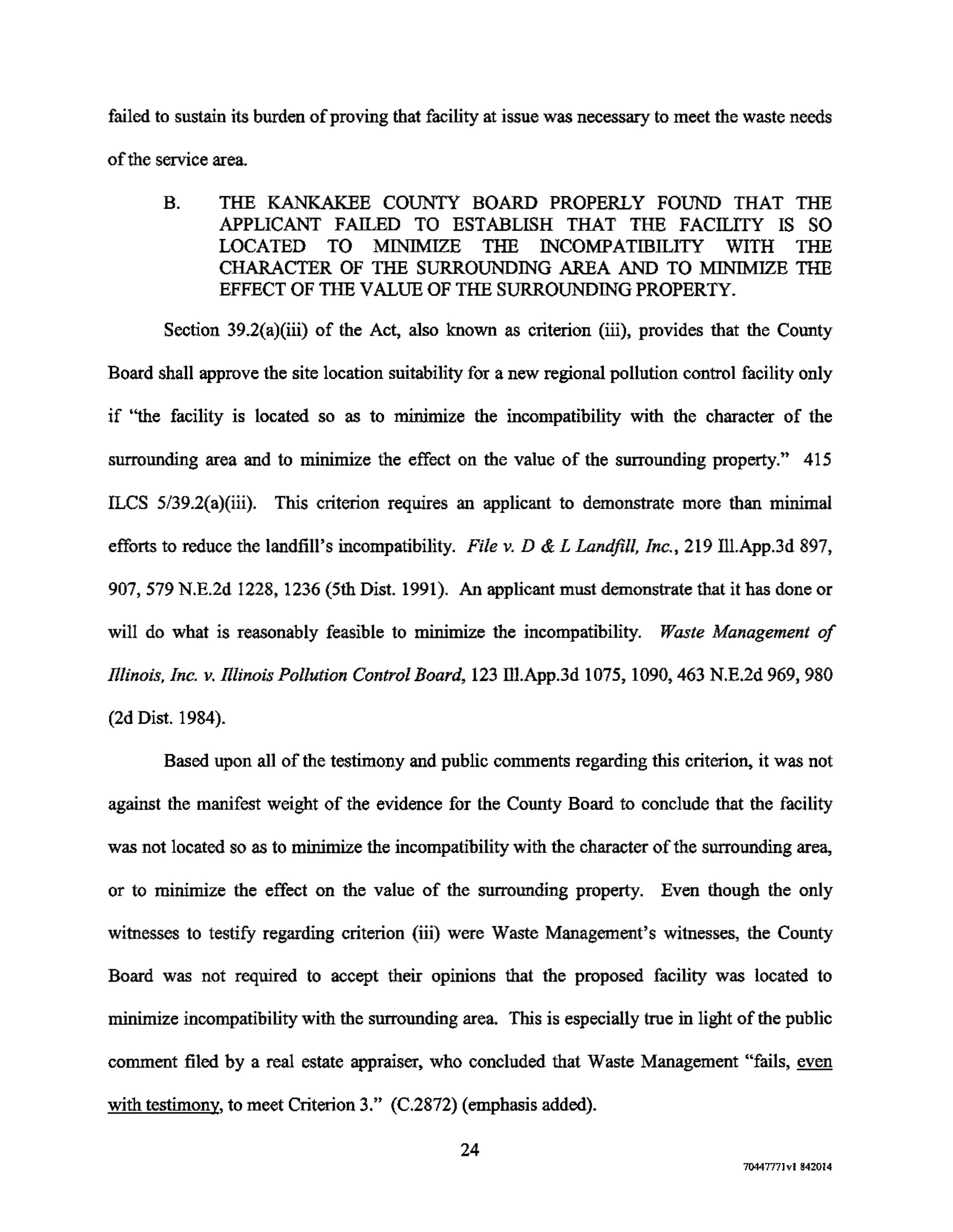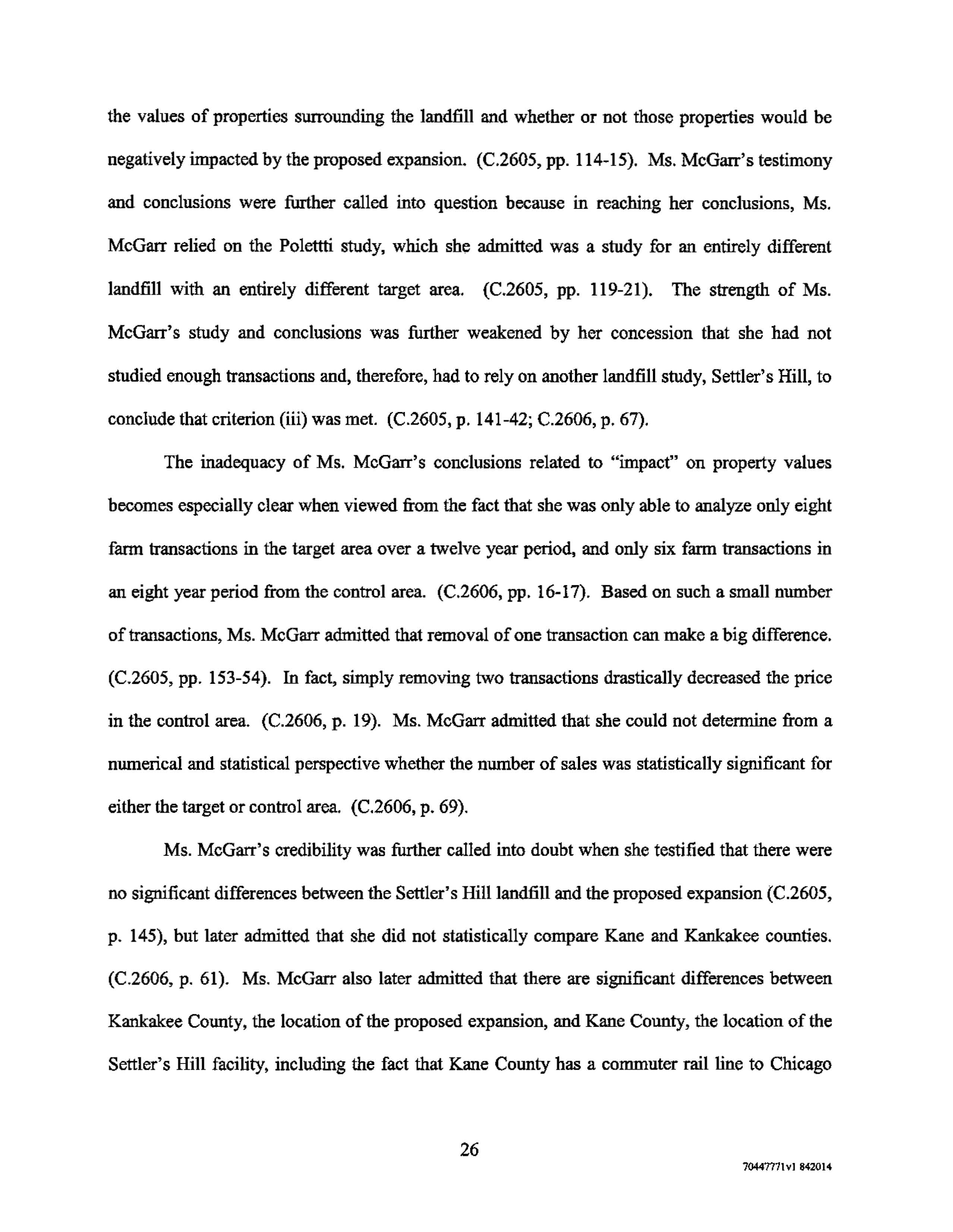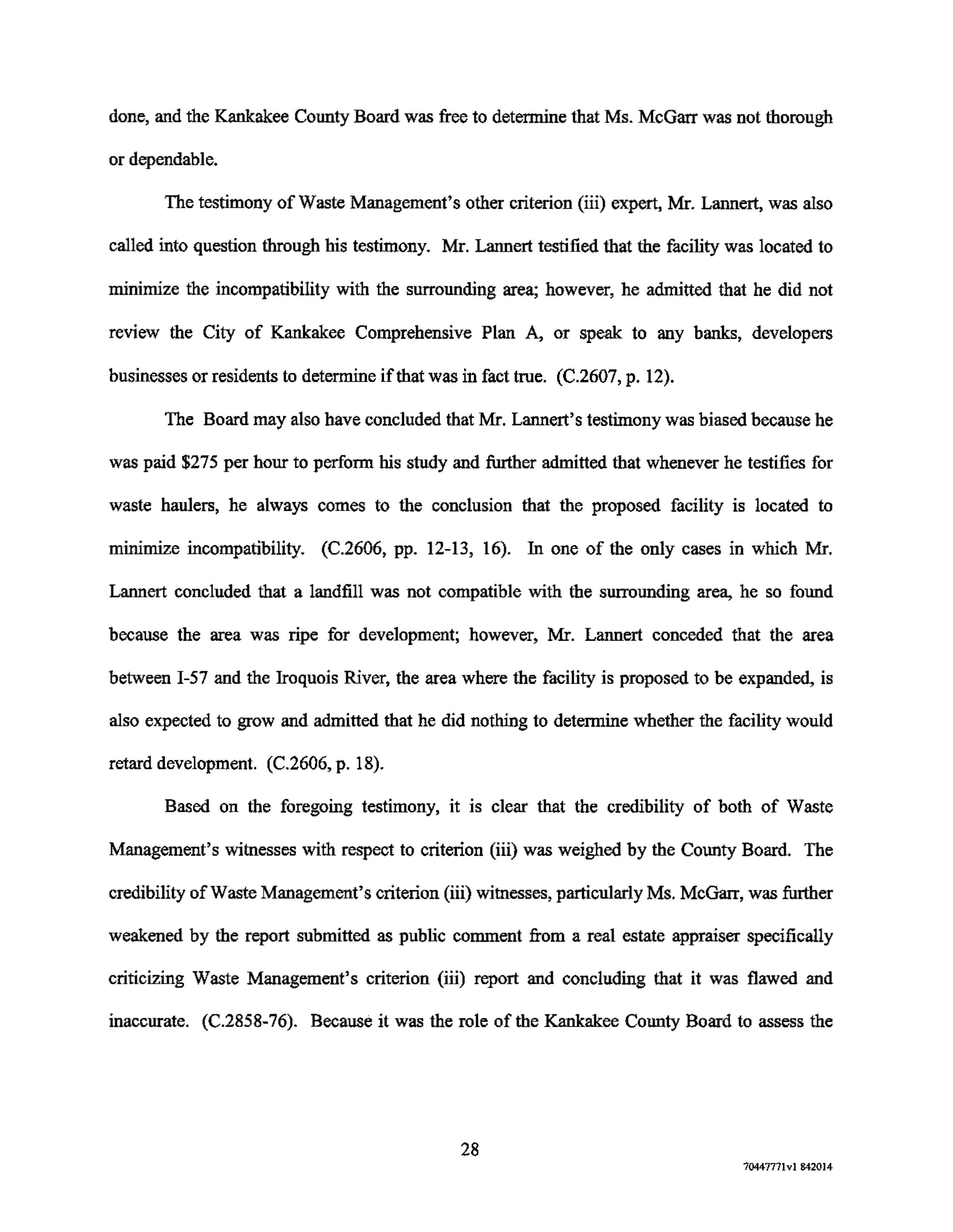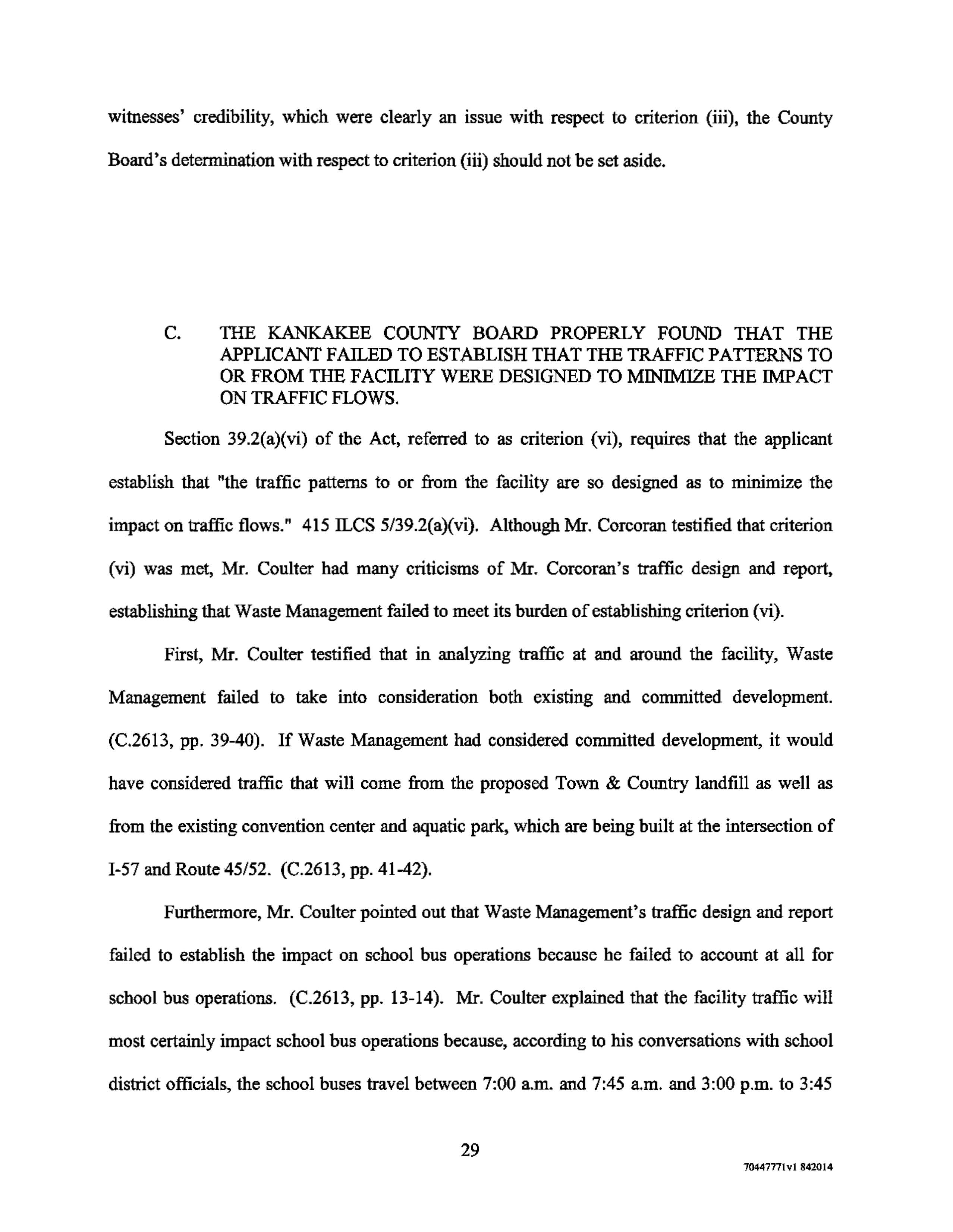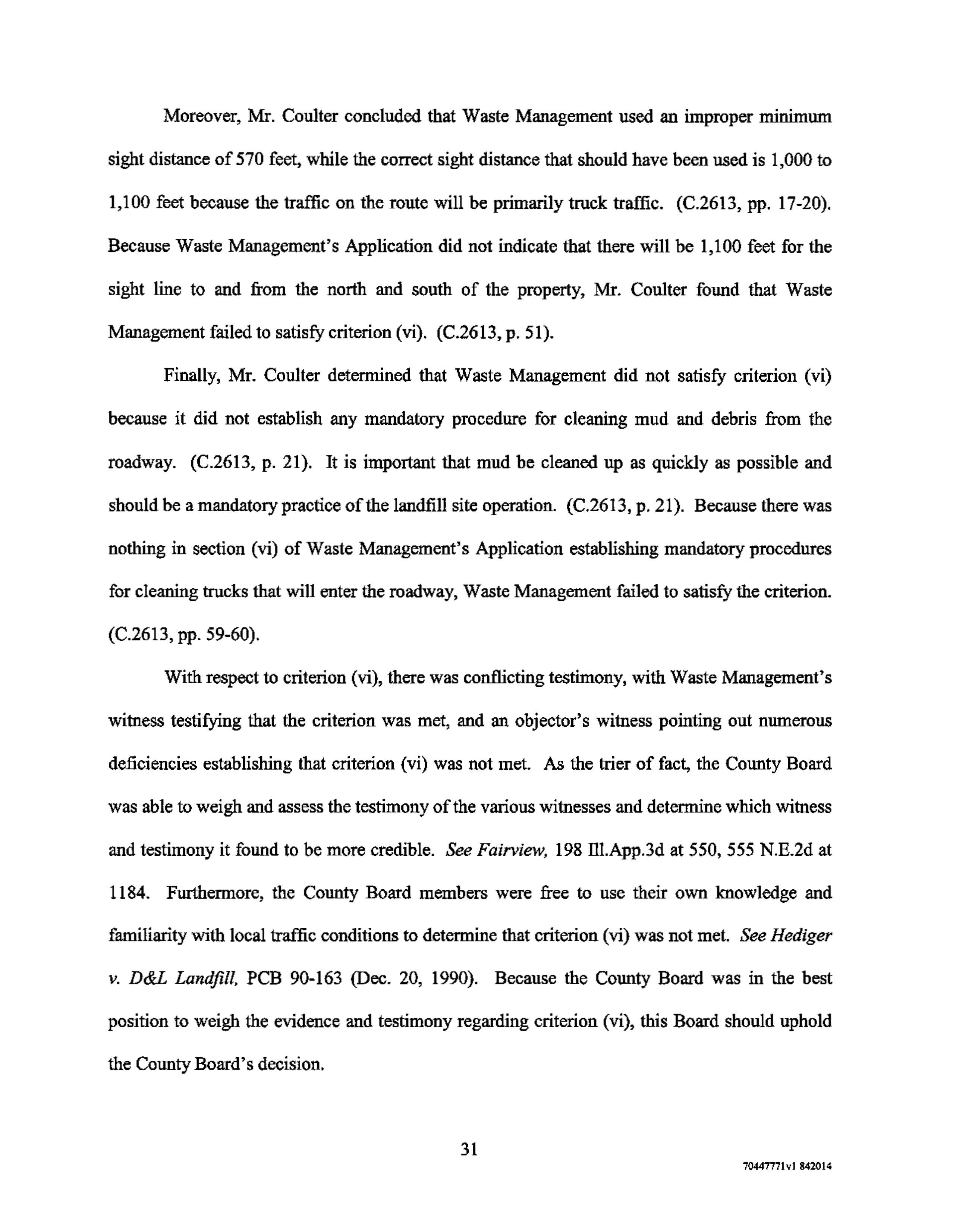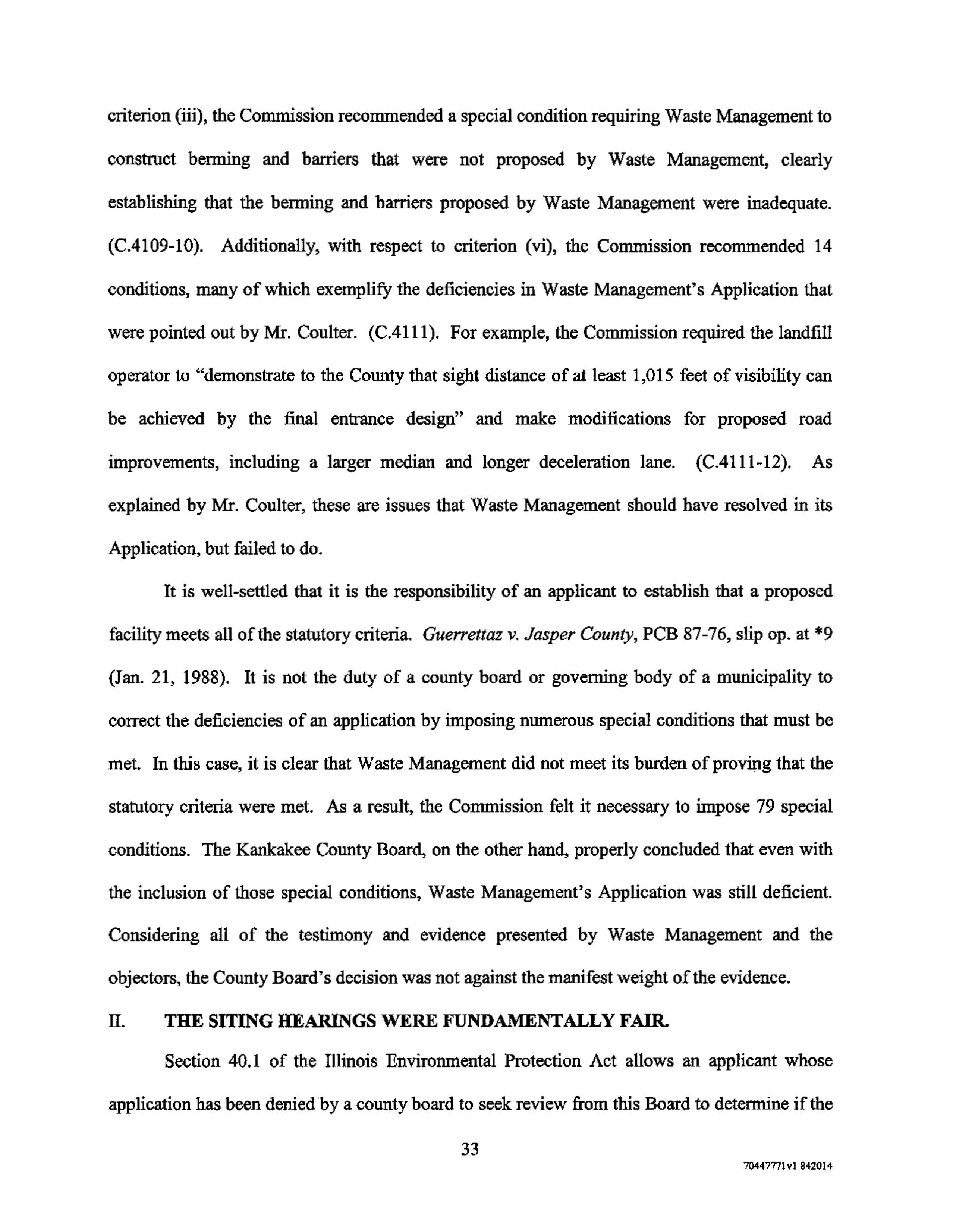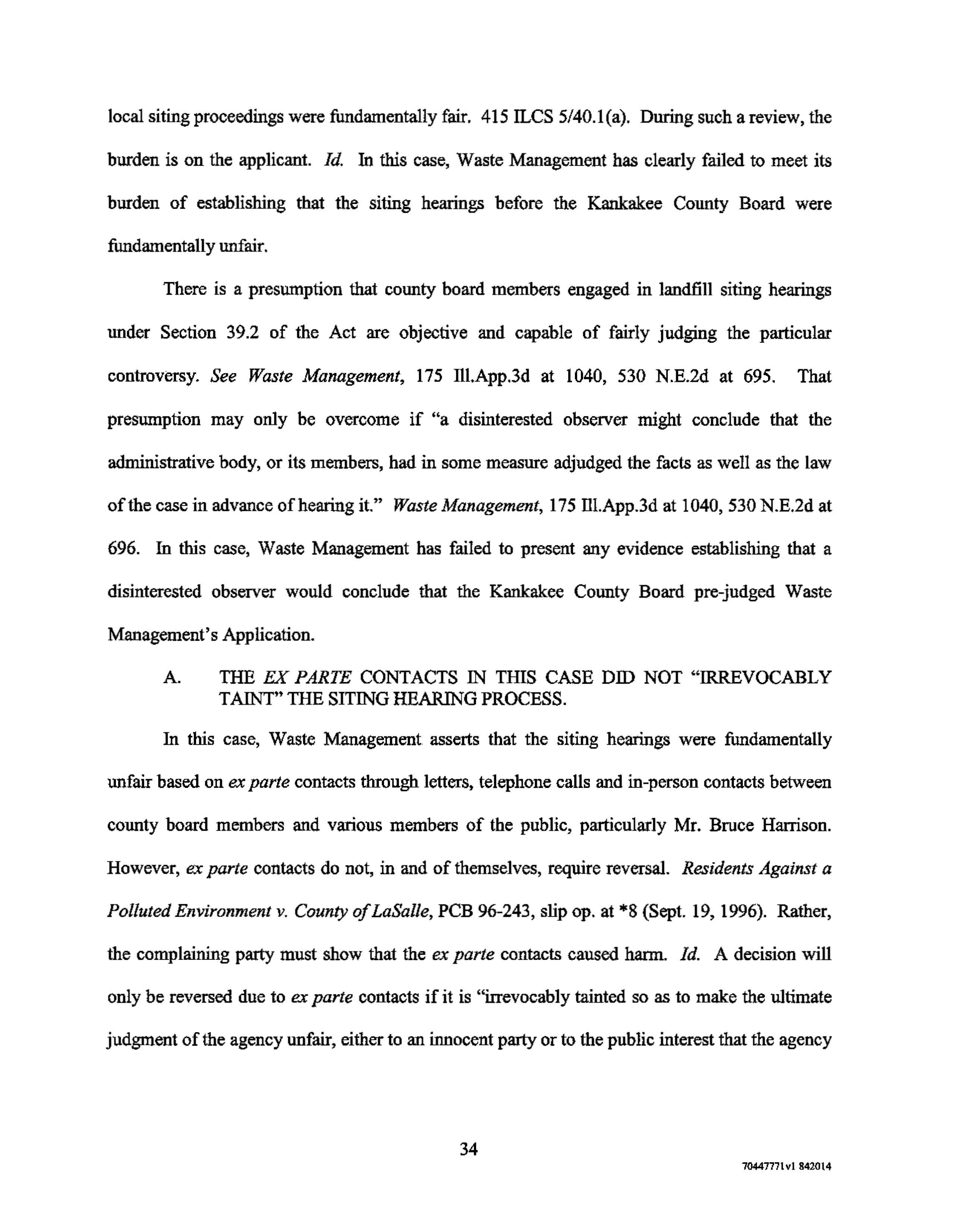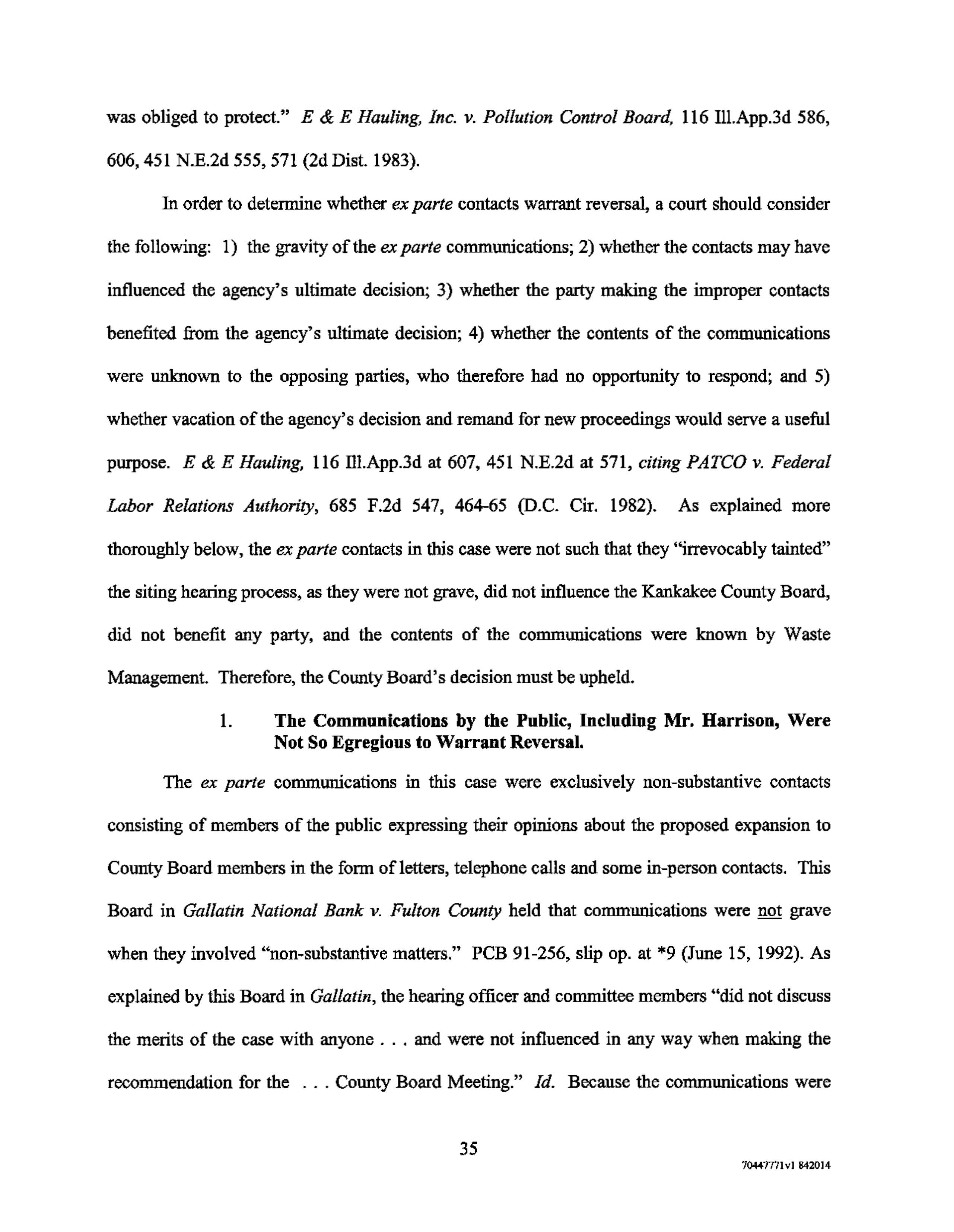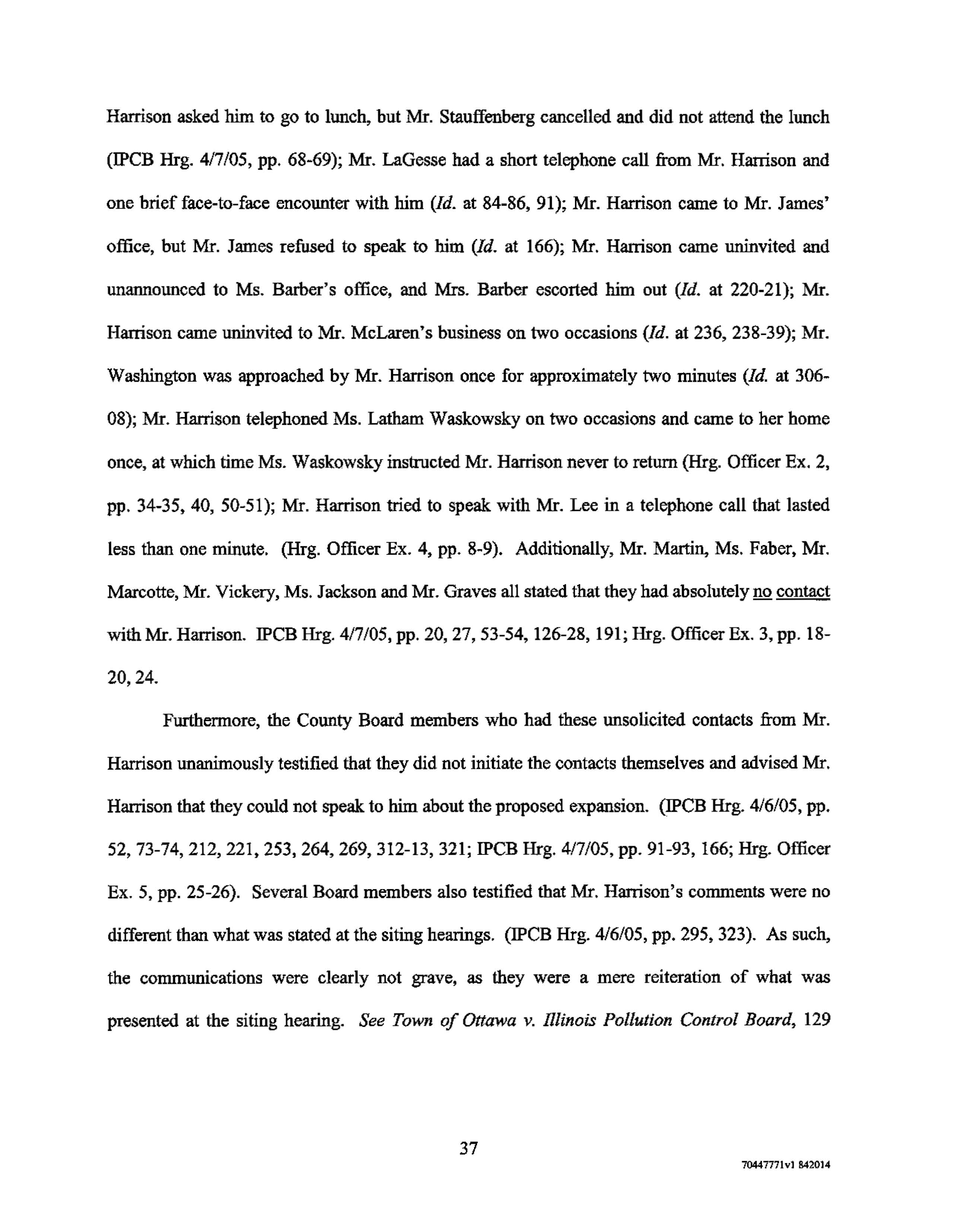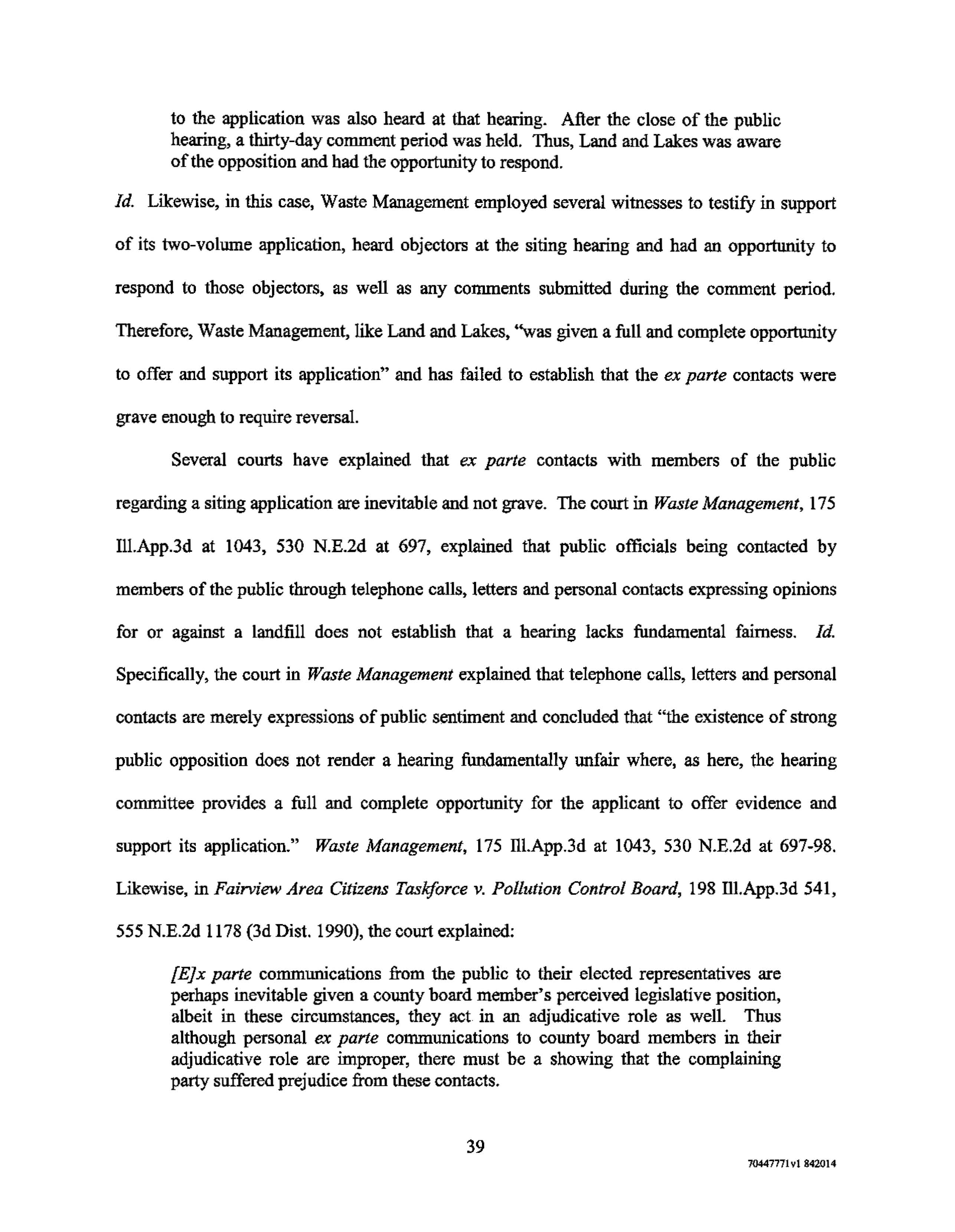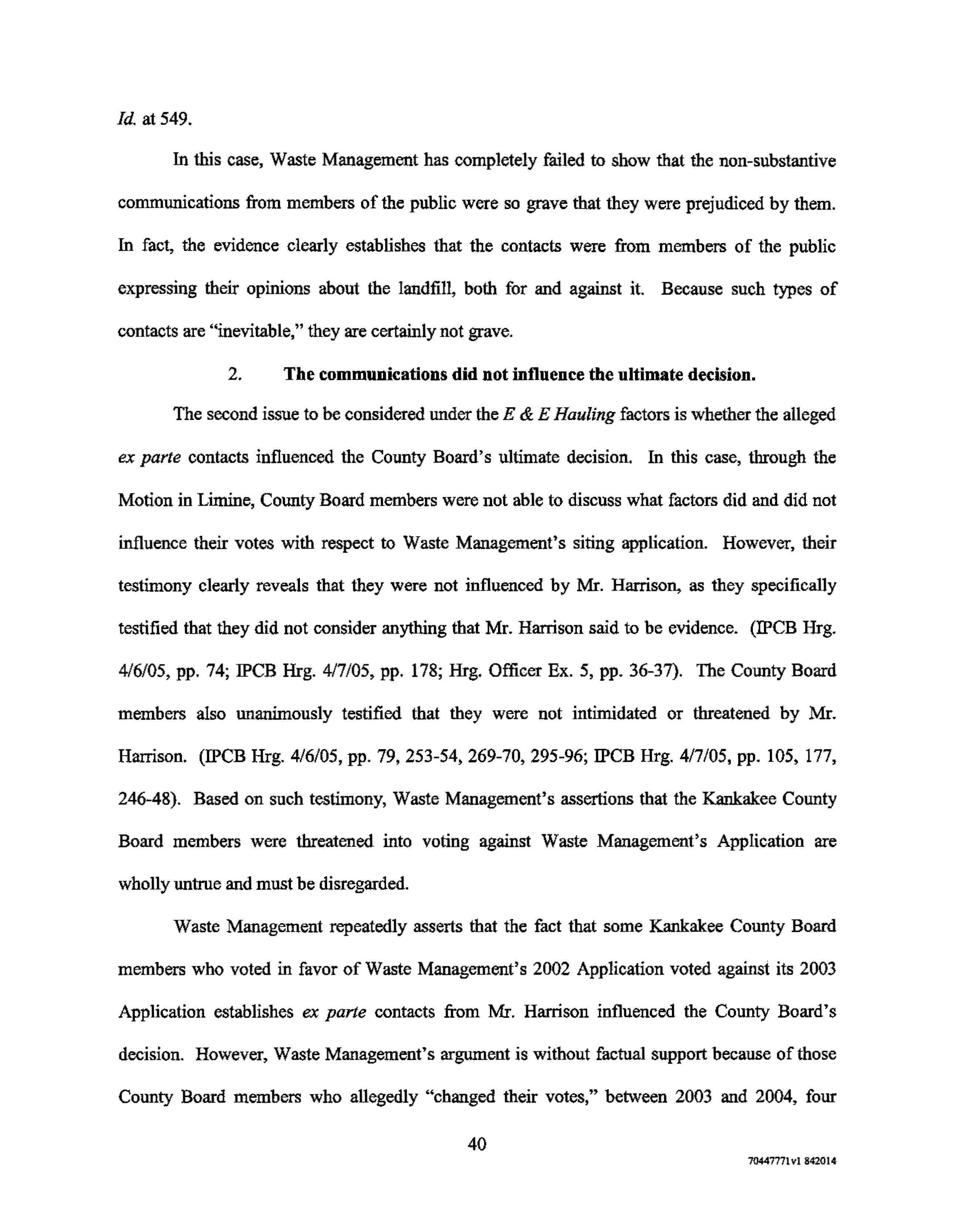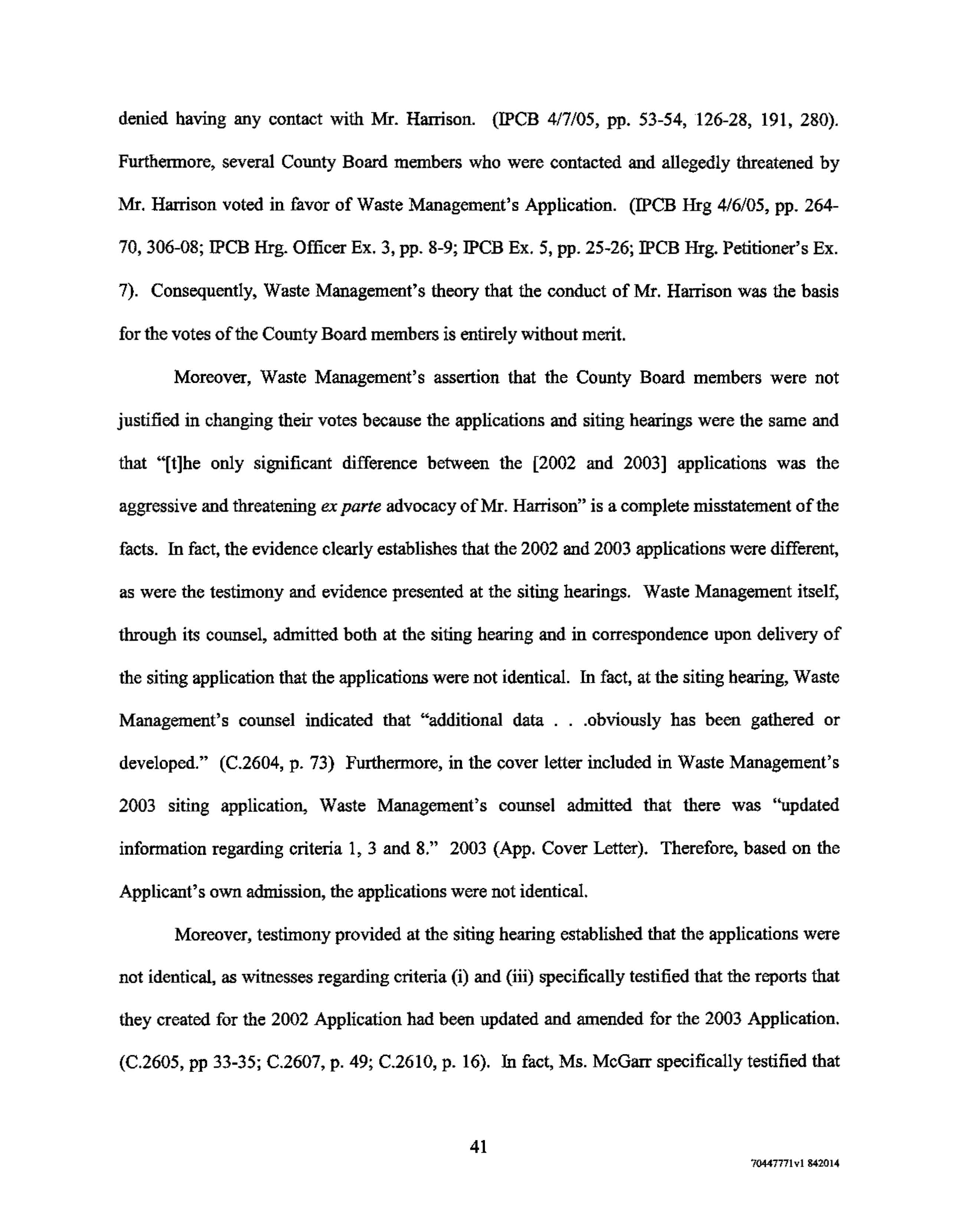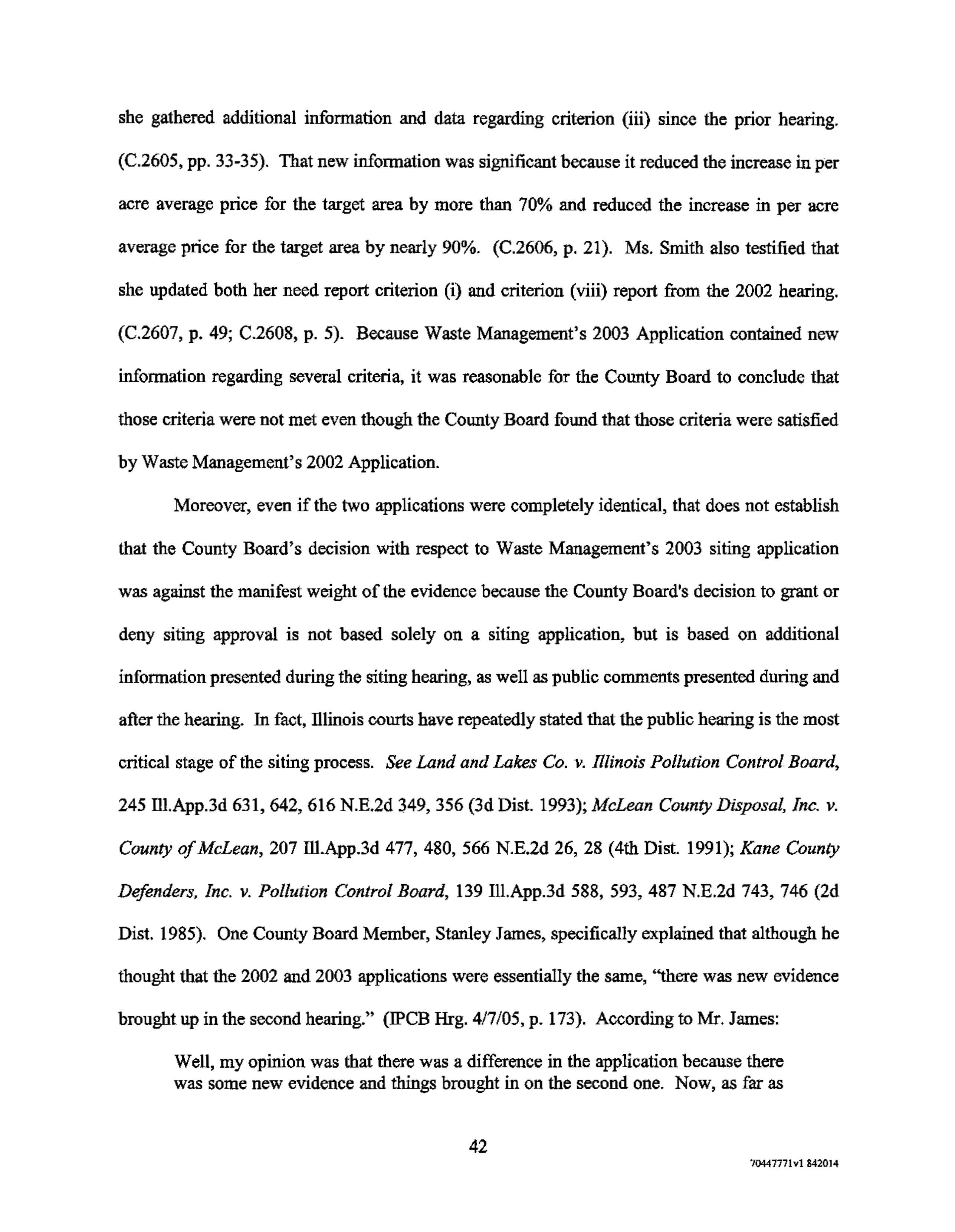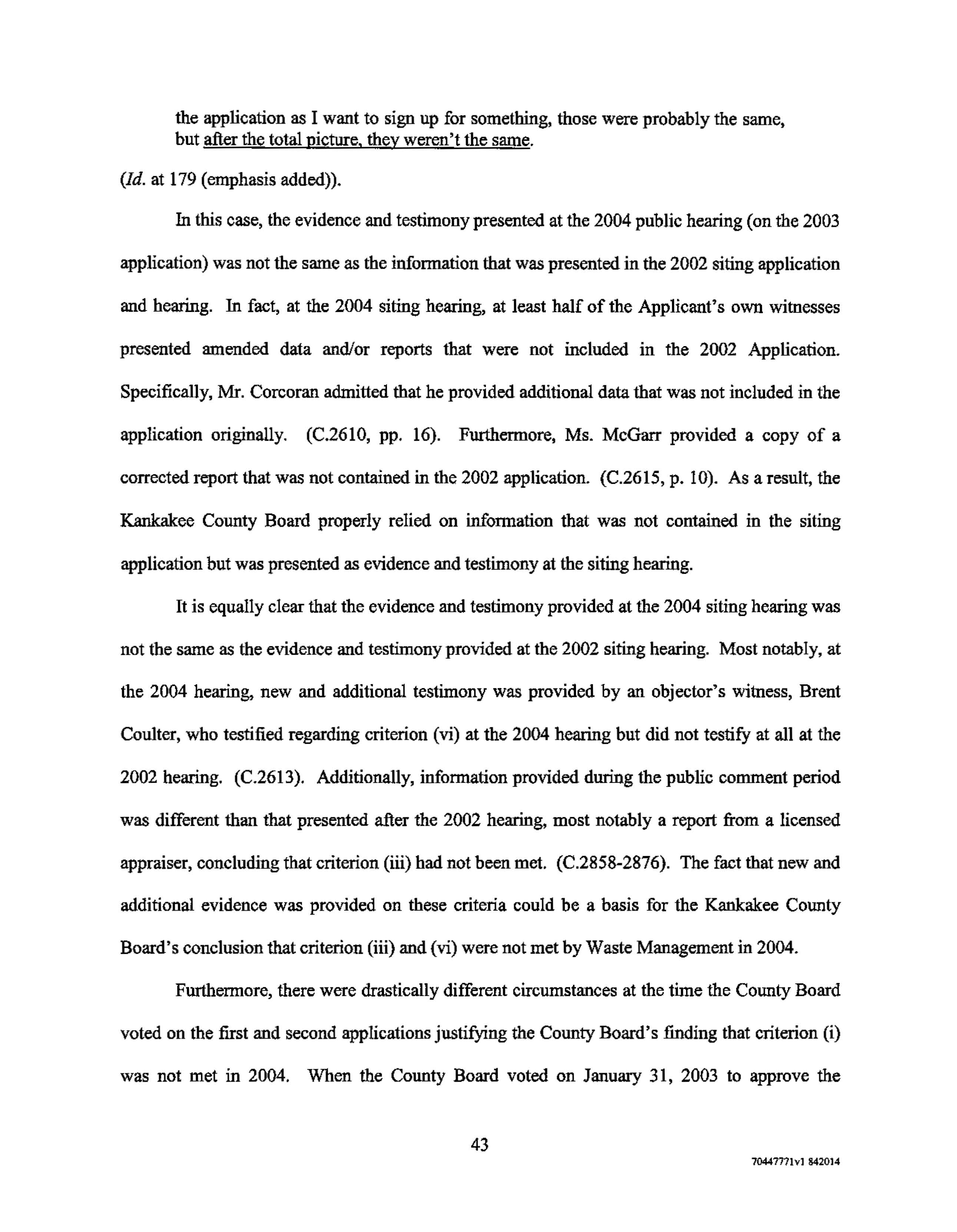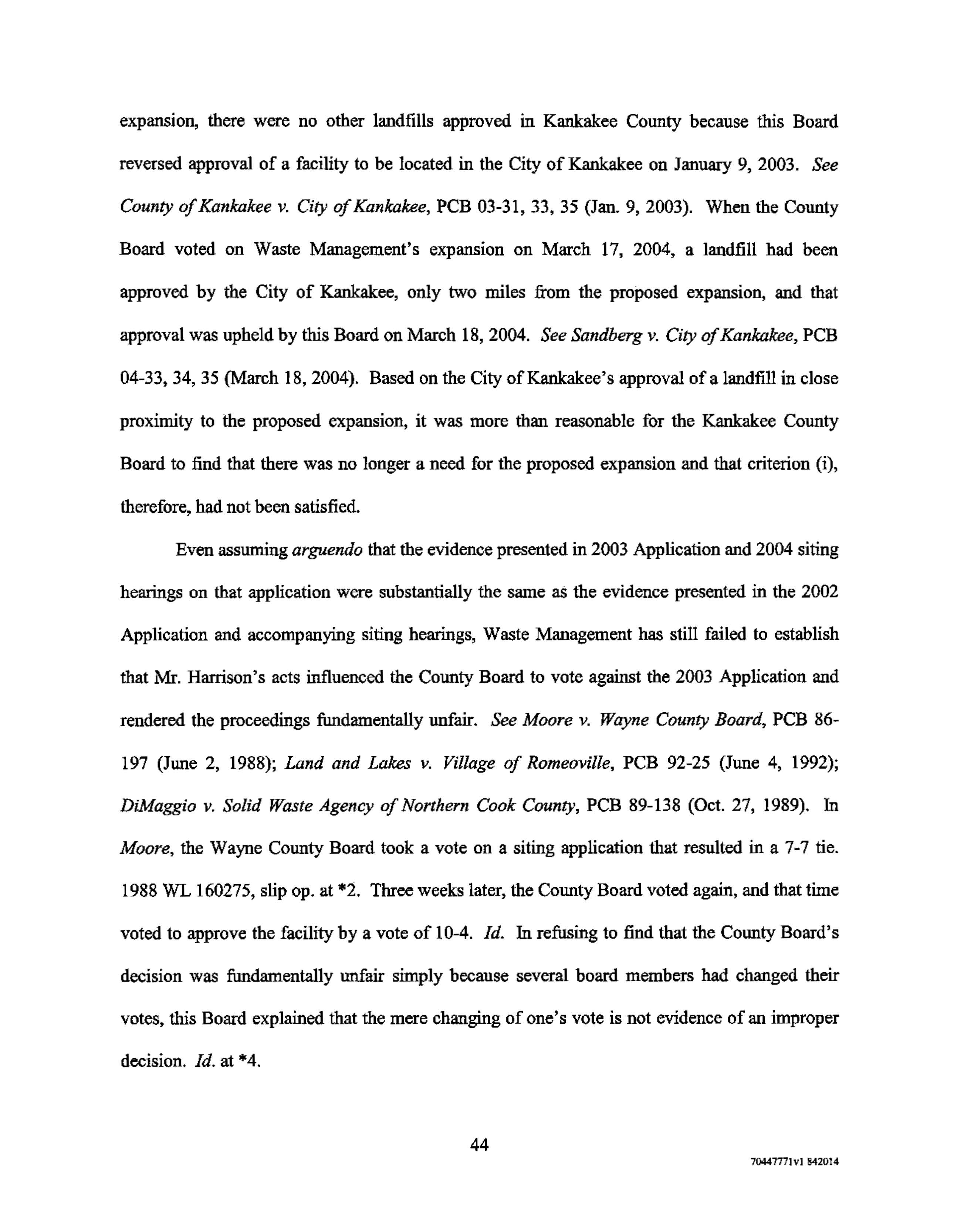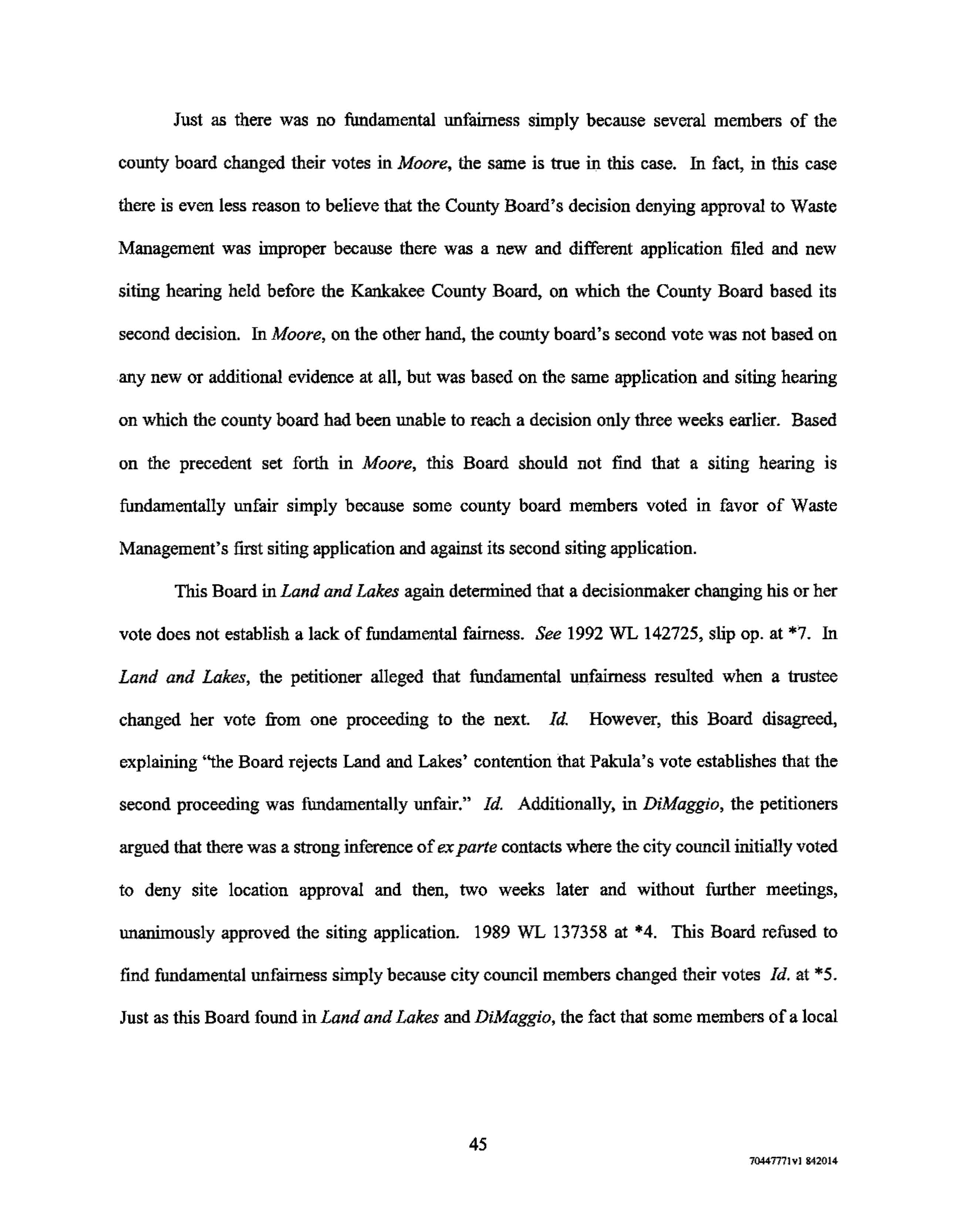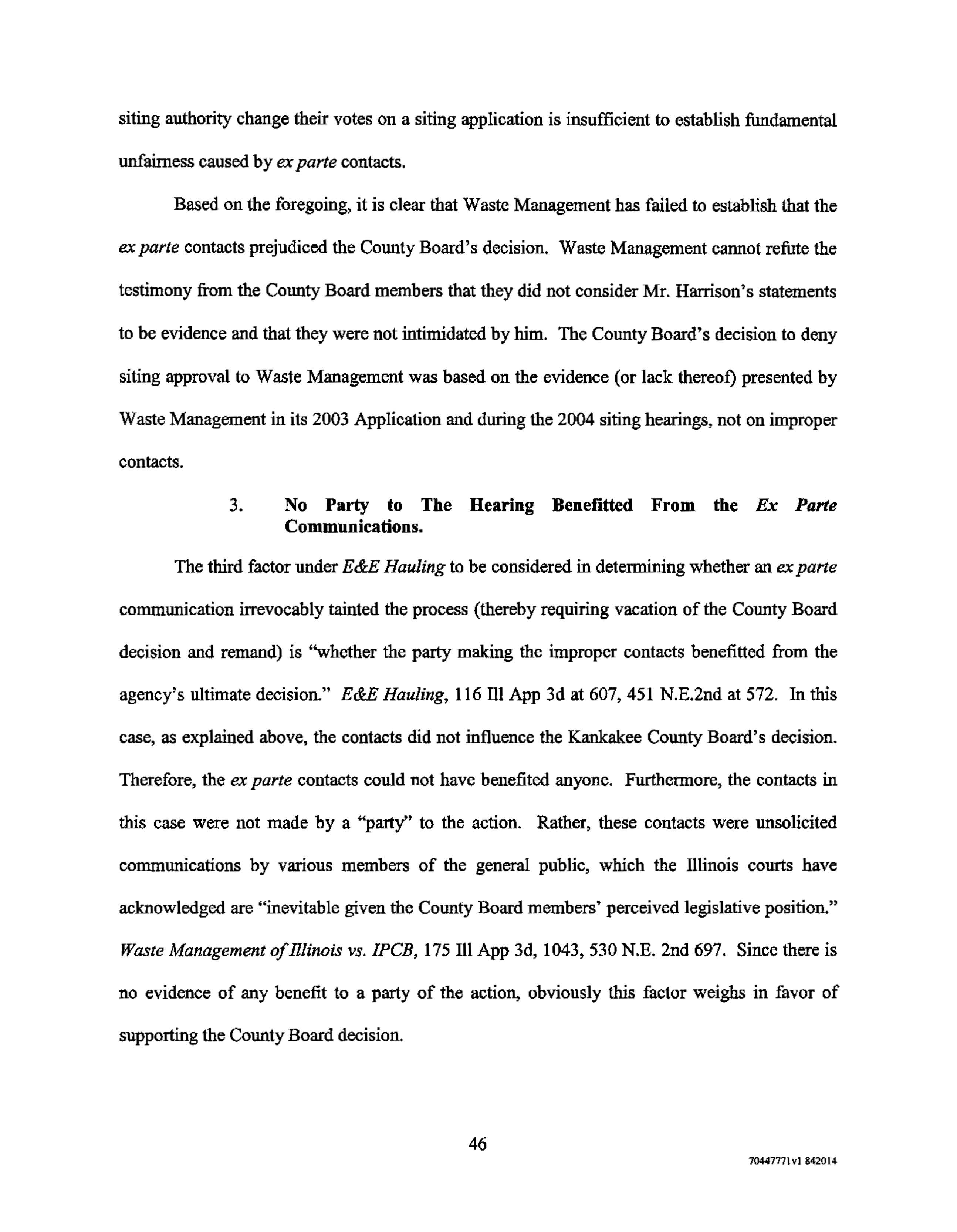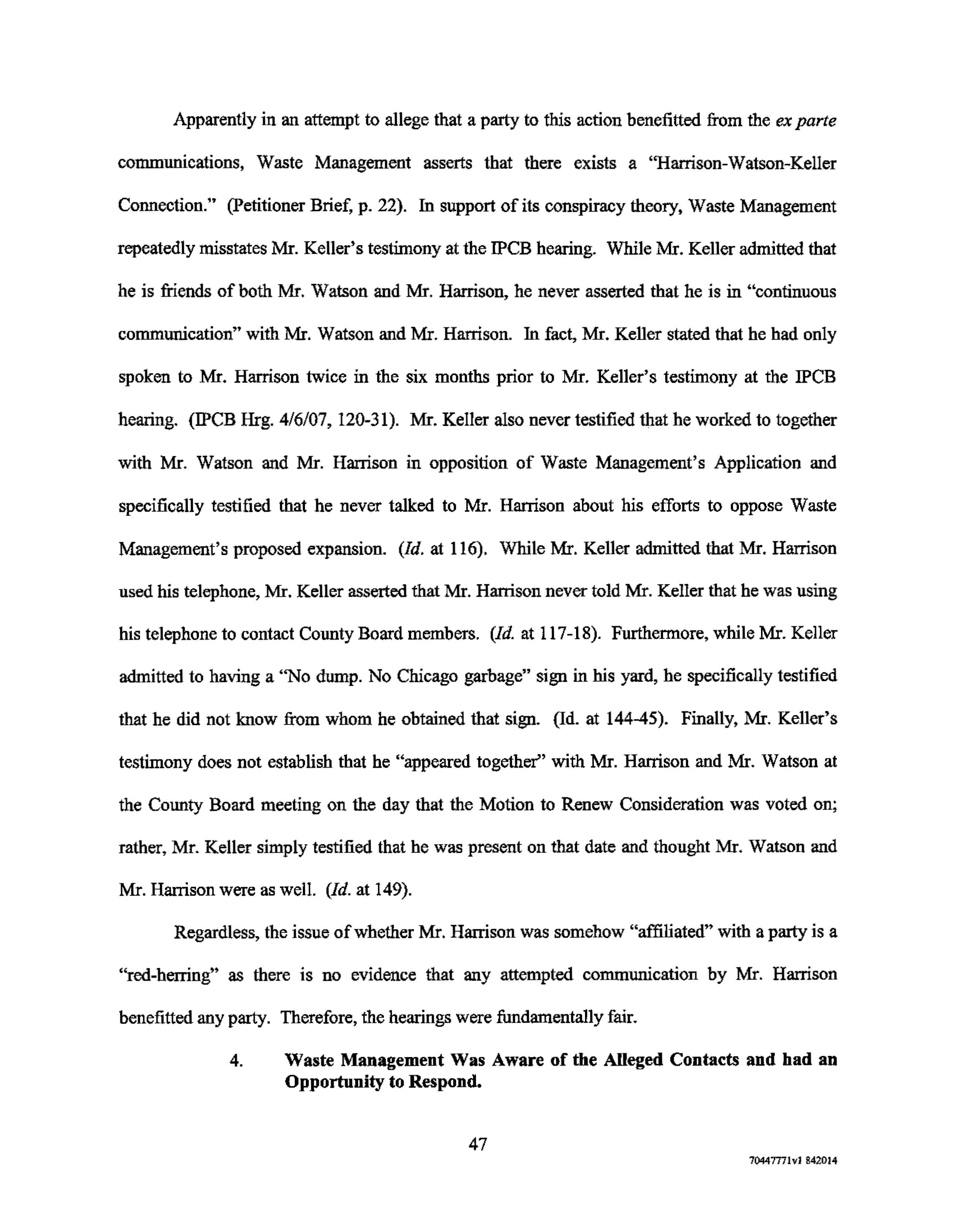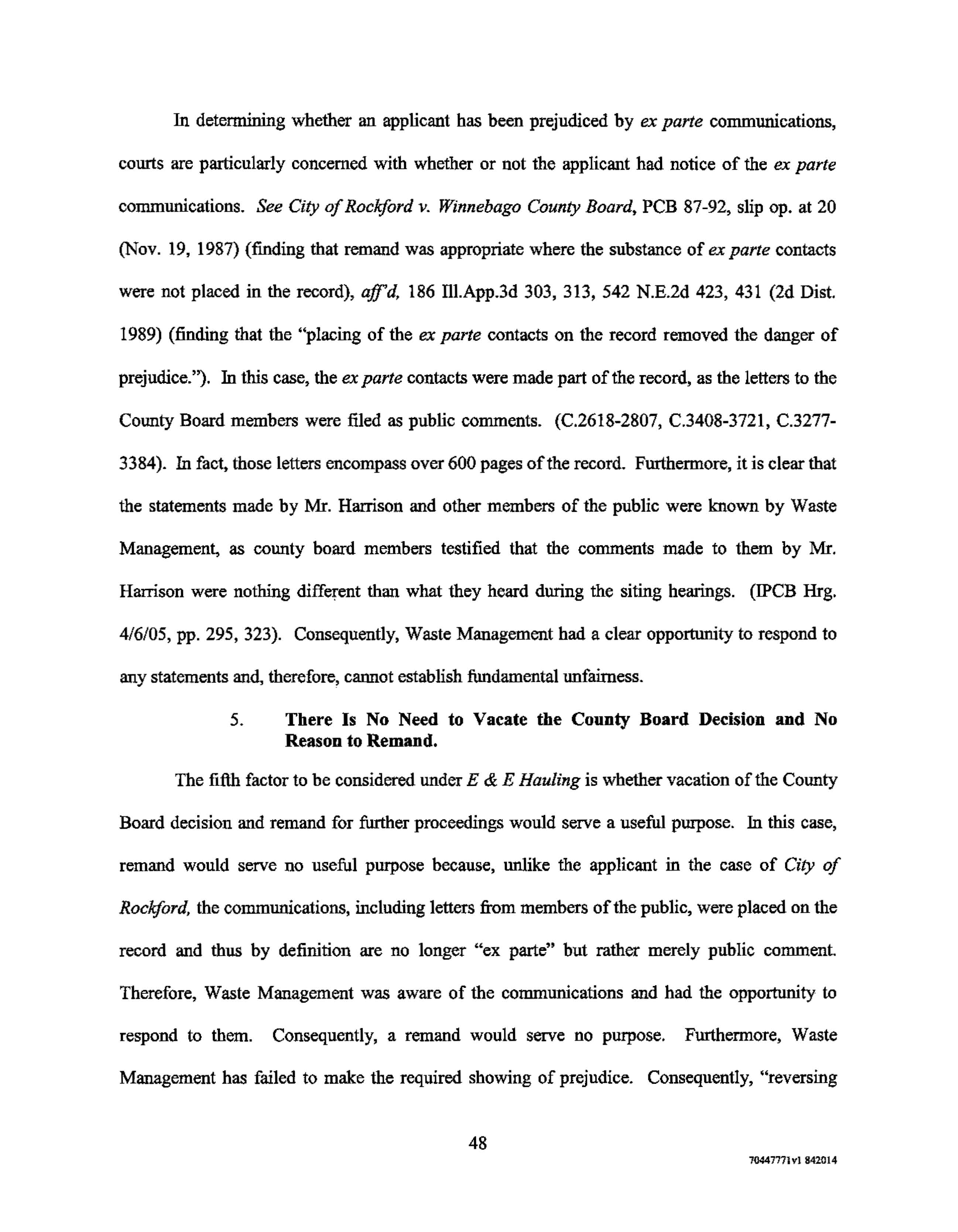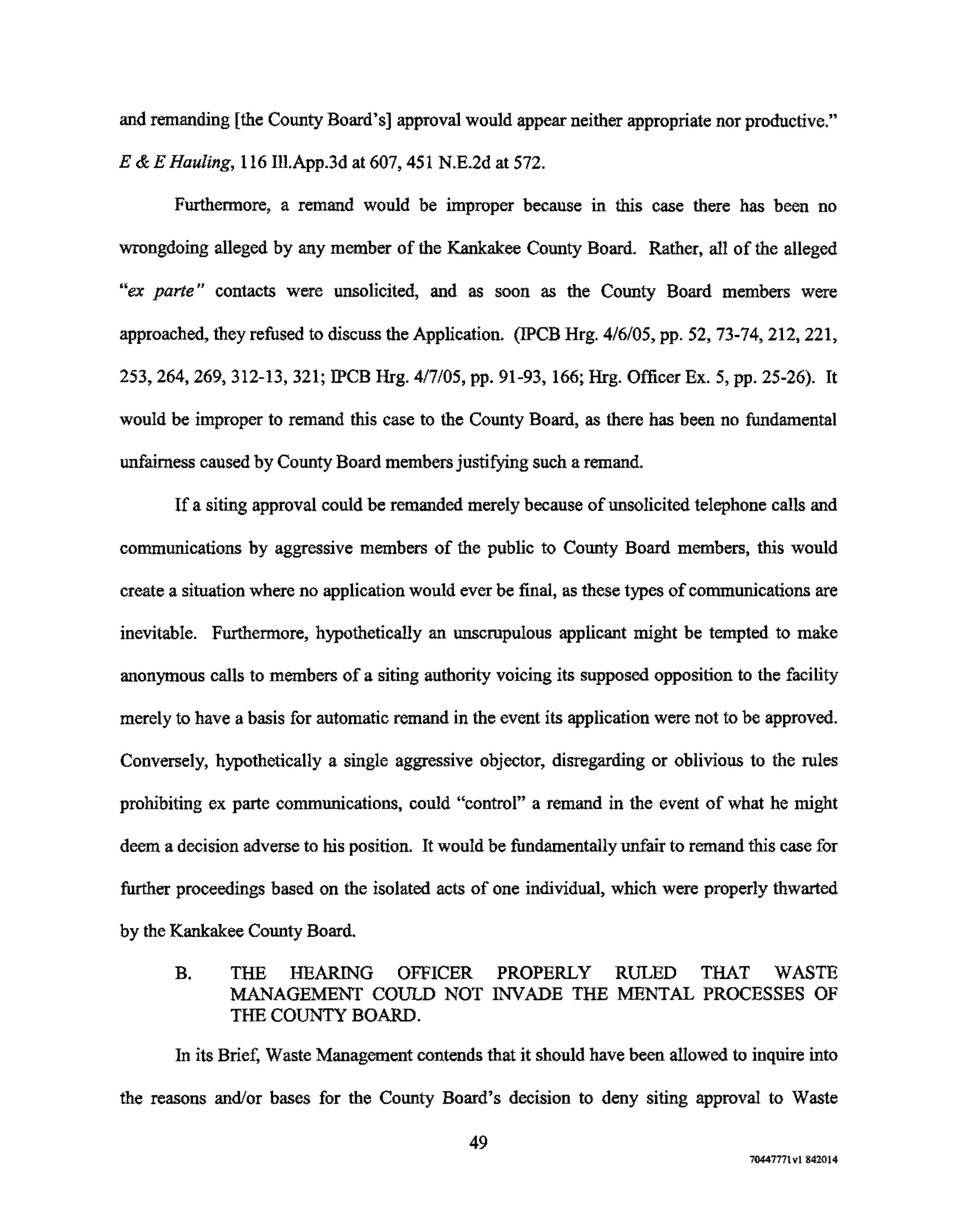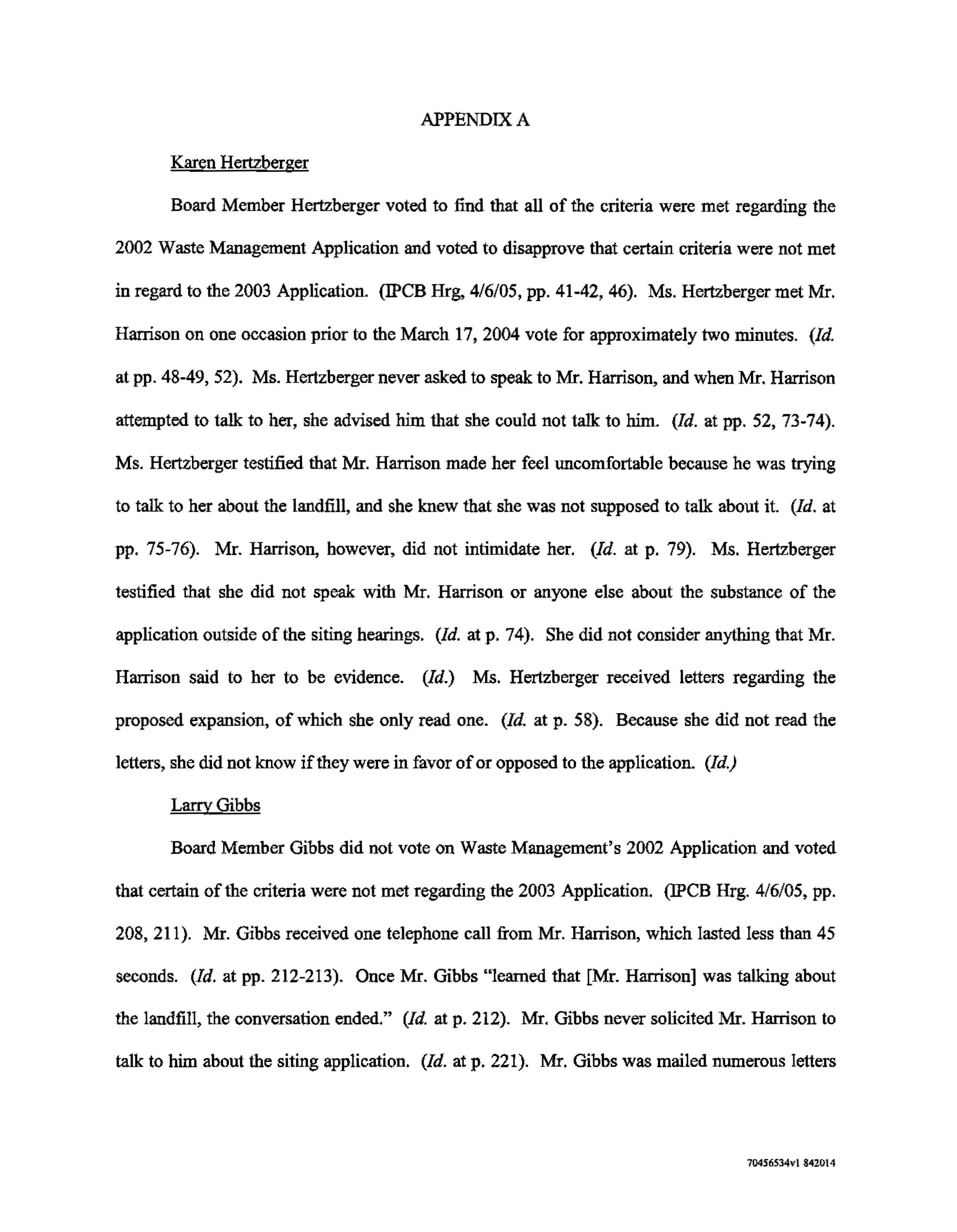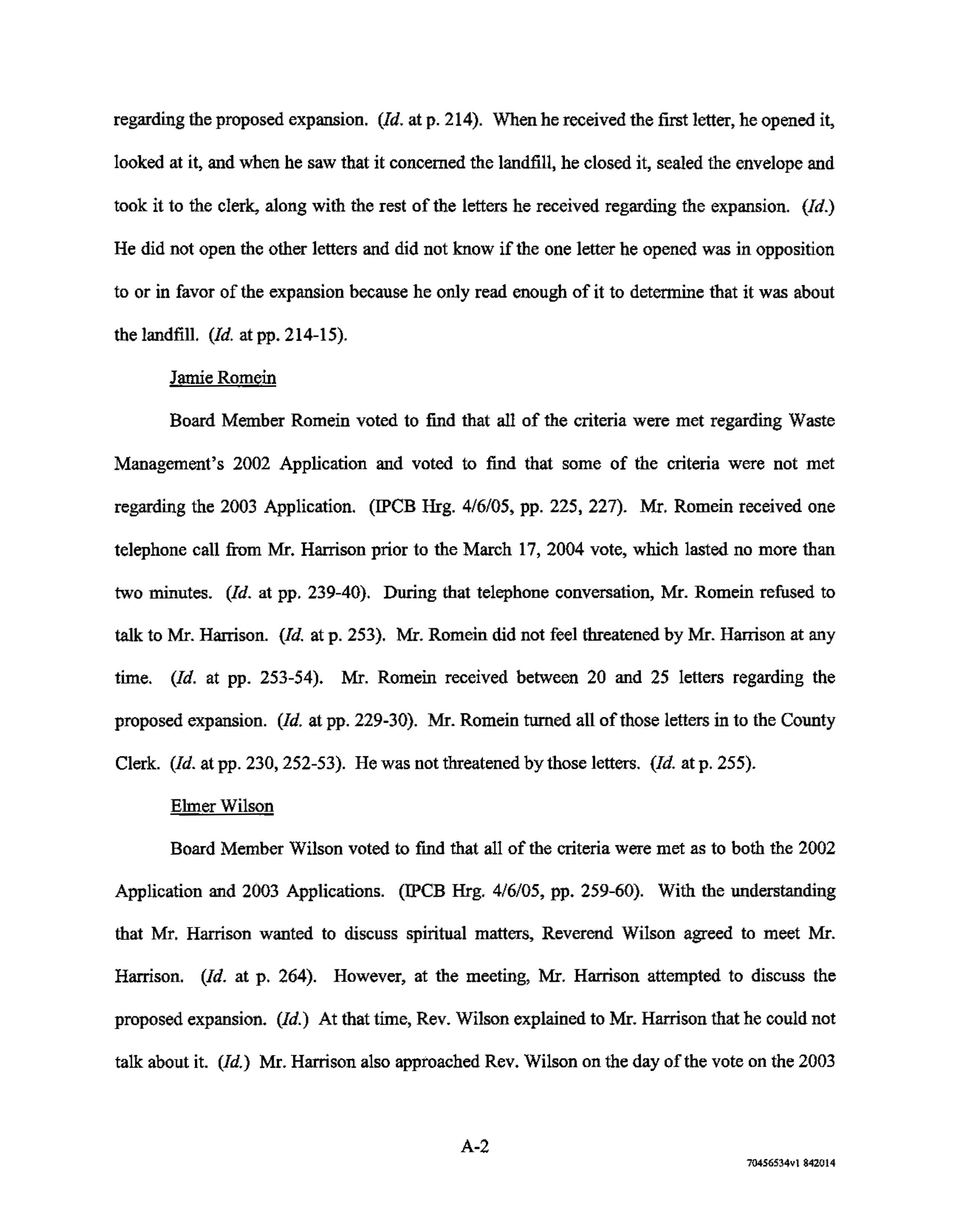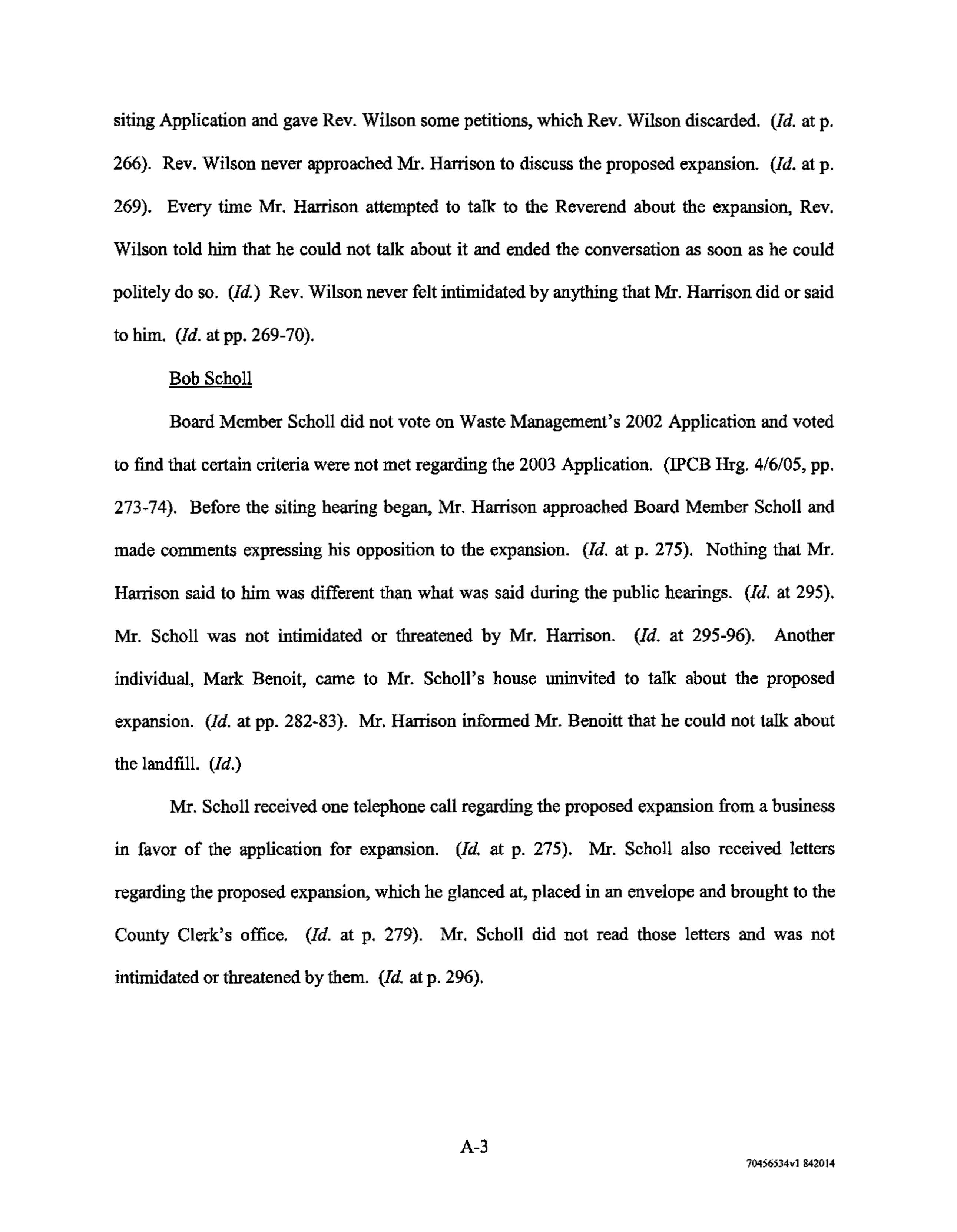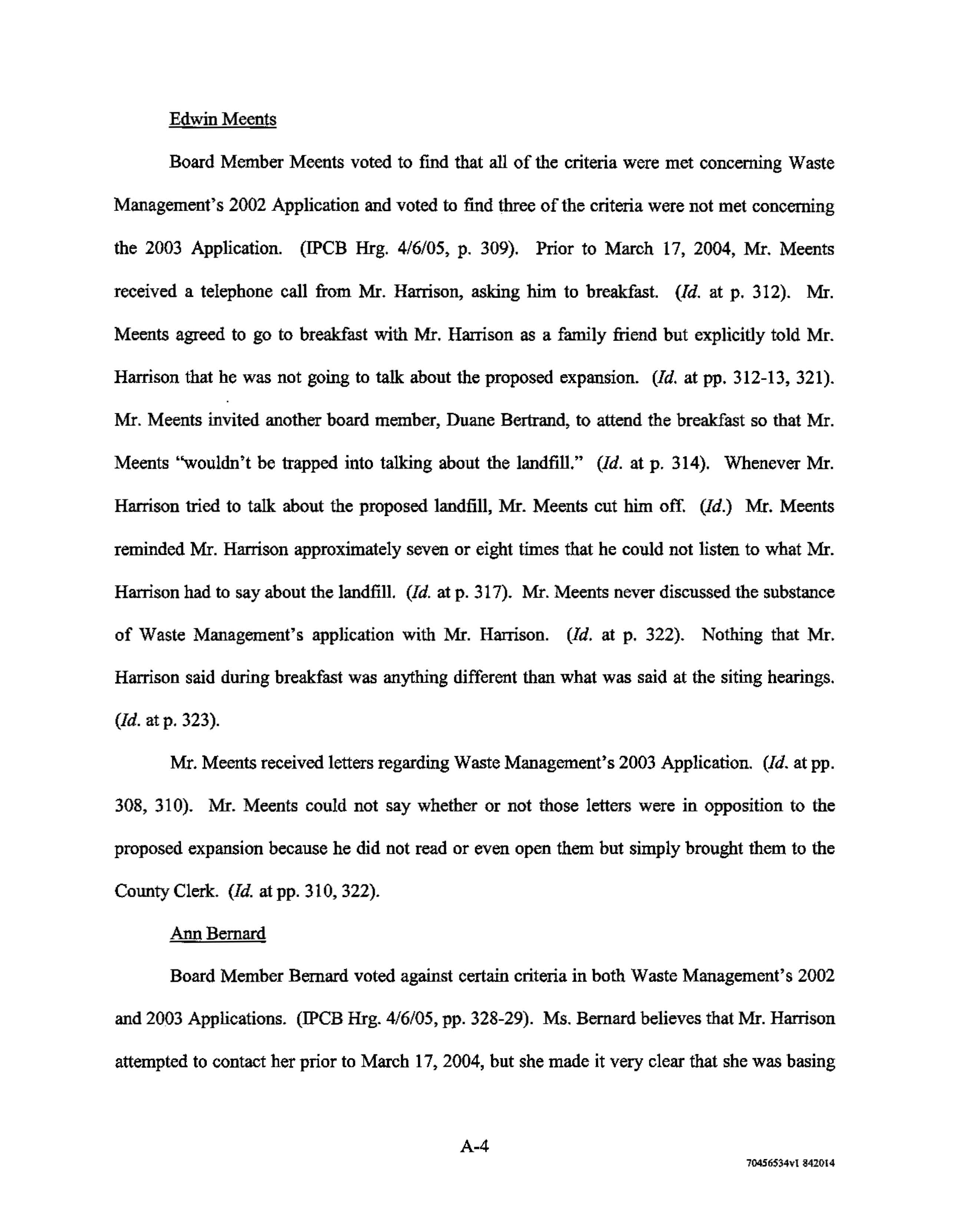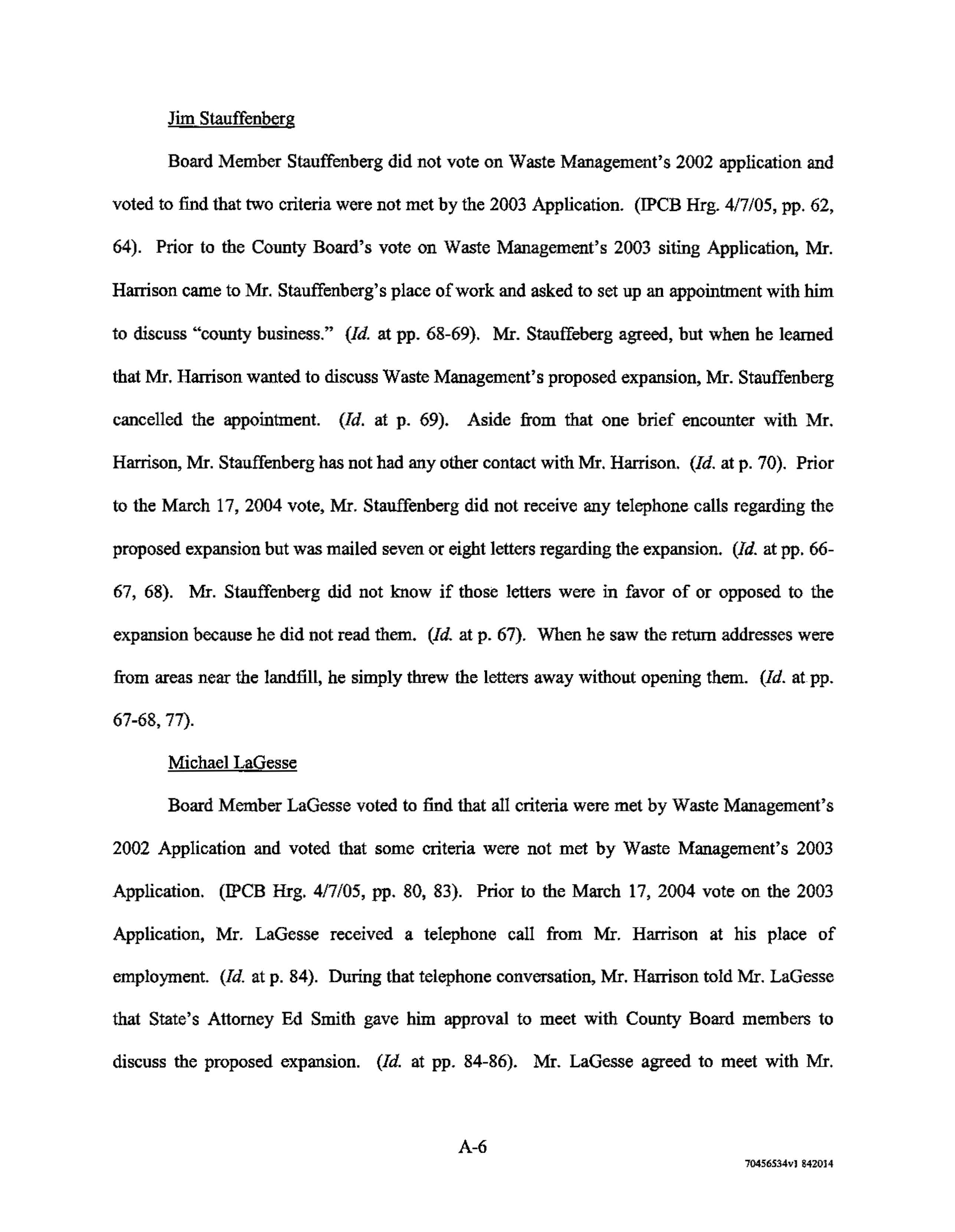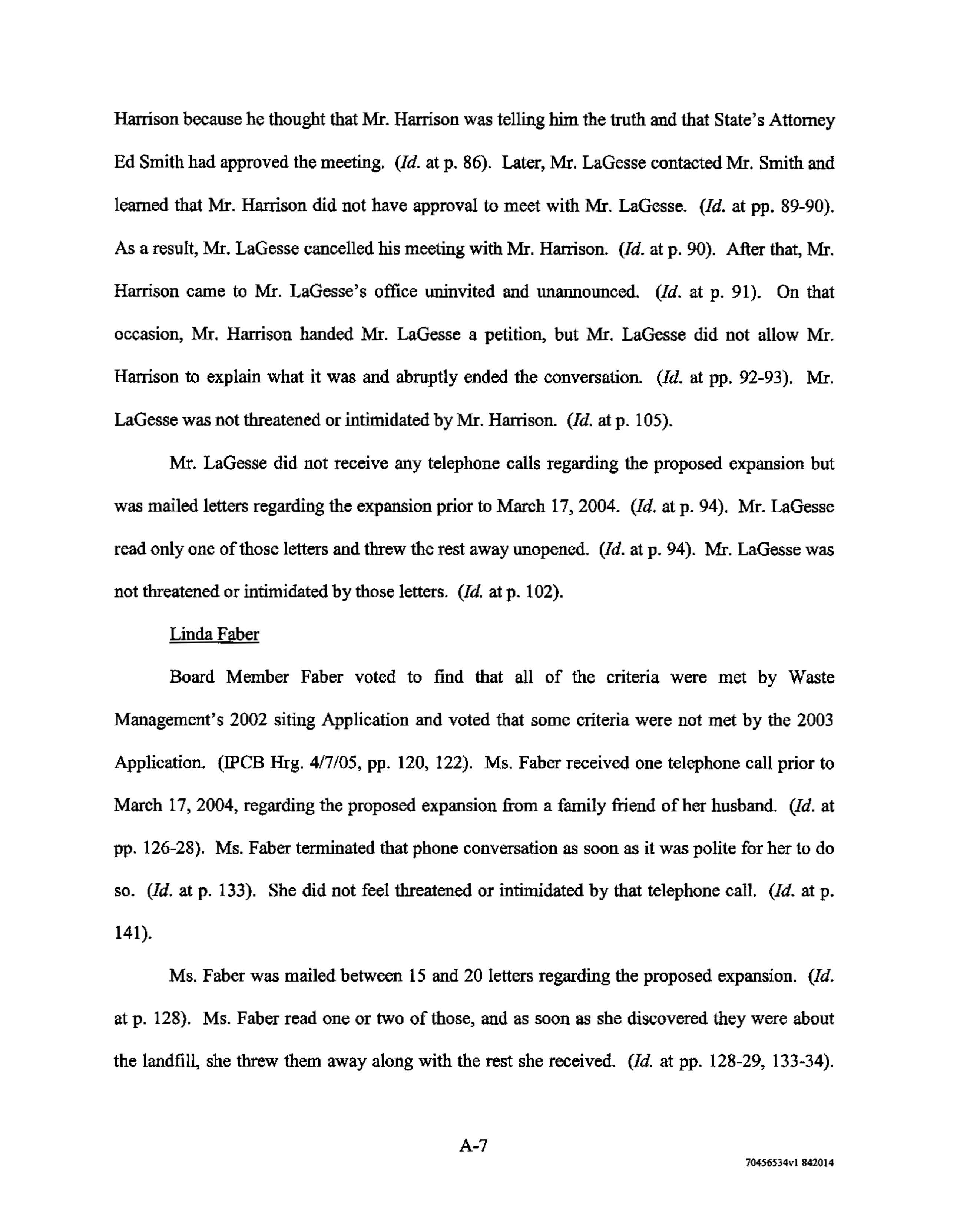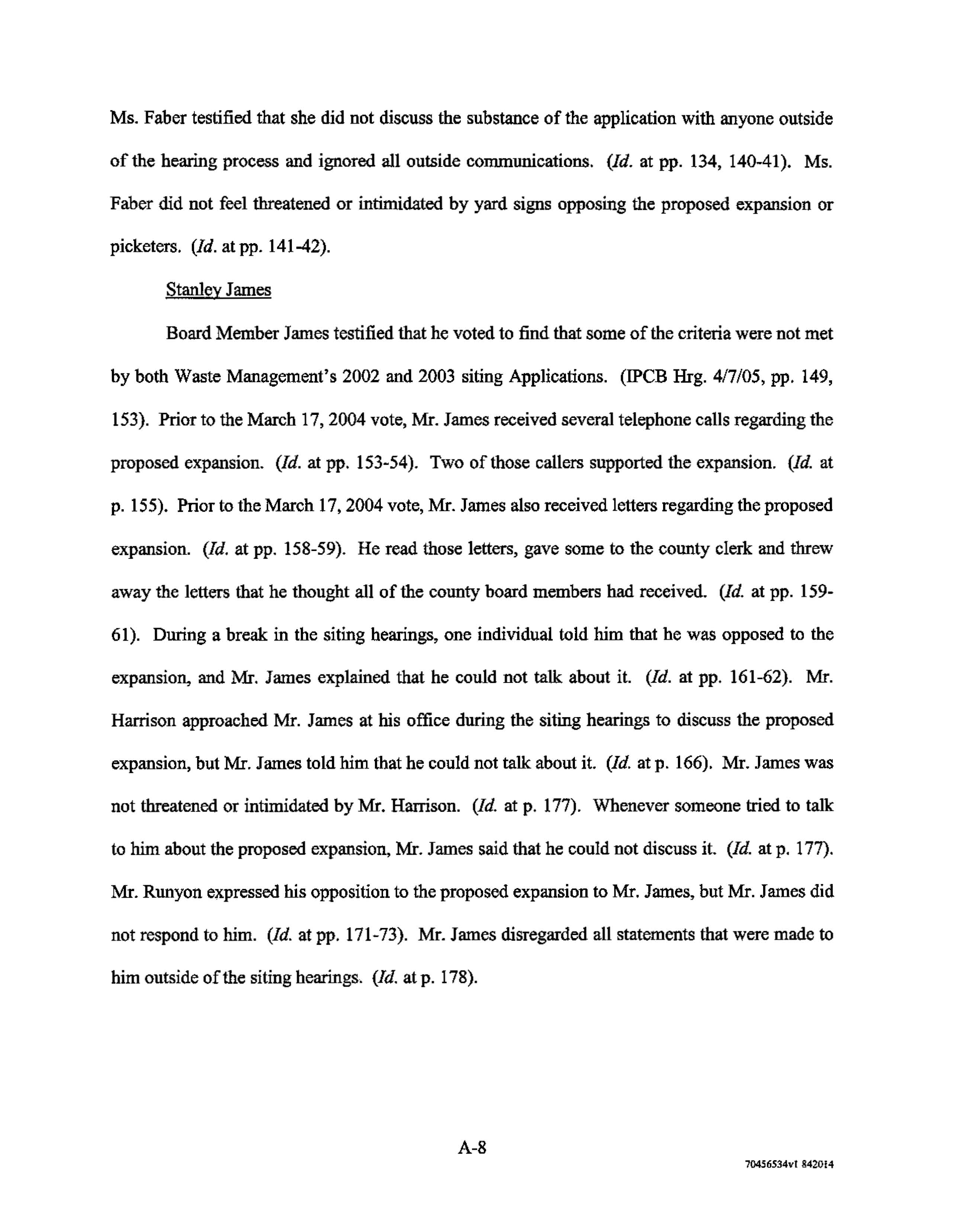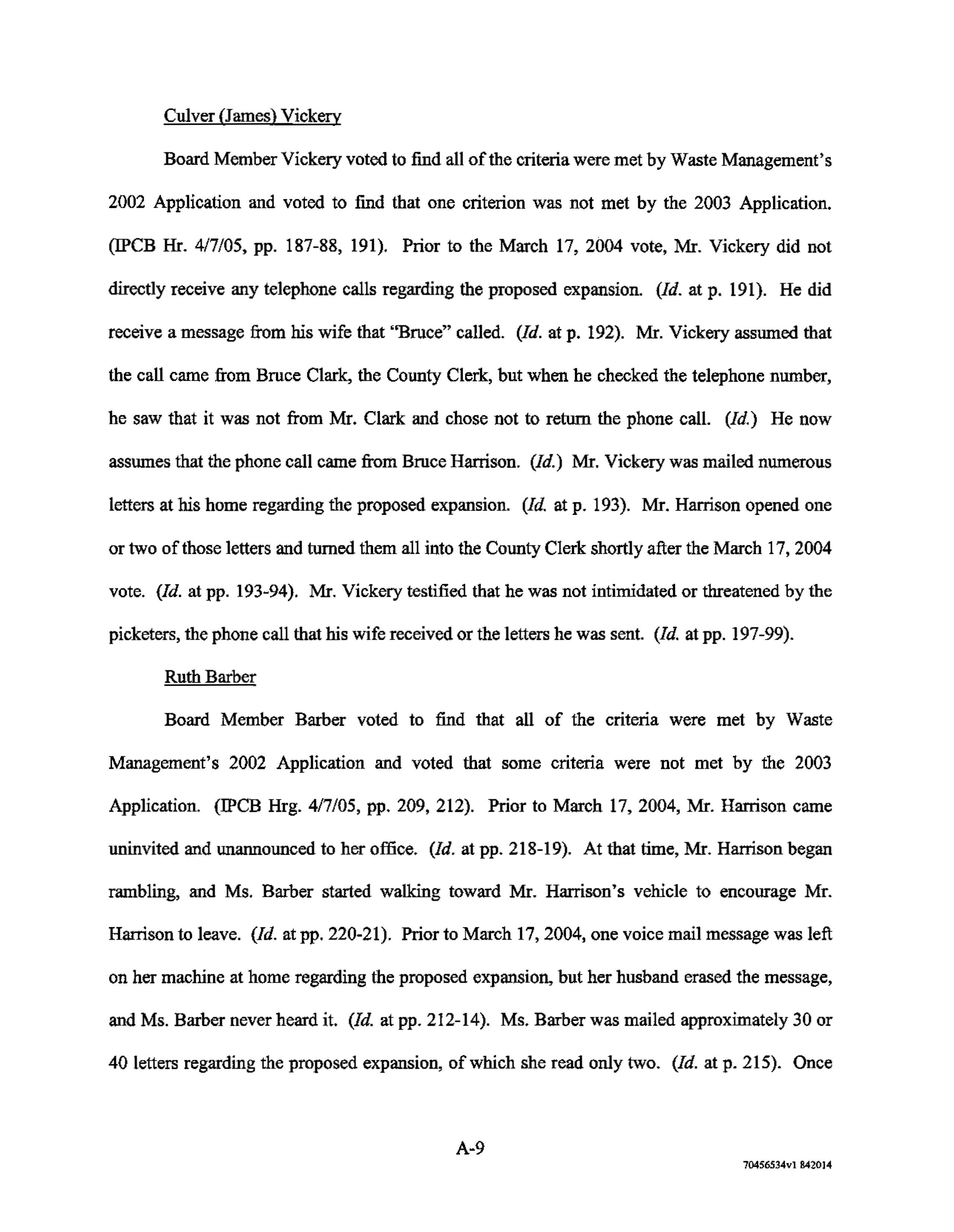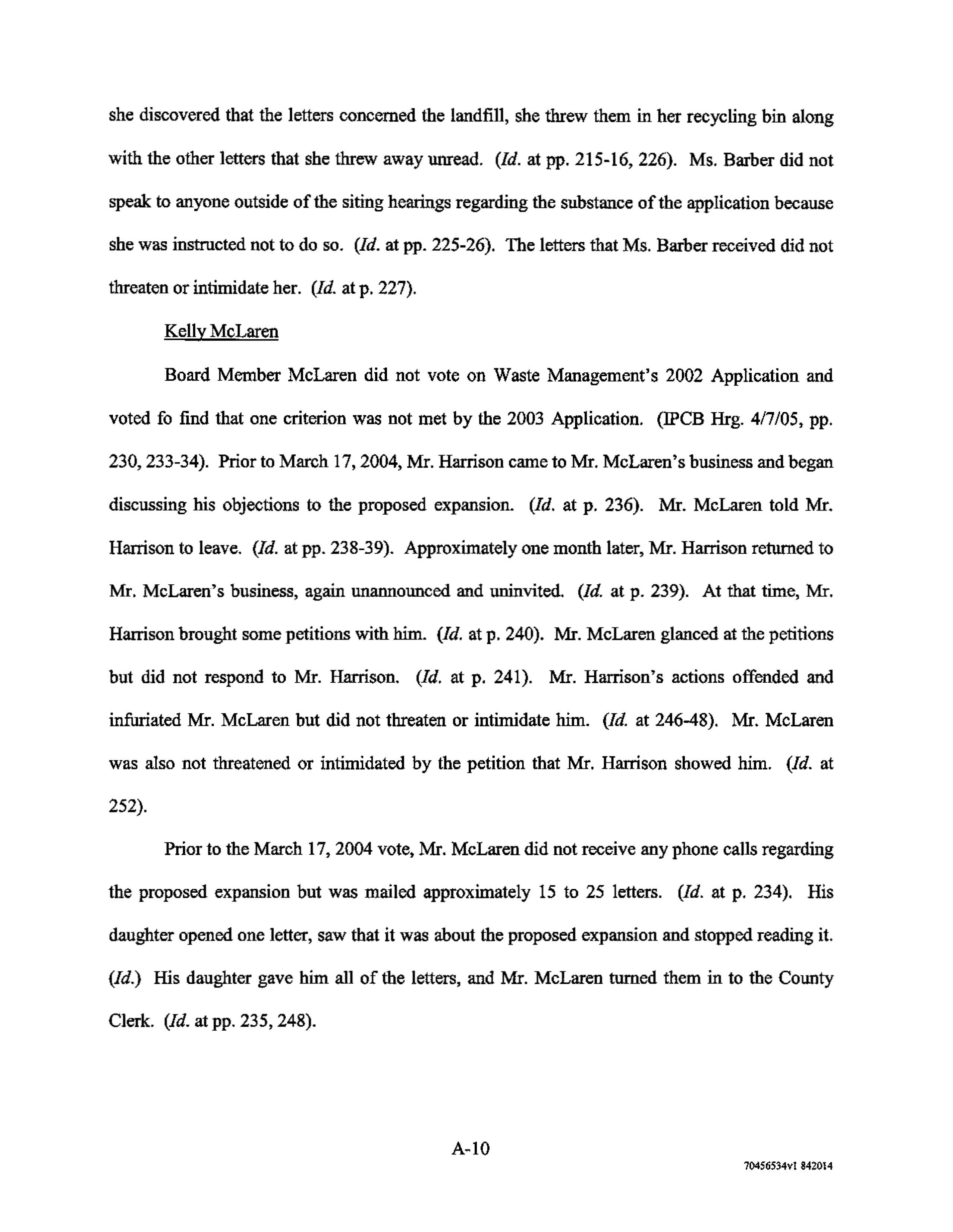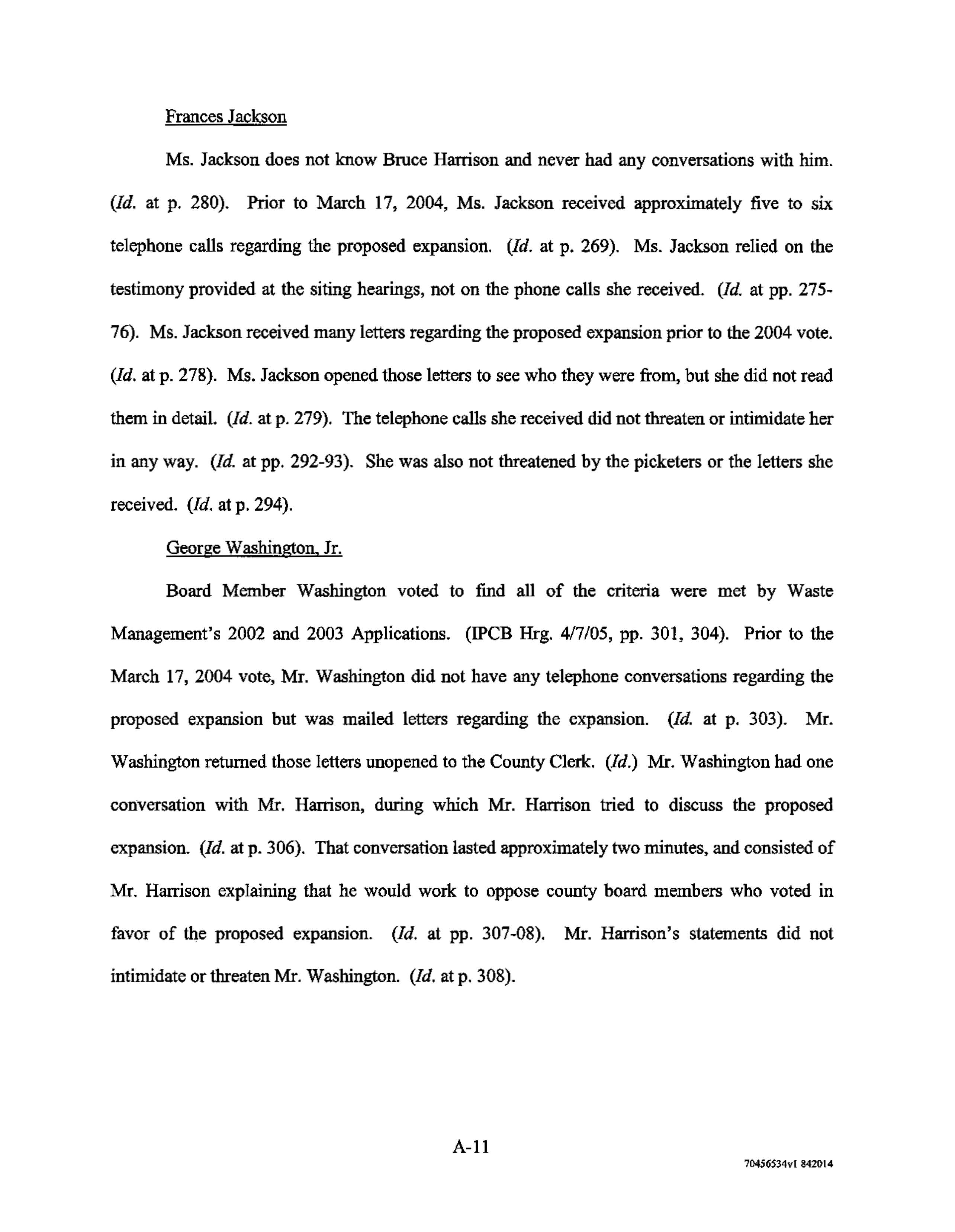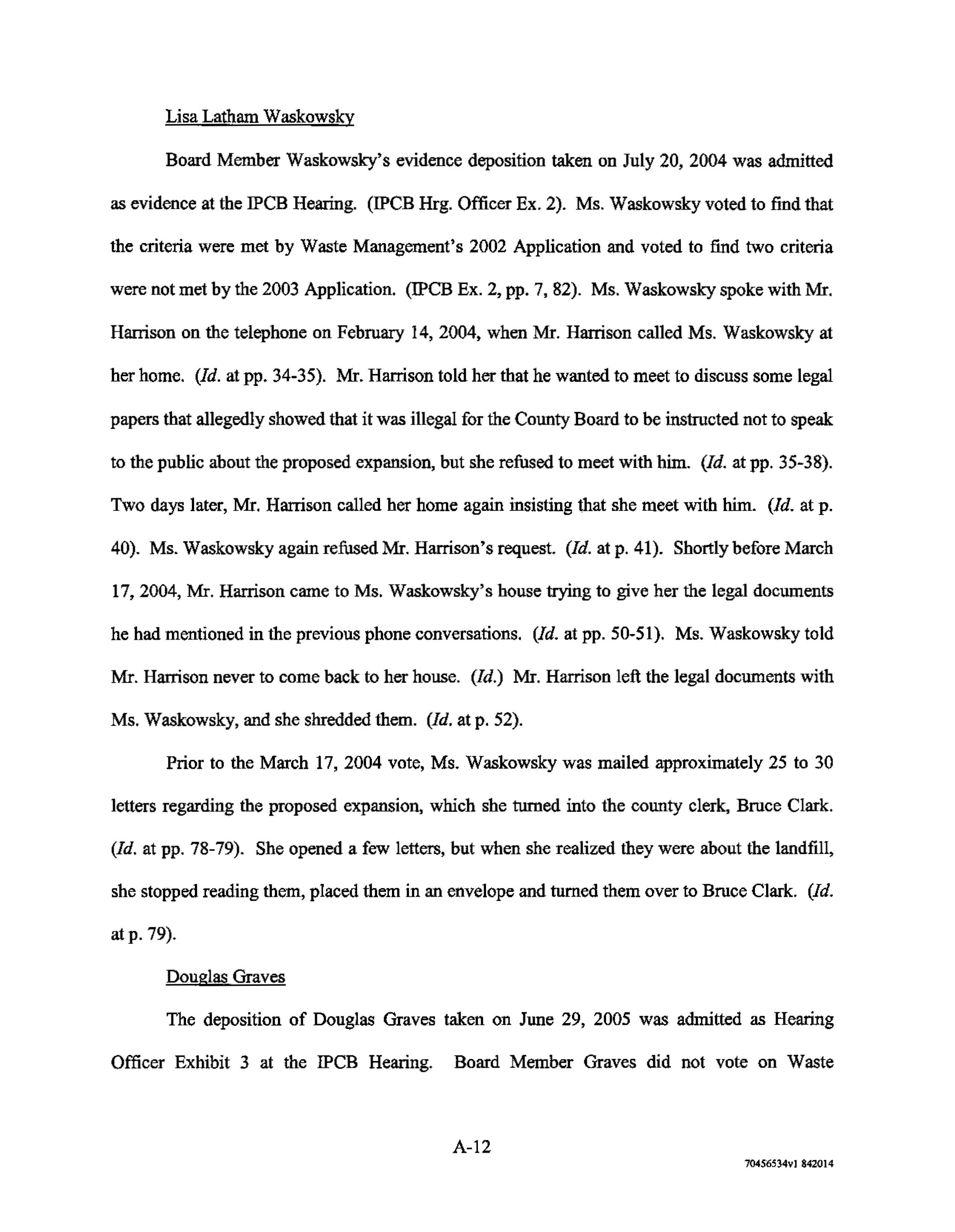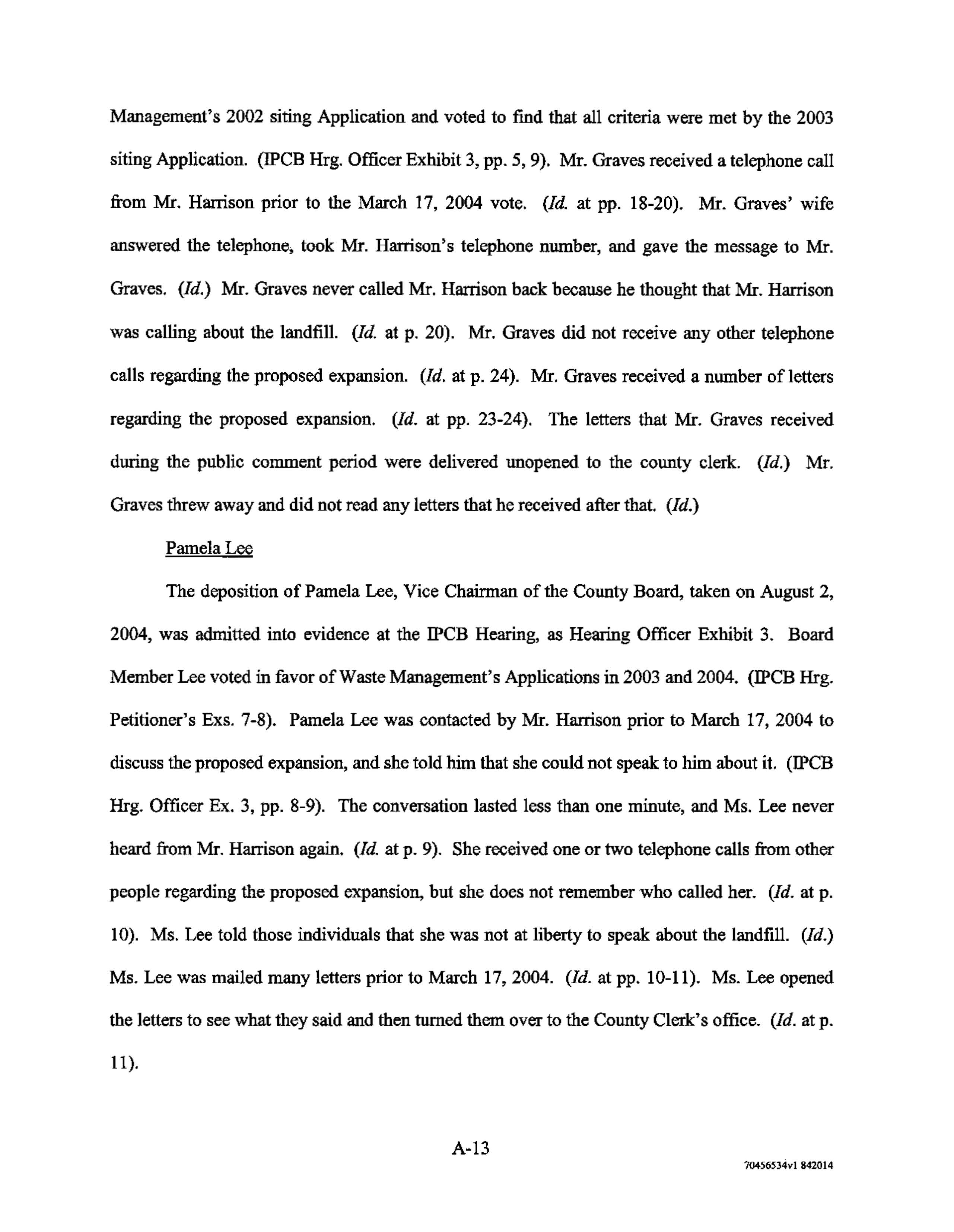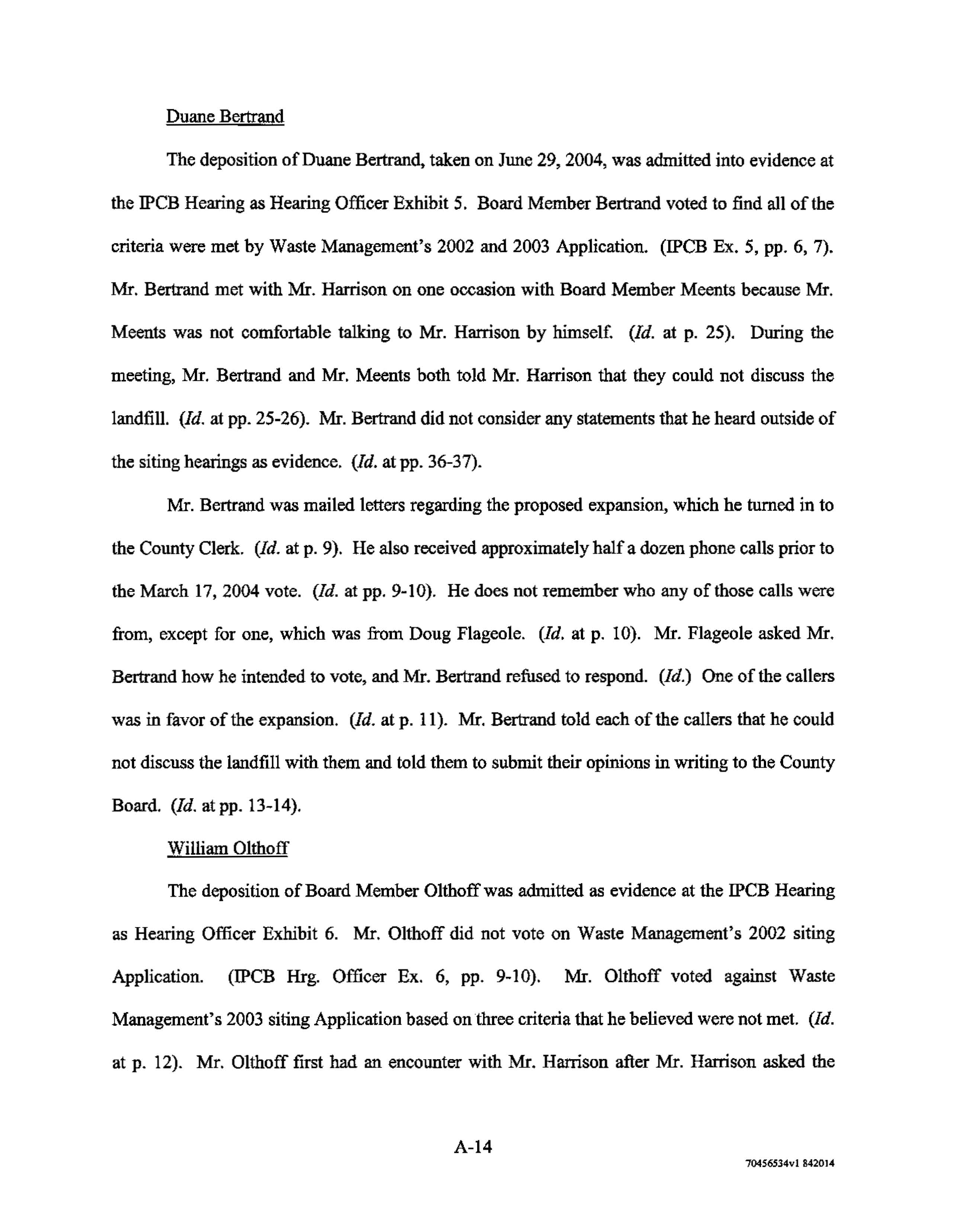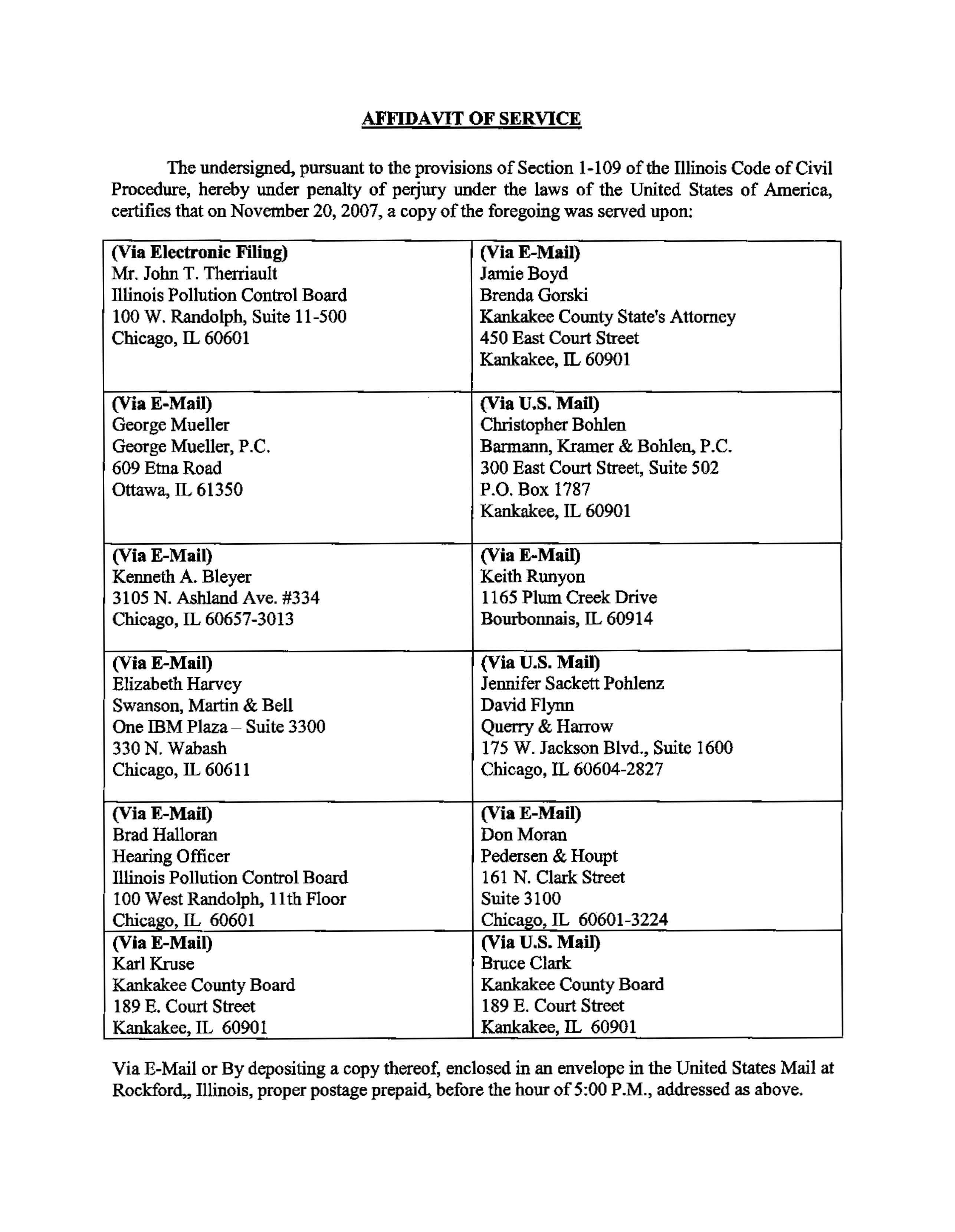BEFORE THE ILLINOIS POLLUTION CONTROL BOARD
WASTE MANAGEMENT OF
ll..LINOIS, INC.,
)
)
Petition~,
)
)
VS.
)
)
COUNTY BOARD OF KANKAKEE COUNTY, )
ULLINOIS,
)
)
Respondent.
)
No. PCB 04-186
(pollution Control Facility
Siting Appeal)
NOTICE OF FILING
TO:
All Attorneys of Record
PLEASE TAKE NOTICE
TIlAT on November 20, 2007, I mailed for filing with the lllinois
Pollution Control
Boar~
Chicago, lllinois, the attached Respondent County Board of
Kankakee County, Illinois' Brief
in
Support of its Decision to Deny Siting Approval to
Waste Management of Illinois, Inc., a copy ofwhich is
h~ewith
served upon you.
DATED: November
20, 2007
HINSHAW
&
CULBERTSON
100 Park Avenue
P.O. Box 1389
Rockford, IL 61105-1389
(815) 490-4900
COUNTY BOARD OF KANKAKEE COUNTY,
ILLINOIS,
BY: HINSHAW & CULBERTSON
lsi
Charles F. Helsten
70414041 vi 842014
Electronic Filing - Received, Clerk's Office, November 20, 2007
BEFORE THE ILLINOIS POLLUTION CONTROL BOARD
WASTE MANAGEMENT OF ILLINOIS,
INC.,
Petitioner,
vs.
COUNTY BOARD OF KANKAKEE
COUNTY, ILLINOIS
Respondent.
)
)
)
)
)
) Case No. PCB 04-186
) Pollution Control Facility Siting Appeal
)
)
)
)
RESPONDENT COUNTY BOARD OF KANKAKEE COUNTY, ILLINOIS'BRIEF
IN SUPPORT
OF ITS DECISION TO DENY SITING APPROVAL TO
WASTE MANAGEMENT OF ILLINOIS, INC.
For the reasons set forth herein, Respondent, County Board of Kankakee County, Illinois
("Kankakee County Board"), respectfully requests that this Board aflinn its decision to deny
siting approval to Waste Management
of Illinois, Inc. ('Waste Management"), the Petitioner
herein.
INTRODUCTION
Waste Management attempts to make the history of this case sound much more exciting
and intriguing
than
it actually is, asserting that it is a "long and complex story involving
conspiracy, deceit, perjury and political intimidation." (petitioner'sBrief, p. 2). A review ofthe
facts
of this case actually reveals that it is rather straightforward. On August 16, 2002, Waste
Management submitted an Application for local siting approval for an expansion
of the existing
Kankakee Landfill located in unincorporated Kankakee County, lllinois. Public hearings on that
Application were conducted before a hearing officer, John McCarthy, and the Kankakee County
Regional Planning Commission from November 18, 2002 through December 6, 2002. The
Application was approved by the Kankakee County Board
on January 31, 2003. This Board
reversed the Kankakee County Board's approval of Waste Management's siting application on
7044TI71vI842014
January 9, 2003 on jurisdictional grounds because one property owner did not receive notice as
required under Section 39.2(b)
of the Illinois Environmental Protection Act (Act).
See County of
Kankakee
v.
City ofKankakee,
PCB 03-31, 33, 35 (Jan. 9, 2003).
After this Board reversed the County Board's approval of Waste Management's 2002
Application, Waste Management filed a new Application for local siting approval for an
expansion of the existing Kankakee Landfill on September 26, 2003. According to Waste
Management's counsel, the Application Waste Management filed in 2003 was "essentially the
same as the siting request filed
by WMII on August 16, 2002, that was approved by the
Kankakee County Board on January 31, 2003[,] [w]ith the exception of updated information
concerning Ordinance requests, criteria
1, 3 and 8 reports, and new information relating to
prefiling
notice:' (Cover letter
to
Vol. I of Waste Management App. filed on Sept. 26,2003).
Public hearings
on Waste Management's 2003 Application were held before Hearing
Officer John McCarthy and the Kankakee County Regional Planning Commission from January
12, 2004 to January 21, 2004.
The Kankakee County Regional Planning Commission
recommended approval
of Waste Management's Application in a divided vote of 9-3 on March
9, 2004. (C.4114).\
In
its 14-page report, the Commission recommended that one special
condition be imposed with respect to criterion (i), fifty-six special conditions be imposed
with
respect to criterion (ii), six special conditions be imposed with respect to criterion (iii), two
special conditions be imposed with respect to criterion (v), fourteen special conditions be
imposed with respect to criterion (vi), and three special conditions be imposed with respect
to
criterion (viii). (C.4101-4114). On March 17,2004, the Kankakee County Board voted to deny
I
The record
with
respect to Waste Management's2003 Siting Application is cited as "C.[page number]." The IPCB
Hearing regarding Waste Management's 2003 Siting Application
is
cited as "IPCB
Hrg.
[date], pp. [page
numbers]. Exhibits from
the
IPCB Hearing regarding Waste Management's 2003 Siting Application are
cited as IPCB Hrg. [party introducing exlubit] Ex. [number], p. [page number(s)]
2
70447771 vI 842014
Waste Management's Application for local siting approval, finding that Waste Management
failed to satisfy criteria (i), (iii) and
(vi)
of Section 39.2(a) of the lllinois Environmental
Protection Act (Act).
(CAlI5-CAI25). Specifically, 16 of the 28 County Board members voted
that criteria (i) and (vi)
had not been met, and 18 of the 28 County Board members voted that
criterion (iii) had not been met.
(CAI16,
4123,4124). The Kankakee County Board detennined
that the proceedings were "conducted
in
a fundamentally fair manner."
(CAllS).
On
April 21, 2004, Waste Management filed a Petition for Hearing to Contest Site
Location Denial with this Board, arguing that the Kankakee County
Board'sdenial of criteria (i),
(iii) and (vi) was "fundamentally unfair, unsupported
by the record and against the manifest
weight
ofthe evidence." (petition for Hearing to Contest Site Location Denial, para. 8). For the
reasons set forth below, the Kankakee County Board's decision to deny siting approval to Waste
Management
was fundamentally fair, supported by the record and was not against the manifest
weight
of the evidence. As a result, this Board should affIrm the decision of the Kankakee
County Board denying
Waste Management'sApplication for expansion.
STATEMENT OF FACTS
1.
Facts Related to Criterion (i)
Waste Management presented the testimony
of Cheryl Smith, who also testified at the
2002 siting hearing regarding need. (C.2607). Since the 2002 siting hearing, Ms. Smith updated
the report that she
drafted on criterion (i). (C.2607, p. 49). Her findings in her 2003 report were
substantially different than her fmdings
in
2002, in that she detennined that the capacity shortfall
for the service area in 2003 was 10 million tons less than she estimated in 2002, with her finding
a capacity shortfall of 59 million tons in 2002 and 49 million tons in 2003. (C.2607, pp. 70-71).
Based
on this capacity shortfall and her assumption that the existing Kankakee Landfill will
3
70447771 vI 842014
close in 2005, she concluded that there would be a need for this facility
in
2009 or 2010.
(C.2607, p. 72).
Ms. Smith admitted that her calculations regarding when the need for the facility would
arise were based on recycling rates that were substantially below the current recycling rates
of
several communities. (C.2607, pp. 55-56). For example, Ms. Smith used a recycling rate for the
County
of Kankakee that was 16% below its current recycling rate, and a recycling rate for the
City
of Chicago that was 8% below its current recycling rate. (C.2607, pp. 55-56). Ms. Smith
admitted that
if the recycling goals of the various communities in the service area were met,
there would be sufficient capacity in the service area until 2015. (C.2607, p. 76).
Ms. Smith also admitted that her need report did not consider several facilities
in or near
the service area that were
in the siting and/or permitting process and would be able to handle
waste in the service area. (C.2607, p. 58). Most notably, Ms. Smith did not include in her report
or her need calculations the 27 million tons
of capacity that would be available from the Town
&
Country Landfill, located directly in Kankakee County, for which siting approval has been
granted. (C.2607, p. 81). Ms. Smith also did not include in her analysis the vertical expansion
of
the Livingston Landfill even though it has received siting approval and 80% ofthe 30 million ton
capacity will be available to the service area identified by Waste Management. (C.2607, pp. 77-
78, 110-111). She also did not consider a proposed 10 to
15 million ton expansion of a Chicago
landfill that would greatly reduce the capacity shortfall for the service area. (C.2607, pp. 87-88).
Ms. Smith also failed to consider
in
her need report other landfills that are currently
pennitted and available to receive waste from the service area, including Prairie View, Brickyard
Landfill and Spoon Ridge Landfill (C.2607, pp. 76-80). Ms. Smith conceded that the available
capacities
of Prairie View, Spoon Ridge and Town
&
Country would total 80 million tons, which
4
70447771 vi 842014
is almost two times the capacity shortfall that Ms. Smith found for the service area in her report.
(C.2607, p. 82-84). While Ms. Smith noted that Spoon Ridge is currently inactive, she agreed
that Spoon Ridge could open at any time and that
if it was opened, nothing would prevent it from
taking Kankakee County waste. (C.2607, p. 85). She also conceded that
if there was a demand
for capacity, Spoon Ridge would be opened. (C.2607, p. 100).
2.
Facts Related to Criterion (iii)
WMll presented the testimony of two witnesses with respect to Criterion (iii), Ms.
Patricia McGarr and Mr. Christopher Lannert. Ms. McGarr testified that she gathered additional
information and data since her testimony at the 2002 siting hearing but was still
of the opinion
that the proposed expansion would not have an adverse impact on surrounding property values.
(C.2605. pp. 33-35,41).
A great deal of Ms. McGarr's testimony consisted of her explaining
why she had testified
in 2002
to
having an Associate'sDegree when the records from the college
that
she attended reflected that she
had
not graduated nor received an Associate's Degree.
(C.2605. pp. 43-75).
While Ms. McGarr testified that the existing
Kankakee Landfill has no impact on
property values, she admitted that she perfonned no appraisals and
had
only cursory
conversations with homeowners to detennine
if that conclusion was supported. (C.2605, pp.
113-15). In reaching her conclusions regarding criterion (iii), Ms. McGarr relied on the Poletti
study, which she
admitted was for the siting of another facility with a different target area.
(C.2605, pp. 120-21).
Ms. McGarr conceded that she had only analyzed eight fann transactions
in the target
area over a twelve year period, and six farm transactions
in an eight year period in the control
area. (C.2606, pp. 16-17). Based on such a small number
of transactions, Ms. McGarr admitted
5
70447771 vI 842014
that removal of one transaction can make a big difference. (C.2605, pp. 153-54).
In
fact, simply
removing two transactions drastically decreased the price
in
the control area. (C.2606, p. 19).
Ms. McGarr admitted that she could not determine from a numerical and statistical perspective
whether the number of sales was statistically significant for either the target or control area.
(C.2606, p. 69).
Because Ms. McGarr only examined a few transactions, she
had
to supplement her report
by relying on another landfill study, Settler's Hill, to conclude that criterion (iii) was met.
(C.2605, p. 141-42; C.2606, p. 67). Although Ms. McGarr initially asserted that the target area
for Settler's Hill was similar to the target area for the proposed expansion, she later stated that
she did not statistically compare Kane County, where Settler's Hill is located, to Kankakee
County. (C.2605, p. 145; C.2606, p. 61). Later in her testimony, Ms. McGarr admitted that
there are significant differences between Kankakee County and Kane County, including the fact
that Kane County has a commuter rail line to Chicago and Kankakee COWlty does not. (C.2606,
p.43). She also admitted that she did not study and compare the populations of Kane and
Kankakee counties and admitted that the population changes of those counties are very different.
(C.2606, p. 78-79).
In
reaching her conclusion that there is no negative impact on properties surrounding a
landfill, Ms. McGarr used a target area of one mile surrounding the landfill. (C.2605, p. 125).
However, Ms. McGarr admitted that she did not perfonn any research to detennine if land
beyond one mile could be negatively affected by a landfill and was not aware of a study
suggesting that properties two miles from a landfill can be adversely affected. (C.2605, p. 126;
C.2606, p. 4-5). She admitted that she had no scientific basis for choosing a one mile radius.
(C.2606, p. 57). Ms. McGarr admitted that the size of the target area could greatly affect the
6
7044n71vl842014
results of a study regarding impacts on a landfill and further admitted that she arbitrarily chose
not to extend the target area to Iroquois County. (C.2605, pp. 48, 50).
Ms. McGarr further admitted that there were features
of the control area that could
negatively affect property values that the target area did not possess. thereby negating the results
of her study that there was no negative impact on property values nearest the landfill. (C.2606,
pp. 45, 51-53). For example, Ms. McGarr admitted that the Interstate and railroad bisect the
control
area, but they do not bisect land in the target area. (C.2606, p. 45). She also admitted
that there is more river frontage in the target area. (C.2606, pp. 51-52). Ms. McGarr admitted
that she did not even consider these characteristics when determining
the
values of properties in
the control area versus target area even though
Ms McGarr admitted that riverfront property is
more appealing than railroad property. (C.2606, pp. 52-53,66).
Christopher Larmert testified regarding the compatibility
of the proposed facility.
Although Mr. Lannert testified that the predominant uses
of the property surrounding the facility
are agricultural, he admitted that a new convention center and aquatic center are being built
nearby and that he did not consider those facilities
in his analysis because they were not present
when
he performed his study prior to the 2002 siting hearings. (C.2607, pp. 11-12). He also
admitted that
he did not review the City of Kankakee Comprehensive Plan and did not speak to
banks, developers, businesses
or residents in completing his compatibility analysis. (C.2607, p.
12).
Mr. Larmert admitted that growth can be expected in the area near the landfill between I-57
and the Iroquois River. (C.2607, p. 18). Nevertheless, Mr. Lannert did not perform any
numerical
analysis to detemrine if the proposed expansion will retard that growth. (C.2607, p.
18).
7
7044n71vl &42014
:Mr. Lannert testified that he was paid $275.00 per hour
to
complete his study and provide
testimony for Waste Management. (C.2607, pp. 12-13). He also admitted that in all matters in
which he
has
testified for waste haulers, he has always found that a facility is located to
minimize incompatibility. (C.2607, p. 16).
Furthermore, during the public comment period, Michael Watson submitted, as an exhibit
to his Proposed Findings
of Facts, a "Technical Review of Criterion 3 of Waste Management of
lllinois, Inc. Application for Expansion of the Kankakee Landfill." (C.2858-2876). That
Teclmical Review was performed
by Peter E. Hopkins of Hopkins Appraisal Service. (C.2859-
60). According to
Mr. Hopkins, "the application filed by Waste Management of Illinois, Inc. is
flawed and fails to meet Criterion 3
..." (C.2859). Specifically,:Mr. Hopkins found that the
appraisal methods and techniques used
by Waste Management were improper because they
improperly averaged prices
ofproperty. (C.2866-867). He also concluded that the criterion (iii)
study was improper because there was no consideration
of the nature of fannland prices.
(C.2867-69). He also found that the
"inclusion of the Settler's Hill
study in
its report is an
inappropriate comparison." (C.2870-71). Finally,
Mr. Hopkins explained that the property value
guarantee plan offered
by Waste management was inadequate. (C.2871-72).
In
conclusion, Mr.
Hopkins stated, ''theCriterion 3 analysis submitted by Waste Management in its application for a
landfill expansion, is flawed at its most basic level, inaccurate, and therefore, fails, even with
testimony to meet Criterion 3." (C.2872).
3.
Facts Related to Criterion (vi)
With respect to criterion (vi), Waste Management presented the testimony
of one witness,
Stephen Corcoran, who also testified at the 2002 siting hearing. (C.2610). Mr. Corcoran
testified that he attached some data
to his 2003 report that mayor may not have been attached to
8
70447771 vl 842014
the 2002 report he prepared. (C.2610, p. 9). At the 2003 siting hearing, Mr. Corcoran provided
additional data that was not included
in his report, including an analysis of the site driveway.
(C.261O. pp. 13, 16).
Mr. Corcoran explained that the expansion is located in the corridor between I-57 to the
west and the Iroquois River
on the east. (C.2610. p. 17).
As
a result. the main route for traffic to
the facility will be south along Route 45/52 for most traffic. (C.2610, p. 20). Route 45/52
consists
of one lane of traffic in each direction with no discemable shoulder. (C.2610, p. 20).
Mr. Corcoran admitted that even though the route to the proposed expansion is one
of the two
possible routes that will
be used by Town
&
Country Landfill when its landfill is complete and
will certainly cause more traffic on the road, he did not factor in the traffic from the Town
&
Country facility when he examined criterion (vi). (C.2610, pp. 11-12). He also did not take into
account the traffic that will be created by the convention center and aquatic center that are being
built at or near the intersection of I-57 and Route 45/52 because he was not aware of those
developments. (C.2610, pp. 21-22).
Mr. Corcoran admitted that his traffic counts were two
years old and had not been updated despite additional developments in the area. (C.2610, p. 71).
When
Mr.
Corcoran perfonned his traffic count, he counted 12 school buses between the
hours of 7:00 a.m. and 8:00 a.m.• which overlaps a peak time for the landfill, with 64 trips
in
and
out between 6:00 a.m. and 8:30 a.m. (C.2610. pp. 44-45). He also agreed that a busy time for
landfill traffic will
be from 2:00 p.m. to 4:00 p.m., which will also coincide with school bus
traffic. (C.2610, p. 47). While
Mr. Corcoran counted the number of school bus trips made along
the route at different times.
he did not determine how many children enter and exit buses along
Route 45/52 between I-57 and 6000 South Road. (C.2610, p. 23).
He also failed to contact the
9
70447771 vi 842014
school district during the school year to determine what bus routes exist in that area and bow
many total school buses travel along that route. (C.2610, pp. 23-25).
Mr. Corcoran admitted that he perfonned his traffic count study
in January and did not
determine a seasonal adjustment factor. (C.2610. pp.
28~29).
Even though he admitted that there
is a fairground nearby, he did not take into account what the traffic would be like during fair
season and did not perfonn any research to determine when the fair runs
or what traffic is
generated during the fair. (C.261O, pp. 70-71).
He also admitted that his report did not account
for construction traffic even though he is aware that there will be construction traffic during the
operation
of the landfill. (C.261O, pp. 33-34). Mr. Corcoran further admitted that his report did
not contain an analysis
of the sight distances at the intersection 6000 South Road and Route
45/52. (C.261O, pp. 62-64).
Mr. Corcoran agreed that mud on the roadway could be a danger to traffic in the area and
explained that Waste Management was going to account for that through its 900
foot paved road
from the scale house to the entrance. (C.2610. pp. 47-48). He also testified that Waste
Management plans to keep the roads clean, but Mr. Corcoran admitted that he has not seen a
written program from Waste Management about that. (C.2610, pp. 49, 79).
In
opposition to Mr. Corcoran's testimony, Mr. Brent Coulter testified on behalf of an
objector with respect to criterion (vi).
Mr. Coulter is a registered professional engineer,
specializing in traffic and transportation engineering and planning. (C.2613, p. 5).
He
has
performed nwnerous traffic studies in the past, and it was his opinion that Waste Management
failed to satisfy criterion (vi). (C.2613, p. 8).
In
reaching that conclusion, Mr. Coulter reviewed
Waste Management's traffic impact study, observed the highway operations
on Route 45/52 near
10
7044n71 vI 842014
the site, and talked to the head of School Bus Services for Clifton School District. (C.2613, pp.
8-9).
Mr. Coulter concluded that Waste Management
has
failed to comply with criterion
(vi).
(C.2613, pp. 7-8).
He reached that conclusion for the following main reasons: 1) Waste
Management failed
to
consider traffic from conunitted developments, including the Town &
Country facility; 2) the application does not minimize the impact
on school bus operations; 3) the
median for the northbound and southbound
turn
lanes is inadequate; 4) the shoulder size is
inadequate; 5) the length
of the southbound left tum lane is inadequate; 6) the sight distance used
by Waste Management was improper; and 7) there should be a mandatory program for cleaning
up mud from the roadway. (C.2613, pp. 10-61).
4.
Facts Related to Fundamental Fairness
In
an attempt to prove its contrived allegations of "conspiracy, deceit, perjury and
political intimidation," Waste Management deposed all but one
of the Kankakee County Board
members. During those depositions, counsel for Waste Management attempted
to
inquire into
the specific reasoning
of the Board members; however, counsel for Kankakee objected to such
questions and instructed the deponents not to answer because such questions improperly invaded
the mental processes
of decision-makers. See IPCB Hrg. Officer Ex. 2; pp. 83-84; Hrg. Officer
Ex. 3, pp. 10-11.
As a result, Waste Management filed a Motion to Compel, requesting that this
Board require County Board members
to
answer questions about why they or other Board
members voted against Waste Management's 2003 Application. (See Waste Management's
Motion to Compel (March 15,
2005». On April 5, 2004, Hearing Officer Bradley Halloran
issued an Order denying Waste Management's Motion
to
Compel, explaining that "[c]onsistent
with prior Board precedent, the integrity
of the decision making process ofthe Kankakee County
Board requires that the mental processes
of decision-makers be safeguarded here, where
11
70447771 vi 842014
petitioner WMII has made no strong showing of bad faith or improper behavior to justify any
inquiry into the decision making
process." (Hearing Officer Order (April 5, 2005» (citation
omitted).
The illinois Pollution Control Board Hearings took place on April
6, 2004 and April 7,
2004. Prior to the hearings, Hearing Officer Bradley Halloran granted a motion
in limine
prohibiting any inquiry into the mental processes of County Board members with respect to their
decision on Waste Management's 2003 siting Application and even prohibited the County
Board's own attorney at times from inquiring into whether County Board members considered
conversations outside
ofthe siting hearings as evidence. (IPCB Hrg. 4/6/05, pp. 218-21).
a
Testimony of County Board Members
At the IPCB hearings,
18 Kankakee County Board members testified. Additionally, the
depositions
of five county board members, including the Vice-Chairman of the County Board,
were admitted as evidence. (lPCB Hrg. Officer Exs.
2-6). Of those 23 individuals who provided
testimony, twelve voted in favor
of Waste Management's 2002 Application and against its 2003
Application based on one or more criteria (Board Members Hertzberger, Romein, Meents,
Marcotte, LaGesse Faber, James, Vickery, Barber, Jackson, Waskowsky, and Olthoff), five did
not vote on Waste Management's 2002 Application and voted against its 2003 Application
(Board Members Gibbs, Scholl, Stauffenberg, McLaren and Graves), two voted against both
applications (Board Members Martin and Bernard), and four voted in favor
of both applications
(Board Members Wilson, Washington, Bertrand and Lee). (IPCB Hrg. Petitioner'sExs. 7-8).
The testimony from these County Board members reveals that all County Board members
received letters from members
of the public regarding the proposed expansion. (lPCB Hrg
4/6/05, pp. 58, 214, 229-30,279,308,310; IPCB Hrg. 4/7/05, pp. 13-14,54,66-68,94, 128, 158-
12
70447nlv1842014
59, 193, 215, 234,278,303, Hrg. Officer Ex. 2, pp. 78.79; Hrg. Officer Ex. 3, pp. 23-24; Hrg.
Officer Ex. 4, pp. 10-11; Hrg. Officer Ex. 5, pp. 9; Hrg. Officer Ex. 6, pp. 31-32).2 However,
most
ofthe County Board members did not read the majority ofthe letters and, therefore, did not
know whether the letters were
in
favor of or opposed to the application. (IPCB Hrg. 4/6/05, pp.
58,214-15,296,310,322; IPCB Hrg. 4/7/05, pp. 67, 94, 128-29, 193-94,215,234; Hrg. Officer
Ex. 2, p. 79; Hrg. Officer Ex. 6, pp. 32-33). Board members who read the letters read some that
were
in favor of the landfill
in
addition to some that were opposed to the expansion. (!pCB Hrg.
4/7/05, p. 14). The letters contained nothing different than what was stated at the siting hearings.
(IPCB Hrg. 4/7/05, pp. 40-41, 58). None
of the Board members were threatened or intimidated
by the letters that they received. (IPCB Hrg. 4/6/05, pp. 255,296; IPCB Hrg. 417/05, pp. 102,
197-99,226,294). Many board members turned
in
the letters that they received to the County
Clerk. (IPCB Hrg. 4/6/05, pp. 214, 230, 252-53; IPCB 417/05, pp. 159-61, 193-94, 235, 248;
Hrg. Officer Ex. 2, p. 79; Hrg. Officer Ex. 3, pp. 23-24; Hrg. Officer Ex. 4, p. 11; Hrg. Officer
Ex. 6, p. 33). Those letters were made part
of the siting hearing record. (C.2617-2807, C.3408-
3721, C.3277-3384). Several board members also received telephone calls from members of the
public, some
of whom were in favor of the application. (IPCB 4/6/05, p. 275; IPCB 417/05, pp.
12, 155; Hrg. Officer Ex. 5, pp. 9-11).
Although many
of the County Board members testified that an individual by the name of
Bruce Harrison attempted to contact them, most of those members had brief and limited
encounters with him. (IPCB Hrg. 4/6/05, pp. 48-49,52,239.40,335; IPCB Hrg. 417/05, pp' 68-
70, 84, 91, 166,218-21,236, 238-39, 306-08, Hrg. Officer Ex. 2, p. 34-41, 50-51; Hrg. Officer
2 A summary oCthe testimony oCKankakee
County
Board members regarding a
parte
communications is contained
in
Appendix A.
13
1044mlvl 842014
Ex. 4, pp. 8-9). Ms. Hertzberger was confronted by Mr. Harrison on one occasion for
approximately two minutes. (IPCB Hrg. 4/6/05, pp. 48-49, 52). Mr. Gibbs
had
one attempted
phone conversation with
Mr. Harrison that lasted less than 45 seconds.
(Id.
at 212-13). Mr.
Romein
had
one telephone call from Mr. Harrison that lasted less
than
two minutes.
(Id.
at 239-
40).
Mr. Harrison made a few comments to Mr. Scholl prior to and/or during the siting hearings.
(Id.
at 275). Mr. Stauffenberg had a brief encounter from Mr. Harrison when Mr. Harrison asked
him to go to lunch, but Mr. Stauffenberg cancelled when he realized that Mr. Harrison wanted to
discuss the proposed expansion. (IPCB Hrg. 4/7/05, pp. 68-69). Mr. LaGesse had a short
telephone call from and one
brief unsolicited face-to-face encounter with Mr. Harrison.
(Id.
at
84-86,91). Mr. Harrison came to Mr. James' office,
but Mr. James refused to speak to him.
(Id.
at 166). Mr. Harrison came uninvited and unannounced to Ms. Barber'soffice. and Mrs. Barber
escorted
him
out.
(Id.
at 220-21). Mr. Harrison came to Mr. McLaren's business on two
occasions.
(ld.
at 236,238-39). Mr. Harrison spoke to Mr. Washington for approximately two
minutes.
(ld.
at 306-08). Mr. Harrison telephoned Ms. Latham Waskowsky on two occasions
and came to her horne once, at which time Ms. Waskowsky instructed Mr. Harrison never to
return. (Hrg. Officer Ex. 2, pp. 34-35, 40, 50-51). Mr. Harrison called Ms. Lee and spoke for
less than one minute. (Hrg. Officer Ex. 4, pp. 8-9).
While four board members did have longer conversations
with Mr. Harrison, lasting
approximately 30 to 45 minutes. two
of those board members, Elmer Wilson and Duane
Bertrand, voted in favor
of the proposed expansion. (IPCB Hrg. 4/6/05, p. 259-60; Hrg. Officer
Ex. 5). Additionally, six board members who voted against the 2003 siting application, Mr.
Martin, Ms. Faber, Mr. Marcotte, Mr. Vickery, Ms. Jackson and Mr. Graves all stated that they
14
7044n71vl 842014
had absolutely
J1Q
contact with Mr. Harrison. (IPCB Hrg. 4/7/05, pp. 20, 27,53-54, 126-28, 191;
Hrg. Officer Ex. 3, pp. 18-20,24).
All
ofthe board members who were contacted by Mr. Harrison did not initiate the contact
themselves and advised Mr. Harrison that they could
not speak to him about the proposed
expansion. (IPCB Hrg.
4/6/05,
pp. 52, 73-74,212,221,253.264.269,312-13.321; IPCB Hrg.
417/05,
pp. 91-93, 166; Hrg. Officer Ex. 5. pp. 25-26). The board members further testified that
they did not consider anything that Mr. Harrison said to
be evidence. (IPCB Hrg.
4/6/05,
pp. 74;
IPCB Hrg. 417/05, pp. 178; Hrg. Officer Ex. 5, pp. 36-37). Moreover, they did not
think
anything Mr. Harrison said was different than what they heard during the siting hearings (IPCB
Hrg.
4/6/05,
pp. 295, 323). The board members did not speak: to Mr. Harrison or anyone else
about the substance
of the application outside of the siting hearings. (IPCB Rrg.
4/6/05,
pp. 74,
322; IPCB Hrg. 4/7/05, pp. 134, 140-41, 215-16, 226). Finally. the board members who had
contact with Mr. Harrison unanimously agreed that they were not intimidated
or threatened by
Mr. Harrison. (IPCB Rrg.
4/6/05,
pp. 79,253-54,269-70, 295-96; IPCB Hrg.
417/05,
pp. 105,
177. 246-48). There was no testimony
or evidence that anything that Mr. Harrison said
prejudiced
or impacted any decision of a County Board member.
b.
Testimony
ofRobert Keller
In an attempt to prove its "conspiracy theory" between Mr. Harrison, Mr. Watson and
Mr. Keller, Waste Management called Robert Keller to testify at the Illinois Pollution Control
Board hearing. Mr. Keller testified that
Mr. Watson is a neighbor ofhis and considers
him
to be
his friend. (IPCB Hrg.
4/5/07.
p. 97). Mr. Keller
has
driven a truck for Mr. Watson'sbusiness.
United Disposal.
(ld.
at 97-98). Mr. Keller was aware that Mr. Watson was opposed to the
proposed expansion,
but he stated that he does not know if he learned that from newspaper
15
70447771 vI 842014
reports, hearsay or from Mr. Watson himself.
(Id.
at 101-02). Mr. Keller has known Broce
Harrison for more than 10 years and
has
allowed Mr. Harrison
to
leave his trailer on his property
from time to time.
(Id.
at 110-11). Mr. Keller assumed that Mr. Harrison was opposed to the
proposed expansion based
on hearsay from other people and from the hearings themselves.
(Id.
at
112-13~
116). Mr. Keller stated that he is not aware ofMr. Harrison ever perfonning work for
Mr. Watson, but Mr. Harrison
has
helped Mr. Keller with his work at times.
(Id.
at 113).
Mr. Keller stated that he never talked to Mr. Harrison about his efforts to oppose Waste
Management'sproposed expansion.
(Id.
at 116). Mr. Harrison used Mr. Keller'sphone when he
lived
on Mr. Keller'sproperty, but Mr. Keller stated that Mr. Hanison never informed Mr. Keller
that
he used his phone to place calls to County Board members.
(Id.
at 117-18). Mr. Keller
testified that he
had
spoken to Mr. Harrison once in the month prior to his testimony, but Mr.
Keller stated that Mr. Harrison did not tell Mr. Keller where
he was living.
(Id.
at 120-27).
Since Mr. Harrison moved
away in the fall or summer of 2004 until April of 2005, Mr. Keller
stated that
he had only spoken to Mr. Harrison three times.
(Id.
at 131). Mr. Keller testified that
he does not know ifMr. Watson
has
been in communication
with
Mr. Harrison.
(Id.
at 132).
Mr. Keller had a ''Nodump. No Chicago garbage" sign in his yard., but testified that he
did not know where he obtained that sign
or who created it.
(Id.
at 144-45). Mr. Keller drafted a
letter
in opposition to the proposed expansion that he sent to all of the County Board members.
(Id.
at 133-34). Mr. Keller received a list of the County Board members so that he could mail his
letter to each
ofthem.
(Id.
at 132-33). That letter is included in the record.
(Id.
at 158; C.2743).
Mr. Keller also sent thank you notes to board members who voted against the expansion.
(Id.
at
148).
16
70447771 vI 842014
ARGUMENT
1.
THE COUNTY BOARD'S DENIAL OF SITING APPROVAL SHOULD BE UPHELD
BECAUSE IT WAS NOT AGAINST THE MANIFEST WEIGHT OF THE
EVIDENCE.
In
order to grant siting approval to a pollution control facility, such as the expansion
sought by Waste Management
in
this case, the County Board or local governing body must find
that the Applicant has satisfied all of the criteria set forth
in
section 39.2(a) of the Act.
See 415
ILCS 5/39.2(a);
Waste Management of Rlinois, Inc.
v.
Illinois Pollution Control Board,
160
Ill.App.3d 434, 443, 513 N.E.2d 592, 597 (2d Dist. 1987).
If
anyone of the criteria listed in
section 39.2(a) is not met, the Application must be denied.
See id.
In
this case, the Kankakee
County Board found that three criteria set forth in section 39.2(a) were not met. Specifically, the
County Board found that the Applicant failed to show compliance with criteria (i), (iii) and (vi).
(C.4115-25). Because Waste Management did not satisfy all of the statutory criteria, the
Kankakee County Board was required to deny siting approval.
The Kankakee County Board's denial
of Waste Management's Application must be
upheld because the County's decision that the Applicant failed to comply
with
criteria (i), (iii)
and (vi) was clearly not against the manifest weight of the evidence.
It
is well.settled that a
county board's decision to grant
or deny siting approval can only be reversed if the decision is
contrary to the manifest weight
of the evidence.
Waste Management,
160 Dl.App.3d at 44142,
513
N.E.2d
at 597. The manifest weight of the evidence standard is to be applied to each and
every criterion on review.
Id.
The manifest weight of the evidence standard is consistent
with
the legislative intent to grant local authorities the power to determine the site location suitability
of a proposed new regional pollution control facility. 160 nl.App.3d at 441, 513 N.E.2d at 596.
17
7044mlvl842014
It
is the sole province of the hearing body to weigh the evidence, resolve conflicts in testimony
and assess the credibility
of the witnesses.
Tate v. Illinois Pollution Control Board,
188
1ll.App.3d 994, 1022, 544 N.E.2d 1176, 1195 (4th Dist. 1989).
In
detennining whether a decision is against the manifest weight of the evidence, it is not
sufficient that a different conclusion
may be reasonable.
Wabash and Lawrence Counties
Taxpayers and Water Drinkers Association
v.
Pollution Control Board,
198 1ll.App.3d 388, 392,
555 N.E.2d 1081, 1085 (5th Dist. 1990). A decision is against the manifest weight
of the
evidence only
if
the opposite conclusion is clearly evident, plain or indisputable.
Worthen
v.
Roxana,
253 1ll.App.3d 378, 384, 623 N.E.2d 1058, 1062 (5th Dist. 1993). When reviewing a
decision under a manifest weight
of the evidence standard, the reviewing court may not reweigh
evidence and
may not reassess the credibility of witnesses.
Id.; Wabash,
198 ll1.App.3d at 392,
555 N.E.2d at
1085. In this case, the evidence and testimony presented at the siting hearings
clearly establishes that the decisions ofthe County Board with respect to criteria (i), (iii) and (vi)
were not against the manifest weight
of the evidence but were clearly supported by the evidence.
A.
THE KANKAKEE COUNTY BOARD PROPERLY CONCLUDED THAT THE
PROPOSED EXPANSION WAS
NOT NECESSARY TO ACCOMrvIODATE
THE WASTE NEEDS OF THE SERVICE AREA.
Section 39.2(a)(i), also known
as
the need criterion, requires that an applicant for local
siting approval demonstrate that the proposed facility "is necessary to accommodate the waste
needs
of the area it is intended to serve." 415 ILCS 5/39.2(a)(i). This criterion requires that the
applicant show that a facility is "reasonably required
by the waste needs of the area intended to
be served, taking into consideration the waste production of the area and the waste disposal
capabilities, along with
any
other relevant factors."
Waste Management ofillinois, Inc.
v.
Rlinois
Pollution Control Board,
122 I1I.App.3d 639,645,461 N.E.2d 542,546 (3d Dist. 1984). Where
other available facilities are sufficient to meet the future waste needs
of the service area,
18
7044777lvl 842014
expansion is not "reasonably required."
Id.
at 546-47. The applicant bears the burden of
establishing need.
Waste Management, Inc. v. illinois Pollution Control Board,
123 n1.App.3d
1075,
1087,463 N.E.2d 969,979 (2d Dist. 1984). Where an applicant establishes nothing more
than that a landfill will
be convenient, the applicant fails to establish that criterion (i) is met.
See
Waste Management,
123 ll1.App.3d at 1085,463 N.E.2d at 976.
Based on
the testimony of Waste Management's only criterion (i) witness, Cheryl Smith,
it is clear that the Kankakee
County Board properly found that Waste Management failed to
establish that expansion
of the Kankakee Landfill was "reasonably required" for several reasons.
First, the Applicant's
own witness admitted that she did not even consider capacity that is
available
in the service area from landfills that currently exist and/or may reasonably be expected
to exist
in the near future. (C.2607, pp. 76-80). Including the capacities of only some of those
existing and/or approved facilities
would result in more than adequate landfill space for the
service area for a period
of over 20 years. Furthermore, Ms. Smith failed to assume an
appropriate recycling rate for the conununities in the service area, and if she
had
done so, there
would not
be a capacity shortfall
in
the service area for 12 years following the siting hearing.
(C.2607,
p. 76). Finally, even based on Mr. Smith'sown generous calculations, the evidence has
failed to demonstrate a ''need''for
the facility until 2009 or 2010, at the earliest, a period of six to
seven years after the siting hearing. (C.2607, p. 72).
Waste Management not
only failed to include in its analysis facilities that can service the
area that are already existing and permitted, such as Prairie River, Spoon Ridge and Brickyard,
but Waste Management's need witness failed to include in her analysis any facilities that had
already received siting approval but had not yet received a permit. As explained by an TIlinois
Court:
19
70447771 vi 842014
Neither the Act nor case law suggests that need be determined by application of
an arbitrary standard of life expectancy of existing disposal capacities. The better
approach is to provide consideration
of other relevant factors such as future
development of other disposal sites, projected changes in amounts of refuse
generation within the service area and expansion of existing current facilities.
Waste Management of Illinois, Inc.
v.
Illinois Pollution control Board.
175 Dl.App.3d 1023,
1033-34,
530 N.E.2d 682, 691 (2d Dist. 1988) (emphasis added). When detennining need, it is
appropriate
"to consider proposed facilities, whether in or out of the county, if such facilities will
be capable ofhandling a portion of the waste disposal needs of the county and will be capable of
doing so prior to the projected expiration of current disposal capabilities within the county such
that
the
needs of the county will continue to be served." 175 lll.App.2d at 1032. 530 N.E.2d at
690.
In
this case, Waste Management's witness failed to take into account millions of tons of
landfill capacity that are reasonably likely to become available in the near future from new
landfills and landfill expansions that have received site location approval, including the
Livingston Landfill, which, when operational, will be able to accept a majority
of its waste from
the service area and the Town
&
Country proposed landfill to be located directly in Kankakee
County. Because Waste Management failed to even consider the available capacity created by
new facilities that have already received approval, it was more
than
reasonable for the Kankakee
County Board to conclude that Waste Management failed to meet its burden
of proving a need
for the facility. This is especially true since Waste Management'sown witness admitted that the
capacity
of only one of the proposed facilities along with the two existing facilities in the service
area totalled 80 million tons, which greatly exceeds the 49 million ton shortfall calculated by
Waste Management's own witness. Because the testimony of Waste Management'sown witness
revealed that proposed
facilities in the area would be sufficient to fulfill the wast needs of the
20
70447771 vI 842014
service area for the next 20 years, it was clearly proper for the Kankakee County Board to find
that there was not a need for the expansion
ofthe Kankakee Landfill.
Waste Management also failed to meet its burden
of proving that the facility was
"reasonably required" because Waste Management's witness used improper calculations in
finding that there will be a capacity shortfall
in
six to seven years following the siting hearing by
using recycling rates that were significantly lower than the current recycling rates of various
communities, including Kankakee County and the City
of Chicago. (C.2607, pp. 55-56).
In
doing so, Ms. Smith overestimated the need for the facility. If Ms. Smith had assumed that the
recycling goals
of the communities were reasonable when adopted and that the likelihood that
those goals would
be met was also a reasonable expectation, there would not be a capacity
shortfall until 2015,
or 12 years after the siting hearing. (C.2607, p. 76). Consequently,
even
without considering the available capacity of the existing and proposed landfills excluded by the
Applicant's witness, it is clear that there will likely not be a shortage of capacity in the service
area for at least twelve years.
Several lllinois courts have found that where there is capacity
in the service area for ten
years or more, criterion (i) is not met.
See Waste Management of nUnois, Inc. v. Pollution
Control Board,
122 Il1.App.3d 639, 461 N.E.2d 542 (3d Dist. 1984);
Waste Management of
nlinois, Inc.
v.
Pol/ution Control Board,
123 Il1.App.3d 1075,463 N.E.2d 969 (2d Dist. 1984);
Waste Management ofIllinois, Inc.
v.
Pollution Control Board,
175 111.App.3d 1023, 520 N.E.2d
682 (2d Dist.
1988).
In
a 1984
Waste Management
case from the Third District, the Illinois
Appellate Court
ruled that the decisions of the Will County Board and the Illinois Pollution
Control Board that criterion (i) was not met were not against the manifest weight of the evidence
where "the facts, as found by the county and by the PCB, with support in the record, show that
21
70447771vl842014
the waste needs of Will County can be handled for ten years with existing available facilities
within the area now served, without additional facilities being necessary." 122 m.App.3d at 644-
45,461 N.E.2d at 546. Because "[t]he evidence, as found by the PCB and the county, indicated
that other available facilities were sufficient to meet the future waste needs
of the area served ..
., this proposed expansion was not reasonably required to meet those needs." 122 m.App.3d at
645,461 N.E.2d at 546-47. The court explained that ifcircwnstances were to somehow change,
the County Board would be free
to
examine the facts as they exist at that time, explaining that
"[t]he decision does not foreclose future applications for the site, based upon changes in the
relevant factors, whether waste production, other sites, or economic costs
of transportation." 122
IlI.App.3d at 645, 461 N.E.2d at 546-47.
The Second District relied
on the Third District's holding in
Waste Management
in
finding that an applicant failed to establish need where the evidence and testimony established
that there would not be a capacity shortfall for ten years. 123 1ll.App.3d at 1086,463 N.E.2d at
978. Because the Illinois appellate court in that case "likewise found that the uncontradicted
testimony indicated existing facilities could handle the waste production for ten years," the court
affinned the
PCB's ruling that the applicant failed
to
establish that the facility was necessary.
[d.
Similarly in a 1988
Waste Management
case, the appellate court found that there was no need for
a proposed facility where there was nine or ten years
of disposal capacity in the service area.
175 ll1.App.3d at 1033, 530 N.E.2d at 691. Specifically, the court ruled that where evidence at a
1987 siting hearing established that ''therewould not be a need for additional disposal facilities
until at least 1996 or 1997[,]' "the PCB's detennination that Waste Management did not sustain
its burden of satisfying criterion (i) is not against the manifest weight of the evidence."
ld.
As is made clear by the cases set forth above, the Kankakee County Board's decision
22
70447771 vi 842014
regarding criterion (i) was not against the manifest weight of the evidence because, using the
appropriate recycling rates, there
is more than ten years of landfill capacity available for the
service area. As such, the Kankakee County Board properly found that Waste Management's
proposed expansion was
not "necessary."
Finally, even
if this Board accepts as true all of the calculations ofWaste Management's
need witness, Waste Management still cannot establish that Kankakee County
Board's decision
regarding criterion (i) is against the manifest weight
of the evidence because Waste
Management's own witness testified that there will not be a capacity shortfall until six
or seven
years after the siting hearing. (C.2607, p. 72).
In
A.R.F Landfill, Inc. v. Pollution Control
Board,
174 n1.App.3d 82, 528 N.E.2d 390 (2d Dist. 1988), the court held that the local siting
authority's decision regarding criterion (i) was not against the manifest weight of the evidence
where the applicant admitted that additional landfill space would not
be needed until at least six
years after the siting hearing. Specifically, the court ruled that where the testimony at a 1987
siting hearing provided that "additional space would not be needed until 1993[,)" the applicant
"did not establish a current need for additional landfill space in Lake County."
A.R.F.,
174
Il1.App.3d at 91-92,528 N.E.2d at 396. Likewise, in this case, this Board must fmd that even
if
there will be a capacity shortfall within six or seven years after the siting hearing, the Kankakee
County Board's decision was not against the manifest weight of the evidence.
This is
particularly true based on the deficiencies in the Ms. Smith's testimony, which clearly establish
that there is likely much more than six
or seven years of capacity available to the service area.
Based on the foregoing, it is clear that the Kankakee County Board's decision regarding
criterion (i) was not against the manifest weight of the evidence because Waste Management
23
70447771 vi 842014
failed to sustain its burden ofproving that facility at issue was necessary to meet the waste needs
ofthe service area
B.
THE KANKAKEE COUN1Y BOARD PROPERLY FOUND THAT THE
APPLICANT FAILED TO ESTABLISH THAT THE FACILITY IS SO
LOCATED TO MINIMIZE THE lNCOMPATffiILITY WITH THE
CHARACTER OF THE SURROUNDING AREA AND TO MINIMIZE THE
EFFECT OF THE VALUE OF THE SURROUNDING PROPERTY.
Section 39.2(a)(iii) of the Act, also known as criterion (iii), provides that the County
Board shall approve the site location suitability for a new regional pollution control facility only
if ''the facility is located so as to minimize the incompatibility with the character of the
surrounding area and
to
minimize the effect on the value of the surrounding property." 415
ILCS 5/39.2(a)(iii). This criterion requires
an
applicant to demonstrate more than minimal
efforts to reduce the landfill's incompatibility.
File
v.
D
&
L Landfill, Inc.,
219 Ill.App.3d 897,
907,579 N.E.2d 1228, 1236 (5th Dist. 1991).
An
applicant must demonstrate that it has done or
will do what is reasonably feasible to minimize the incompatibility.
Waste Management of
flUnois, Inc. v. fllinois Pollution Control Board,
123 1ll.App.3d 1075, 1090,463 N.E.2d 969,980
(2d Dist. 1984).
Based upon all of the testimony and public comments regarding this criterion, it was not
against the manifest weight of the evidence for the County Board to conclude that the facility
was not located so as to minimize the incompatibility with the character of the surrounding area,
or to minimize the effect on the value of the surrounding property. Even though the only
witnesses to testify regarding criterion (iii) were Waste Management's witnesses, the County
Board was not required to accept their opinions that the proposed facility was located to
minimize incompatibility with the surrounding area This is especially true in light of the public
comment filed by a real estate appraiser, who concluded that Waste Management "fails, even
with testimony, to meet Criterion 3." (C.2872) (emphasis added).
24
70447771 vi 842014
Even where no conflicting expert testimony is presented, the County Board is free to find
that an Applicant failed to meet the criteria set forth
in Section 39.2 of the Act because the trier
of fact determines what weight should be accorded to expert testimony.
See In re Glenville, 139
Il1.2d 242, 251,565 N.E.2d 623,627 (1990). As explained by the Illinois Supreme Court: "Even
if several competent witnesses experts concur in their opinion, and no opposing expert testimony
is offered, it is still within the province of the trier of fact to weigh the credibility of the expert
evidence and decide the issue."
ld.
While the trier of fact is not allowed to arbitrarily reject
expert testimony, it is within the province
ofthe trier of fact to disbelieve such testimony.
ld.
In
this case, it is clear that the Kankakee County Board reviewed the testimony of Waste
Management'switnesses and found that despite their testimony
to
the contrary, criterion (iii) was
not met. That decision should be affirmed because it is the province ofthe local siting authority,
and not this Board, to weigh the evidence and assess the credibility of the witnesses.
Fairview
Area Citizens Taskforce
v. illinois Pollution Control Board,
198 lll.App.3d 541,550,555 N.E.2d
1178, 1184 (3d Dist. 1990).
In this case, the credibility of the witnesses was especially relevant to the criterion (iii)
witnesses, particularly Patricia McGarr, who at the first siting hearing testified that she had an
Associate's degree,
but at the second siting hearing had an updated resume that omitted the
reference to that degree. (C.2605, p. 54). In fact, at the 2003 siting hearing, Ms. McGarr
admitted that she was told that she was not entitled to an Associate's degree and had to take
another class in order to obtain her Associate'sdegree. (C.2605, pp. 73, 101-102).
Furthennore, Ms. McGarr's credibility and expertise could properly have been
questioned by the Kankakee County Board because she admitted that she did not perform any
appraisals ofproperty herself and relied on cursory conversations with homeowners to determine
25
70447771 vi 842014
the values of properties surrounding the landfill and whether or not those properties would be
negatively impacted
by the proposed expansion. (C.2605, pp. 114.15). Ms. McGarr'stestimony
and conclusions were further called into question because in reaching
her conclusions, Ms.
McGarr relied on the Polettti study, which she admitted was a study for an entirely different
landfill
with
an entirely different target area. (C.2605, pp. 119-21). The strength of Ms.
McGarr's study and conclusions
was further weakened by her concession that she had not
studied enough transactions and, therefore,
had to rely on another landfill study, Settler'sHill, to
conclude that criterion (iii) was met. (C.2605, p. 141-42; C.2606, p. 67).
The inadequacy
of Ms. McGarr's conclusions related to "impact" on property values
becomes especially clear when viewed from the fact that she was only able to analyze only eight
fann transactions
in
the target area over a twelve year period, and only six farm transactions in
an eight year period from the control area. (C.2606, pp. 16-17). Based
on such a small number
of transactions, Ms. McGarr admitted that removal of one transaction can make a big difference.
(C.2605, pp. 153-54).
In
fact, simply removing two transactions drastically decreased the price
in the control area. (C.2606, p. 19). Ms. McGarr admitted that she could not determine from a
numerical and statistical perspective whether the number
of sales was statistically significant for
either the target
or control area. (C.2606, p. 69).
Ms. McGarr's credibility was further called into doubt when she testified that there were
no significant differences between the Settler'sHill landfill and the proposed expansion (C.2605,
p. 145), but later admitted that she did not statistically compare Kane and Kankakee counties.
(C.2606, p. 61). Ms. McGarr also later
admitted that there are significant differences between
Kankakee County, the location of the proposed expansion, and Kane County, the location of the
Settler's Hill facility, including the fact that Kane County
has a commuter rail line to Chicago
26
704477l1vl 842014
and Kankakee County does not. (C.2606t p.43). She also admitted that she did not study and
compare the populations
of Kane and Kankakee counties and that the population change of those
counties is very different. (C.2606,
p. 78-79).
AdditionallYt Ms. McGarr's study was questionable because she arbitrarily chose a mile
radius
as her target area even though she had no scientific basis for doing so. (C.2605, p. 125;
2606t p. 57). Ms. McGarr admitted that the size ofthe target area could greatly affect the results
of a study regarding impacts on a landfill and further admitted that she arbitrarily chose not to
extend the target area to Iroquois County. (C.2605
t
pp. 48t 50).
Ms. McGarr further admitted that there were features
of the control area that could
negatively affect its property values that the target area did not possess, thereby negating the
results
of her study that there was no negative impact on property values nearest the landfill.
(C.2606, pp. 45, 51-53). Those features include an interstate, railroad bisection and less river
frontage.
(C.2606t pp. 45, 51-52). Ms. McGarr admitted that she did not even consider these
characteristics when detennining the values
of properties in the control area versus the target
area. (C.2606, pp.
52-53t 66).
Finally, Ms. McGarr's report and testimony could properly have been disregarded
by the
Kankakee County Board because they were simply unreliable. The objector's counsel pointed
out problem after problem with the chart relied upon
by Ms. McGarr in reaching her conclusions
because the infonnation contained
in
Ms. McGarr's report did not match the alleged sources of
that information. (C.2606, pp. 26-36).
In
fact, Ms. McGarr admitted that she did not check each
and every entry
in her chart. (C.2606, p. 38). Although Ms. McGarr testified later and provided
a corrected copy
of the table located in her report (C.2615, p. 10), the harm had already been
27
70447771 v1 842014
done, and the Kankakee County Board was free to detennine that Ms. McGarr was not thorough
or dependable.
The testimony
of Waste Management's other criterion (iii) expert, Mr. Lannert, was also
called into question through his testimony. Mr. Lannert testified that the facility was located to
minimize the incompatibility with the surrounding area; however,
he
admitted
that he did not
review the City
of Kankakee Comprehensive Plan
A,
or speak to any banks, developers
businesses
or residents
to
determine ifthat was in fact true. (C.2607, p. 12).
The Board
may also have concluded that Mr. Lannert'stestimony was biased because be
was paid $275 per hour to perform his study and further admitted that whenever he testifies for
waste haulers, he always comes to the conclusion that the proposed facility is located
to
minimize incompatibility. (C.2606, pp. 12-13, 16).
In
one of the only cases in which Mr.
Lannert concluded that a landfill was not compatible with the surrounding area, he so found
because the area was ripe for development; however,
Mr. Lannert conceded that the area
between I-57 and the Iroquois River, the area where the facility is proposed to
be expanded, is
also expected to grow and admitted that he did nothing to determine whether the facility would
retard development. (C.2606, p. 18).
Based on the foregoing testimony, it is clear that the credibility of both of Waste
Management's witnesses with respect to criterion (iii) was weighed
by the County Board. The
credibility of Waste Management'scriterion (iii) witnesses, particularly Ms. McGarr, was further
weakened by the report submitted as public comment from
a
real estate appraiser specifically
criticizing Waste Managemenes criterion (iii) report and concluding that it was flawed and
inaccurate. (C.2858-76). Because it was the role
of the Kankakee County Board to assess the
28
70447771 vi 842014
witnesses' credibility, which were clearly an issue with respect to criterion (iii), the County
Board'sdetennination with respect to criterion (iii) should not be set aside.
C.
THE KANKAKEE COUNTY BOARD PROPERLY FOUND THAT THE
APPLICANf FAILED TO ESTABLISH THAT THE TRAFFIC PATTERNS TO
OR
FROM THE FACILITY WERE DESIGNED TO MINIMIZE THE IMPACT
ON TRAFFIC FLOWS.
Section 39.2(a)(vi)
of the Act, referred to as criterion (vi), requires that the applicant
establish that
"the traffic patterns to or from the facility are so designed as to minimize the
impact
on traffic flows." 415 ILCS 5/39.2(a)(vi). Although Mr. Corcoran testified that criterion
(vi) was met, Mr. Coulter had many criticisms of Mr. Corcoran's traffic design and report,
establishing that Waste Management failed to meet its burden
of establishing criterion (vi).
First, Mr. Coulter testified that in analyzing traffic at and around the facility, Waste
Management failed to take into consideration both existing and committed development.
(C.2613, pp. 39-40).
If
Waste Management
had
considered committed development, it would
have considered traffic that will come from the proposed Town
& Country landfill as well as
from the existing convention center and aquatic park, which are being built at the intersection
of
I-57 and Route 45/52. (C.2613, pp. 41-42).
Furthermore, Mr. Coulter pointed out that Waste
Management's traffic design and report
failed to establish the impact on school bus operations because he failed to account at all for
school bus operations. (C.2613, pp. 13-14). Mr. Coulter explained
that the facility traffic will
most certainly impact school bus operations because, according
to
his conversations with school
district officials, the school buses travel between 7:00 a.m. and 7:45 a.m. and 3:00 p.m. to 3:45
29
7044777IvI842014
p.m., which are very busy times for the facility. (C.2613, p. 12). Those buses make multiple
stops within the 5000 and 6000 blocks of Route 45, the area where there will be tremendous
traffic to the facility. (C.2613, p. 27). The fact that the Applicant did not adequately account for
school bus traffic is a major problem because stopped buses can create the potential for
dangerous situations. (C.2613, pp. 12-13).
Mr. Coulter also found that the design of the roadway is improper and does not minimize
impacts
on traffic because the median between the northbound and southbound turns lanes is
only 12 feet, instead
of 14 feet, as recommended by the illinois Department of Transportation
(IDOT) for these types of intersections. (C.2613, pp. 14-16). According to Mr. Coulter, the
extra two feet provides "an extra margin
of safety, especially when you have a very high volume
oftruck traffic as this site will have." (C.2613, p. 15).
Mr. Coulter also explained that there is an inadequate shoulder to the roadway of Route
45/52 because there really is none to speak of. (C.2613,
p. 15). Based on the high speed and
volume of truck traffic, both the State of lllinois Design Practice and national guidance from the
American Association
of State Highway Transportation Officials (AASHTO) provide that there
should be a paved shoulder of at least eight feet. (C.2613, p. 16). Such a shoulder could make
operations more safe for school buses when they stop to pick up and/or drop
off students.
(C.2613,
p. 32).
Mr.
Coulter also found that the length of the southbound
turn
lane is inadequate, as it is
only 430 feet in length and should be 530 feet
in
length. (C.2613, p. 15). Both the IDOT
Manual and AASHTO Manual, which is the codified national standardization
of highway
designs
used throughout the country, establish that the length of the lane should be 530 feet.
(C.2613, p. 16).
30
70447771 vI 842014
Moreover, Mr. Coulter concluded that Waste Management used an improper minimum
sight distance
of 570 feet, while the correct sight distance that should have been used is 1,000 to
1,100 feet because the traffic
on the route will be primarily truck traffic. (C.2613, pp. 17-20).
Because Waste Management's Application did not indicate that there
will be 1,100 feet for the
sight line to and from the north and south
of the property, Mr. Coulter found that Waste
Management failed to satisfy criterion (vi). (C.2613, p. 51).
Finally, Mr. Coulter determined that Waste Management did
not satisfy criterion (vi)
because it did not establish any mandatory procedure for cleaning
mud and debris from the
roadway. (C.2613, p. 21).
It
is important that mud be cleaned up as quickly as possible and
should be a mandatory practice ofthe landfill site operation. (C.2613, p. 21). Because there was
nothing in section
(vi)
of Waste Management's Application establishing mandatory procedures
for cleaning trucks that will enter the roadway, Waste Management failed to satisfy the criterion.
(C.2613, pp. 59-60).
With respect
to
criterion (vi), there was conflicting testimony, with Waste Management's
witness testifying that the criterion was met, and an objector's witness pointing out numerous
deficiencies establishing that criterion (vi) was not met.
As the trier of fact, the County Board
was able to weigh and assess the testimony
of the various witnesses and detenrune which witness
and testimony it found to he more credible.
See Fairview,
198 1ll.App.3d at 550,555 N.E.2d at
1184. Furthermore, the County Board members were free
to
use their own knowledge and
familiarity
with local traffic conditions to determine that criterion
(vi)
was not met.
See Hediger
v.
D&L
Landfill,
PCB 90-163 (Dec. 20, 1990). Because the County Board was in the best
position to weigh the evidence and testimony regarding criterion (vi), this Board should uphold
the County Board'sdecision.
31
70447771 v I 842014
Electronic Filing - Received, Clerk's Office, November 20, 2007
D.
IT WAS THE PROVINCE OF THE COUNTY BOARD ALONE TO DECIDE
WHETHER THE STATUTORY CRITERIA WERE MET.
In
its Brief, Waste Management pays much lip service
to
the fact that the Kankakee
County Regional
Plarming Commission recommended that the County Board approve Waste
Management's siting application
in
a "49-page report." (petitioner's Brief, p. 7). However, the
truth is that the Commission did not issue a 49 page report but, rather, issued a 14 page report,
which was comprised almost entirely
of 79 conditions that the Commission believed were
necessary for the application to meet the statutory criteria. While the work
of the Commission
was certainly important and served to satisfy substantial and additional opportunities for public
input, the fact that the Commission recommended approval
of Waste Management's Application
is irrelevant because it was the ultimately the duty
of
the
County Board, and the County Board
alone,
to detennine if the statutory criteria of the Act were met.
See
415 ILCS 5/39.2(a) ("The
county board
of the county or the governing body of the municipality ... shall approve or
disapprove the request for local siting approval for each pollution control facility which is
subject to such review.'')(emphasis added).
Moreover, a review
of the Commission'sRecommendations actually supports the County
Board's decision
to deny siting approval to Waste Management and proves that the County
Board'sdecision was not against the manifestweight
ofthe evidence. Although the Commission
recommended that the County Board find that criteria (i), (iii) and (vi)
had
been met, the
Commission found it necessary to impose special conditions on each
of those criteria.
In
fact,
the Commission suggested one special condition for criterion (i), six special conditions for
criterion (iii), and fourteen special conditions for criterion (vi). (C.4102. C.4109-12).
An
examination of the recommended special conditions reveals that Waste Management
failed to meet its burden
of establishing the statutory criteria. For example, with respect to
32
70447771 vi 842014
Electronic Filing - Received, Clerk's Office, November 20, 2007
criterion (iii), the Commission recommended a special condition requiring Waste Management to
construct benning and barriers that were not proposed
by Waste Management, clearly
establishing that the berming and barriers proposed by Waste Management were inadequate.
(C,4109-1O). Additionally, with respect
to criterion (vi), the Commission recommended 14
conditions, many
of which exemplify the deficiencies in Waste Management's Application that
were pointed out
by Mr. Coulter. (C,4ll1). For example, the Commission required the landfill
operator
to "demonstrate to the County that sight distance of at least 1,015 feet of visibility can
be achieved
by the final entrance design" and make modifications for proposed road
improvements, including a larger median and longer deceleration lane.
(C,4lll-l2). As
explained by
Mr. Coulter, these are issues that Waste Management should have resolved in its
Application, but failed to do.
It
is well-settled that it is the responsibility of an applicant to establish that a proposed
facility meets all
of the statutory criteria.
Guerrettaz
v.
Jasper County,
PCB 87-76, slip op. at *9
(Jan. 21, 1988).
It
is not the duty of a county board or governing body of a municipality to
correct the deficiencies
of an application by imposing numerous special conditions that must be
met.
In
this case, it is clear that Waste Management did not meet its burden of proving that the
statutory criteria were met. As a result, the Commission felt it necessary to impose
79 special
conditions. The Kankakee County Board, on the other
hand., properly concluded that even with
the inclusion
of those special conditions, Waste Management's Application was still deficient.
Considering all
of the testimony and evidence presented by Waste Management and the
objectors, the County Board'sdecision was not against the manifest weight
ofthe evidence.
II.
THE SITING HEARINGS WERE FUNDAMENTALLY FAIR.
Section 40.1 of the illinois Environmental Protection Act allows an applicant whose
application
has
been denied by a county board to seek review from this Board to detennine if the
33
70447771 vI 842014
local siting proceedings were fundamentally fair. 415 ILCS 5/40.1(a). During such a review, the
burden
is on the applicant.
ld.
In
this case, Waste Management has clearly failed to meet its
burden of establishing that the siting hearings before the Kankakee County Board were
fundamentally unfair.
There
is a presumption that county board members engaged in landfill siting hearings
under Section 39.2
of the Act are objective and capable of fairly judging the particular
controversy.
See Waste Management,
175 Ill.App.3d at 1040, 530 N.E.2d at 695. That
presumption may only be overcome
if "a disinterested observer might conclude that the
administrative body, or
its members, had
in
some measure adjudged the facts as well as the law
ofthe case in advance of hearing it."
Waste Management,
175 1ll.App.3d at 1040, 530
N
.E.2d at
696.
In
this case, Waste Management has failed
to
present any evidence establishing that a
disinterested observer would conclude that the Kankakee County Board pre-judged Waste
Management's Application.
A.
THE
EX PARTE
CONTACTS IN THIS CASE DID NOT "IRREVOCABLY
TAINT" THE SITING HEARING PROCESS.
In
this case, Waste Management asserts that the siting hearings were fundamentally
unfair based on
ex parte
contacts through letters, telephone calls and in-person contacts between
county board members and various members
of the public, particularly Mr. Bruce Harrison.
However,
ex parte
contacts do not, in and
of themselves, require reversal.
Residents Against a
Polluted Environment
v.
County a/LaSalle,
PCB 96-243, slip op. at *8 (Sept. 19, 1996). Rather,
the complaining party must show that the
ex parte
contacts caused hann.
ld.
A decision will
only be reversed due to
ex parte
contacts
if it is "irrevocably tainted so as to make the ultimate
judgment
of the agency unfair, either to an innocent party or to the public interest that the agency
34
70447771 vi 842014
was obliged to protect."
E
&
E Hauling, Inc. v. Pollution Control Board,
116 IlLApp.3d 586,
606,451 N.E.2d 555,571 (2d Dist. 1983).
In order to detennine whether
ex
parte
contacts warrant reversal, a court should consider
the following:
1) the gravity of the
ex
parte
communications; 2) whether the contacts may have
influenced the agency's ultimate decision; 3) whether the party making the improper contacts
benefited from the agency's ultimate decision; 4) whether the contents
of the communications
were unknown to the opposing parties, who therefore had no opportunity to respond; and 5)
whether vacation
of the agency's decision and remand for new proceedings would serve a useful
purpose.
E
&
E
Hauling,
116 m.App.3d at 607, 451 N.E.2d at 571,
citing
PATCO
v. Federal
Labor Relations Authority,
685 F.2d 547, 464-65 (D.C. Cir. 1982). As explained more
thoroughly below, the
ex
parte
contacts in this case were not such that they "irrevocably tainted"
the siting hearing process, as they were not grave, did not influence the Kankakee
Cowty Board,
did not benefit any party, and the contents
of the communications were known by Waste
Management. Therefore, the County Board'sdecision must be upheld.
1.
The Communications
by
the Public, Including Mr. Harrison, Were
Not
So Egregious to Warrant Reversal.
The
ex
parte
communications
in
this case were exclusively non-substantive contacts
consisting
of members of the public expressing their opinions about the proposed expansion to
County Board members in the
fOlll1 of letters, telephone calls and some in-person contacts. This
Board in
Gallatin National Bank v. Fulton County
held that communications were not grave
when they involved "non-substantive matters." PCB 91-256, slip
op. at *9 (June 15, 1992). As
explained by this Board in
Gallatin,
the hearing officer and committee members "did not discuss
the merits
of the case with anyone ... and were not influenced in any way when making the
recommendation for the
.. , County Board Meeting."
ld.
Because the communications were
35
7044n71vl 842014
non-substantive and the county board was not influenced by the communications, the petitioner
"failed to demonstrate
how it [was] prejudiced or how the alleged contacts or lack of notice
compromised the County
Board's decision."
Id.
Likewise, Waste Management
has
failed to demonstrate that it was prejudiced by any
ex
parte
conununications because, like the contacts
in
Gallatin,
the contacts with the Kankakee
County Board were non-substantive, consisting merely
of opinions from members of the public,
particularly Mr. Bruce Harrison. Like the county board members in
Gallatin,
The Kankakee
County Board members specifically testified that they did not discuss the merits
of Waste
Management's Application with anyone outside
of the siting hearings, including Mr. Harrison.
(IPCB Hrg. 4/6/05, pp. 74, 322; IPCB Hrg. 4/7/05, pp. 134, 140-41, 215-16, 226). They also
testified that they did
not consider anything said during
ex parte
communications to be evidence.
(IPCB Hrg. 4/6/05, pp. 74; IPCB Hrg. 4/7/05, pp. 178; Hrg. Officer Ex. 5, pp. 36-37). As such,
Waste Management
has
failed to establish any prejudice as a result of the non-substantive
communications.
While Waste Management greatly exaggerates Mr. Harrison's attempted communications
with the County Board members, the evidence. taken at the IPCB hearing
on April 6 and 7, 2005
establishes that the majority
of County Board members stated that they had little to no contact
with Mr. Harrison.
For example, Ms. Hertzberger was approached by Mr. Harrison on only one
occasion for approximately two minutes (IPCB Hrg. 4/6/05, pp.
48-49,52); Mr. Harrison made
only one unsolicited telephone call to Mr. Gibbs that lasted less than 45 seconds
(Id.
at 212-13);
Mr. Romein also had one telephone call from Mr. Harrison that lasted less than two minutes
(Id.
at 239-40); Mr. Harrison merely made a few comments to Mr. Scholl prior to and/or during the
siting hearings
(Id.
at 275); Mr. Stauffenberg had a brief encounter with Mr. Harrison when Mr.
36
70447771 v1 842014
Harrison asked
him
to go to lunch, but Mr. Stauffenberg cancelled and did not attend the lunch
(IPCB Hrg. 4/7/05, pp. 68-69); Mr. LaGesse
had a short telephone call from Mr. Harrison and
one
brief face-to-face encounter with him
(Id.
at 84-86, 91); Mr. Harrison came
to
Mr. James'
office, but Mr. James refused to speak to him
(Id.
at 166); Mr. Harrison came uninvited and
unannounced to Ms. Barber's office, and Mrs. Barber escorted him out
(Id.
at 220-21); Mr.
Harrison came uninvited to
Mr. McLaren's business on two occasions
(Id.
at 236,238-39); Mr.
Washington was approached
by Mr. Harrison once for approximately two minutes
(Id.
at 306-
08); Mr. Harrison telephoned Ms. Latham Waskowsky
on two occasions and carne to her home
once, at which time Ms. Waskowsky instructed Mr. Harrison never to return (Hrg. Officer Ex. 2,
pp.
34-35,40, 50-51); Mr. Harrison tried to speak with Mr. Lee
in
a telephone call that lasted
less than one minute. (Rrg. Officer Ex.
4,
pp. 8-9). Additionally, Mr. Martin, Ms. Faber. Mr.
Marcotte, Mr. Vickery, Ms. Jackson and Mr. Graves all stated that they had absolutely no contact
with Mr. Harrison. IPCB Hrg. 4/7/05, pp. 20, 27, 53-54, 126-28, 191; Hrg. Officer Ex. 3, pp. 18-
20,24.
Furthermore, the County Board members who had these unsolicited contacts from Mr.
Harrison unanimously testified that they did not initiate the contacts themselves and advised Mr.
Harrison that they could not speak to him about the proposed expansion. (IPCB Hrg.
4/6/05,
pp.
52, 73-74, 212, 221. 253, 264, 269, 312-13,321; IPCB Hrg. 4/7/05, pp. 91-93, 166; Hrg. Officer
Ex. 5, pp. 25-26). Several Board members also testified that Mr. Harrison's comments were no
different than what was stated at the siting hearings. (IPCB Hrg. 4/6/05, pp. 295. 323).
As such,
the communications were clearly not grave, as they were a mere reiteration
of what was
presented at the siting hearing.
See Town of Ottawa v. Illinois Pollution Control Board, 129
37
70447771 v1 842014
Ill.App.3d 121, 126,472 N.E.2d 150, 154 (3d Dist. 1985) (finding that
ex parte
communications
were
not grave because they contained nothing novel).
Based
on the testimony ofthe County Board members, it is clear that the communications
were not so grave or egregious as to require reversal; however, Waste Management greatly
overestimates the nature
of Mr. Harrison's contacts with County Board members in order to
justify its position.
For example, Waste Management describes two contacts between Board
Member Jamie Romein and
Mr. Harrison but fails to point out that these contacts occurred after
the County
Board's March 17, 2004 vote on Waste Management's Application and, therefore,
could not have influenced
Mr. Romein's decision to vote against Waste Management's siting
application, as Waste Management contends. (IPCB Hrg. 4/6/05, pp. 241-48; 253). Further,
although Waste Management asserts that
Mr. Harrison's comments were extreme and
outrageous, the Kankakee County Board members unanimously
agreed that they were not
threatened
or intimidated by Mr. Harrison'scontact. (IPCB Hrg. 4/6/05, pp. 79, 253-54, 269-70,
295-96; IPCB
Hrg.
4/7/05,
pp. 105, 177, 246-48).
In the case of
Land and Lakes Co.
v.
Randolph County Board of Commissioners,
PCB
99-69 (Sept.
21,2000), the
ex
parte
contacts were much more egregious than the contacts
in
this
case, as the County Board Chairman
was subjected
to
numerous ''pranks,''including having tires
flattened
on his construction equipment, receiving a package that appeared to be full of garbage,
having orders placed in his and/or his
wife's name to a florist, furniture store and a restaurant.
Slip op. at *4. Nevertheless, this Board found that such contacts were insufficient to establish a
lack
of fundamental fairness because the applicant "was given a
full
and complete opportunity to
offer and support its application." Slip op.
at
*
19. According to this Board:
Public hearings were held before the Planning commission where witnesses for
Land and Lakes testified in support
of the multi-volume application. Opposition
38
70447771vl 842014
to the application was also heard at that hearing. After the close of the public
hearing, a thirty-day comment period was held. Thus, Land and Lakes was aware
ofthe opposition and had the opportunity to respond.
ld.
Likewise, in this case, Waste Management employed several witnesses to testify in support
of its two-volume application, heard objectors at the siting hearing and had an opportunity to
respond to those objectors. as well as any comments submitted during the comment period.
Therefore, Waste Management, like Land and Lakes. "was given a full and complete opportunity
to offer and support its application" and has failed to establish that the
ex parte
contacts were
grave enough
to require reversal.
Several courts have explained that
ex
parte
contacts with members of the public
regarding a siting application are inevitable and not grave. The court in
Waste Management,
175
Ill.App.3d at 1043. 530 N.E.2d at 697. explained that public officials being contacted by
members of the public through telephone calls, letters and personal contacts expressing opinions
for or against a landfill does not establish that a hearing lacks fundamental fairness.
ld.
Specifically, the court in
Waste Management
explained that telephone calls, letters and personal
contacts are merely expressions
of public sentiment and concluded that "the existence of strong
public opposition does not render a hearing fundamentally unfair where, as here, the hearing
committee provides a full and complete opportunity for the applicant to offer evidence and
support its application."
Waste Management,
175 m.App.3d at 1043, 530 N.E.2d at 697-98.
Likewise,
in
Fairview Area Citizens Taskforce
v.
Pollution Control Board,
198 m.App.3d 541,
555 N.E.2d 1178 (3d Dist. 1990), the court explained:
[E]x parte
communications from the public to their elected representatives are
perhaps inevitable given a county board member's perceived legislative position,
albeit in these circumstances, they
act in an adjudicative role as well. Thus
although personal
ex parte
conununications to county board members
in
their
adjudicative role are improper, there must
be a showing that the complaining
party suffered prejudice from these contacts.
39
70447771 vi 842014
[d.
at 549.
In
this case, Waste Management has completely failed
to
show that the non-substantive
communications from members
of the public were so grave that they were prejudiced by them.
In
fact, the evidence clearly establishes that the contacts were from members of the public
expressing their opinions about the landfill, both for and against
it. Because such types of
contacts are "inevitable," they are certainly not grave.
2.
The communications did not influence the ultimate decision.
The second issue to be considered under the
E
&
E Hauling
factors is whether the alleged
ex parte
contacts influenced the County Board's ultimate decision.
In
this case, through the
Motion in Limine, County Board members were
not able to discuss what factors did and did not
influence their votes with respect
to
Waste Management's siting application. However, their
testimony clearly reveals that they were not influenced by Mr.
Harriso~
as they specifically
testified that they did not consider anything that Mr. Harrison said to be evidence. (IPCB Hrg.
4/6/05,
pp. 74; !PCB Hrg.
417105,
pp. 178; Hrg. Officer Ex. 5, pp. 36-37). The County Board
members also unanimously testified that they were not intimidated or threatened by Mr.
Harrison. (IPCB Hrg.
4/6/05,
pp. 79,253-54.269-70,295-96; IPCB Hrg.
417/05.
pp. 105, 177,
246-48). Based on such testimony, Waste Management's assertions that the Kankakee County
Board members were threatened into voting against Waste Management's Application are
wholly untrue and must
be disregarded.
Waste Management repeatedly asserts that the fact that some Kankakee County Board
members who voted
in
favor of Waste Management's 2002 Application voted against its 2003
Application establishes
ex parte
contacts from Mr. Harrison influenced the County Board's
decision. However, Waste Management's argument is without factual support because of those
County Board members who allegedly "changed their votes," between 2003 and 2004, four
40
70447771
vi
842014
denied having any contact with Mr. Harrison. (IPCB 4/7/05, pp. 53-54, 126-28, 191, 280).
Furthermore, several County Board members who were contacted and allegedly threatened
by
Mr. Harrison voted in favor of Waste Management's Application. (IPCB Hrg 4/6/05, pp. 264-
70,306-08; IPCB Hrg. Officer Ex. 3, pp. 8-9; lPCB Ex.
5, pp. 25-26; WCB Hrg. Petitioner'sEx.
7). Consequently, Waste Management's theory that the conduct
of Mr. Harrison was the basis
for the votes
ofthe County Board members is entirely without merit.
Moreover, Waste Management's assertion that the County Board members were not
justified
in changing their votes because the applications and siting hearings were the same and
that "[t]he only significant difference between the [2002 and 2003] applications was the
aggressive and threatening
ex parte
advocacy of Mr. Harrison" is a complete misstatement ofthe
facts.
In
fact, the evidence clearly establishes that the 2002 and 2003 applications were different,
as were the testimony and evidence presented at the siting hearings. Waste Management itself,
through its counsel, admitted both at the siting hearing and
in correspondence upon delivery of
the siting application that the applications were not identical. In. fact, at the siting hearing, Waste
Management's counsel indicated that "additional data
...obviously has been gathered or
developed," (C.2604, p. 73) Furthermore, in the cover letter included
in
Waste Management's
2003 siting application, Waste Management's counsel admitted that there was "updated
infonnation regarding criteria
1, 3 and 8." 2003 (App. Cover Letter). Therefore, based on the
Applicant'sown
admission, the applications were not identical.
Moreover, testimony provided at the siting hearing established that the applications were
not identical, as witnesses regarding criteria (i) and (iii) specifically testified that the reports that
they created for the 2002 Application had been updated and amended for the 2003 Application.
(C.2605, pp 33-35; C.2607, p. 49; C.261O, p. 16).
In
fact, Ms. McGarr specifically testified that
41
7044777Ivl842014
she gathered additional information and data regarding criterion
(iii)
since the prior hearing.
(C.2605, pp. 33-35). That new infonnation was significant because it reduced the increase
in
per
acre average price for the target area
by more
than
70% and reduced the increase in per acre
average price for the target area
by nearly 90%. (C.2606, p. 21). Ms. Smith also testified that
she updated both her need report criterion (i) and criterion (viii) report from the 2002 hearing.
(C.2607, p. 49; C.2608, p. 5). Because Waste Management's 2003 Application contained new
infonnation regarding several criteria,
it was reasonable for the County Board to conclude that
those criteria were
not met even though the County Board found that those criteria were satisfied
by Waste Management's2002 Application.
Moreover, even
if the two applications were completely identical, that does not establish
that the County
Board's decision with respect to Waste Management's 2003 siting application
was against the manifest weight of the evidence because the County Board's decision to grant or
deny siting approval is not based solely on a siting application, but is based on additional
information presented during the siting hearing, as well as public comments presented during and
after the hearing.
In
fact, lllinois courts have repeatedly stated that the public hearing is the most
critical stage
of the siting process.
See Land and Lakes Co.
v.
nlinois Pollution Control Board,
245 m.App.3d 631, 642,
616 N.E.2d 349,356 (3d Dist. 1993);
McLean County Disposal, Inc. v.
County ofMcLean,
207 ID.App.3d 477, 480, 566 N.E.2d 26, 28 (4th Dist. 1991);
Kane County
Defenders, Inc. v. Pollution Control Board,
139 Ill.App.3d 588, 593,487 N.E.2d 743, 746 (2d
Dist. 1985). One County Board Member, Stanley James, specifically explained that although he
thought that the 2002 and 2003 applications were essentially the same, "there was new evidence
brought up in the second hearing." (IPCB
Hrg. 4/7/05, p. 173). According to Mr. James:
Well, my opinion was that there was a difference in the application because there
was some new evidence and things brought
in
on the second one. Now, as far as
42
70447771 vI 842014
the application as I want to sign up for something, those were probably the same.
but after the total picture. they weren'tthe same.
(Id.
at 179 (emphasis added».
In
this case, the evidence and testimony presented at the 2004 public hearing (on the 2003
application) was not the same
as the infonnation that was presented in the 2002 siting application
and hearing.
In
fact, at the 2004 siting hearing, at least half of the Applicant's own witnesses
presented amended data and/or reports that were not included
in the 2002 Application.
Specifically, Mr. Corcoran admitted that he provided additional data that was not included in the
application originally. (C.261O, pp. 16). Furthermore, Ms. McGarr provided a copy
of a
corrected report that was not contained in the 2002 application. (C.2615, p. 10). As a result, the
Kankakee County Board properly relied
on infonnation that was not contained in the siting
application
but was presented as evidence and testimony at the siting hearing.
It
is equally clear that the evidence and testimony provided at the 2004 siting hearing was
not the same as the evidence and testimony provided at the 2002 siting hearing. Most notably, at
the 2004 hearing,
new and additional testimony was provided by an objector's witness, Brent
Coulter, who testified regarding criterion (vi) at the 2004 hearing but did not testify at all at the
2002 hearing. (C.2613). Additionally, infonnation provided during the public comment period
was different than that presented after the 2002 hearing,
most notably a report from a licensed
appraiser, concluding that criterion (iii) had not
been met. (C.2858-2876). The fact that new and
additional evidence was provided
on these criteria could be a basis for the Kankakee County
Board'sconclusion that criterion (iii) and (vi) were not met by Waste Management in 2004.
Furthermore, there were drastically different circumstances at the time the County Board
voted on the first and second applications justifying the County
Board's finding that criterion (i)
was not met
in
2004. When the County Board voted on January 31, 2003 to approve the
43
7044mlvl S42014
expansion, there were no other landfills approved
in
Kankakee County because this Board
reversed approval
of a facility to be located in the City of Kankakee on January 9, 2003.
See
County
ofKankakee v. City ofKankakee,
PCB 03-31, 33, 35 (Jan. 9, 2003). When the County
Board voted
on Waste Management's expansion on March 17, 2004, a landfill had been
approved
by the City of Kankakee, only two miles from the proposed expansion, and that
approval was upheld
by this Board on March 18, 2004.
See Sandberg v. City ofKankakee,
PCB
04-33, 34, 35 (March 18, 2004). Based on the City
of Kankakee's approval of a landfill in close
proximity to the proposed expansion,
it was more than reasonable for the Kankakee County
Board to find that there was
no longer a need for the proposed expansion and that criterion (i),
therefore,
had not been satisfied.
Even assuming
arguendo
that the evidence presented in 2003 Application and 2004 siting
hearings on that application were substantially the same as the evidence presented in the 2002
Application and accompanying siting hearings, Waste Management
has
still failed to establish
that
Mr. Harrison's acts influenced the County Board to vote against the 2003 Application and
rendered the proceedings fundamentally unfair.
See Moore v. Wayne County Board,
PCB 86-
197 (June 2, 1988);
Land and Lakes v. Village of Romeoville,
PCB 92-25 (June 4, 1992);
DiMaggio
v.
Solid Waste Agency of Northern Cook County,
PCB 89-138 (Oct. 27, 1989). In
Moore,
the Wayne County Board took a vote on a siting application that resulted in a 7-7 tie.
1988
WL 160275, slip op. at *2. Three weeks later, the County Board voted again, and that time
voted to approve the facility
by a vote of 10-4.
ld.
In
refusing to find that the COlUlty Board's
decision was fundamentally unfair simply because several board members had changed their
votes. this Board explained that the mere changing
of one's vote is not evidence of an improper
decision.
ld.
at *4.
44
70447771vl 842014
Just as there was no fundamental unfairness simply because several members of the
county board changed their votes
in
Moore,
the same is true in this case.
In
fact, in this case
there is even less reason to believe that the County Board'sdecision denying approval
to
Waste
Management was improper because there was a new and different application filed and new
siting hearing held before the
Kankak~
County
Board~
on which the County Board based its
second decision.
In
Moore,
on the other hand, the county board's second vote was not based on
any new or additional evidence at all, but was based on the same application and siting hearing
on which the county board had been unable to reach a decision only three weeks earlier. Based
on the precedent set forth
in
Moore,
this Board should not find that a siting hearing is
fundamentally unfair simply because some county board members voted in favor
of Waste
Management's first siting application and against its second siting application.
This Board in
Land and Lakes
again determined that a decisionmaker changing his or her
vote does not establish a lack
of fundamental fairness.
See
1992 WL 142725, slip op. at *7.
In
Land and Lakes,
the petitioner alleged that fundamental unfairness resulted when a trustee
changed her vote from one proceeding to the next.
ld.
However, this Board disagreed,
explaining
"the Board rejects Land and Lakes' contention that Pakula's vote establishes that the
second proceeding was fundamentally unfair."
ld.
Additionally, in
DiMaggio,
the petitioners
argued that there was a strong inference
of
exparte
contacts where the city council initially voted
to deny site location approval and
then~
two weeks later and without further
meetings~
unanimously approved the siting application. 1989 WL 137358 at *4. This Board refused to
find fundamental unfairness simply because city council members changed their votes
ld.
at *5.
Just as this Board found
in
Land and Lakes
and
DiMaggio~
the fact that some members of a local
45
7044777Ivl 842014
siting authority change their votes on a siting application is insufficient
to
establish fundamental
unfairness caused
by
exparte
contacts.
Based on the foregoing,
it is clear that Waste Management has failed to establish that the
ex parte
contacts prejudiced the County Board'sdecision. Waste Management cannot refute the
testimony from the County Board members that they did not consider Mr. Harrison's statements
to be evidence and that they were not intimidated
by him. The County Board'sdecision to deny
siting approval to Waste Management was based on the evidence (or lack thereof) presented by
Waste Management
in its 2003 Application and during the 2004 siting hearings, not on improper
contacts.
3.
No Party to The Hearing Benefitted From the
Ex Parte
Communications.
The third factor under
E&E Hauling
to be considered in determining whether an
exparte
communication irrevocably tainted the process (thereby requiring vacation of the County Board
decision and remand) is "whether the party making the improper contacts benefitted from the
agency's ultimate decision."
E&E Hauling,
116
III
App 3d at 607,451 N.E.2nd at 572.
In
this
case,
as
explained above, the contacts did not influence the Kankakee County Board's decision.
Therefore, the
ex
parte
contacts could not have benefited anyone. Furthennore, the contacts in
this
case were not made by a "party" to the action. Rather, these contacts were unsolicited
communications
by various members of the general public, which the Illinois courts have
acknowledged are "inevitable given the County Board members' perceived legislative position."
Waste Management ofIllinois vs. IPCB,
175
III
App 3d, 1043, 530
N.E.
2nd 697. Since there is
no evidence
of any benefit to a party of the action, obviously this factor weighs in favor of
supporting the County Board decision.
46
7044777\ vI 842014
Apparently in an attempt to allege that a party to this action benefitted from the
ex parte
communications, Waste Management asserts that there exists a "Harrison-Watson-Keller
Connection," (petitioner Brief, p. 22).
In
support of its conspiracy theory, Waste Management
repeatedly misstates
Mr. Keller'stestimony at the IPCB hearing. While Mr. Keller admitted that
he is friends
of both Mr. Watson and Mr. Harrison, he never asserted that he is
in
"continuous
communication" with
Mr. Watson and Mr. Harrison. In fact, Mr. Keller stated that he had only
spoken to Mr. Harrison twice in the six months prior
to Mr. Keller's testimony at the IPCB
hearing. (IPCB Hrg. 4/6/07, 120-31). Mr. Keller also never testified that
he worked to together
with
Mr. Watson and Mr. Harrison
in
opposition of Waste Management's Application and
specifically testified that
he never talked to Mr. Hanison about his efforts to oppose Waste
Management's proposed expansion.
(ld.
at 116). While Mr. Keller admitted that Mr. Harrison
used his telephone, Mr. Keller asserted that Mr. Hanison never told Mr. Keller that he was using
his telephone to contact County Board members.
(Id.
at 117-18). Furthennore, while Mr. Keller
admitted to having a
''Nodump. No Chicago garbage" sign
in
his yard, he specifically testified
that
he did not know from whom he obtained that sign. (Id. at 144-45). Finally, Mr. Keller's
testimony does not establish that he "appeared together" with
Mr. Harrison and Mr. Watson at
the County Board meeting
on the day that the Motion to Renew Consideration was voted on;
rather, Mr. Keller simply testified that
he was present on that date and thought Mr. Watson and
Mr.
Hanison were as well.
(Id.
at 149).
Regardless, the issue ofwhether Mr. Harrison was somehow "affiliated" with a party is a
''red-herring''as there
is no evidence that any attempted communication by Mr. Harrison
benefitted any party. Therefore, the hearings were fundamentally fair.
4.
Waste Management Was Aware of the Alleged Contacts and had an
Opportunity to Respond.
47
7044mlvl 842014
In detennining whether an applicant has been prejudiced by
ex
parte
communications,
courts are particularly concerned with whether or not the applicant had notice
of the
ex parte
communications.
See City
ofRockford
v.
Winnebago County Board,
PCB 87-92, slip op. at 20
(Nov.
19, 1987) (finding that remand was appropriate where the substance of
ex
parte
contacts
were not placed
in the record),
aff'd,
186 m.App.3d 303, 313, 542 N.E.2d 423, 431 (2d Dist.
1989) (finding that the "placing
of the
ex
parte
contacts on the record removed the danger of
prejudice."). In this case, the
ex parte
contacts were made part of the record, as the letters to the
County Board members were filed as public comments. (C.2618-2807, C.3408-3721, C.3277-
3384).
In
fact, those letters encompass over 600 pages
ofthe record. Furthermore, it is clear that
the statements made
by Mr. Harrison and other members of the public were known by Waste
Management, as county board members testified that the comments made to them
by Mr.
Harrison were nothing
different than what they heard during the siting hearings. (IPCB Hrg.
4/6/05,
pp. 295, 323). Consequently, Waste Management had a clear opportunity to respond to
any statements and, therefore, cannot establish fundamental unfairness.
5.
There Is No Need to Vacate the County Board Decision and No
Reason to Remand.
The ftfth factor to be considered under
E
&
E Hauling
is whether vacation of the County
Board decision and remand for further proceedings would serve a useful purpose.
In
this case,
remand would serve no useful purpose because, unlike the applicant
in
the case
of
City of
Rockford,
the communications, including letters from members ofthe public, were placed on the
record and thus by definition are no longer
"ex parte" but rather merely public comment.
Therefore, Waste Management was aware
of the communications and had the opportunity to
respond to them. Consequently, a remand would serve no purpose. Furthermore, Waste
Management
has failed to make the required showing of prejudice. Consequently, "reversing
48
70447771 vi 842014
and remanding [the County Board's] approval would appear neither appropriate nor productive."
E
&
E Hauling,
116 Ill.App.3d at 607, 451 N.E.2d at 572.
Furthennore, a remand would
be improper because
in
this case there
has
been no
wrongdoing alleged by any member of the Kankakee County Board. Rather, all of the alleged
"ex parte"
contacts were unsolicited, and as soon as the County Board members were
approached,
they refused to discuss the Application. (!pCB Hrg. 4/6/05, pp. 52, 73-74,212, 221,
253,264,269,312-13,321; IPCB Hrg. 4/7/05, pp. 91-93, 166; Hrg. Officer Ex. 5, pp. 25-26).
It
would be improper to remand this case to the County Board, as there has been no fundamental
unfairness caused
by County Board members justifying such a remand.
If a siting approval could be remanded merely because of unsolicited telephone calls and
communications
by aggressive members of the public to County Board members, this would
create a situation where no application would ever be final, as these types of communications are
inevitable. Furthennore, hypothetically
an unscrupulous applicant might be tempted to make
anonymous calls to members of a siting authority voicing its supposed opposition to the facility
merely to have a basis for automatic remand
in the event its application were not to be approved.
Conversely, hypothetically a single aggressive objector, disregarding
or oblivious to the rules
prohibiting
ex parte communications, could "control" a remand
in
the event of what he might
deem a decision adverse to his position. It would be fundamentally unfair to remand this case for
further proceedings
based on the isolated acts of one individual, which were properly thwarted
by the Kankakee County Board.
B.
THE
HEARING
OFFICER
PROPERLY
RULED
THAT
WASTE
MANAGEMENf COULD NOT INVADE THE MENfAL PROCESSES OF
THE COUNTY BOARD.
In
its Brief, Waste Management contends that it should have been allowed to inquire into
the reasons and/or bases for the
County Board's decision to deny siting approval to Waste
49
7044777\ vi 842014
Management because the County Board did not provide factual findings
in
support of its
decision. (petitioner's
Brie£: p. 27). This is the very same argument that Waste Management
made
in its Motion to Compel, which the Hearing Officer properly rejected, explaining:
The Board and courts have held that ''theCounty Board need only indicate which
of the criteria, in its view, have or have not been met." E
&
E Hauling, Inc., 481
N.E.2d at 609. The COWlty'S March 17, 2004 decision does so, and Section 39.2
requires
no more.
(Hearing Officer Order, p. 4 (April 5,
2005». Because the County Board properly examined and
voted
on each and every criteria, as specifically required by Section 39.2, inquiry into the mental
processes
ofthe decision-makers was unwarranted. (C.4115-C.4125).
Furthermore, Waste Management asserts that the Hearing Officer's rulings precluding
inquiry into the mental processes
of the decision-makers was improper because those rulings
"prevented a determination
of whether the March 17 Decision was properly and validly made,
and thus whether the proceedings were fundamentally fair."
(petitioner's
Brie£: p. 28).
However, Waste Management fails
to acknowledge that before inquiry of decision-makers will
be allowed, the applicant must present a strong showing of bad faith or improper behavior.
See
Land and Lakes Co. V. Village ofRomeoville,
PCB 92-25, slip op. at *3 (June 4, 1992). In this
case, the Hearing Officer correctly found that Waste Management failed to make such a
showing. As a result, the Hearing Officer properly precluded Waste Management from invading
the mental processes
of the Kankakee County Board members.
50
7044mlv1842014
CONCLUSION
For the reasons set forth above, the Kankakee County Board, respectfully requests that
the Illinois Pollution Control Board uphold the Kankakee County Board'sdecision to deny siting
approval
to
Waste Management'sproposed expansion.
Dated:
-------
HINSHAW AND CULBERTSON
100
Park Avenue
P.O. Box 1389
Rockford, IL 61105.1389
815-4904900
Respectfully Submitted,
RESPONDENT COUNTY BOARD
OF
KANKAKEE COUNTY, ILLINOIS
By:
=-=/s,,-/
_
Charles F. Helsten
One of its Attorneys
This Document is Printed on Recycled Paper
51
7044n71vl 842014
APPENDIX A
Karen Hertzberger
Board Member Hertzberger voted to find that all
of the criteria were met regarding the
2002 Waste Management Application and voted to disapprove that certain criteria were not met
in regard to the 2003 Application. (!pCB Hrg, 4/6/05, pp. 41-42, 46). Ms. Hertzberger met Mr.
Harrison
on one occasion prior
to
the March 17, 2004 vote for approximately two minutes.
(Id.
at pp. 48-49, 52). Ms. Hertzberger never asked to speak to Mr. Harrison, and when Mr. Harrison
attempted to talk to her, she advised
him that she could not talk to him.
(ld.
at pp. 52, 73-74).
Ms. Hertzberger testified that
Mr. Harrison made her feel uncomfortable because he was trying
to talk to her about the landfill, and she knew that she was not supposed to talk about it.
(Id.
at
pp. 75-76). Mr. Harrison, however,
did not intimidate her.
(Id.
at p. 79). Ms. Hertzberger
testified that she did not speak with
Mr. Harrison or anyone else about the substance of the
application outside
of the siting hearings.
(Id.
at p. 74). She did not consider anything that Mr.
Harrison said to
her to be evidence.
(Id.)
Ms. Hertzberger received letters regarding the
proposed expansion,
of which she only read one.
(Id.
at p. 58). Because she did not read the
letters, she did not know
ifthey were
in
favor ofor opposed to the application.
(Id.)
Larry Gibbs
Board Member Gibbs did not vote
on Waste Management's 2002 Application and voted
that certain
of the criteria were not met regarding the 2003 Application. (IPCB Hrg. 4/6/05, pp.
208, 211).
Mr. Gibbs received one telephone call from Mr. Harrison, which lasted less than 45
seconds.
(Id.
at pp. 212-213). Once Mr. Gibbs "leamed that [Mr. Harrison] was talking about
the landfill, the conversation ended."
(Id.
at p. 212). Mr. Gibbs never solicited Mr. Harrison to
talk to him about the siting application.
(ld.
at p. 221). Mr. Gibbs was mailed numerous letters
704S6S34vl 842014
regarding the proposed expansion.
(Id.
at p. 214). When he received the first letter, he opened it,
looked at it, and when he saw that
it concerned the landfill, he closed it, sealed the envelope and
took
it to the clerk, along with the rest of the letters he received regarding the expansion.
(Id.)
He did not open the other letters and did not know if the one letter he opened was in opposition
to
or in favor of the expansion because he only read enough of it to detennine that it was about
the landfill.
(Id.
at pp. 214-15).
Jamie Romein
Board Member Romein voted to fmd that all
of the criteria were met regarding Waste
Management's 2002 Application and voted to find that some
of the criteria were not met
regarding the 2003 Application. (IPCB Hrg. 4/6/05, pp. 225, 227).
Mr. Romein received one
telephone call from Mr. Harrison prior to the March 17, 2004 vote, which lasted no more than
two minutes.
(Id.
at pp. 239-40). During that telephone conversation, Mr. Romein refused to
talk to
Mr. Harrison.
(Id.
at p. 253). Mr. Romein did not feel threatened by Mr. Harrison at any
time.
(Id.
at pp. 253-54). Mr. Romein received between 20 and 25 letters regarding the
proposed expansion.
(Id.
at pp. 229-30). Mr. Romein twned all ofthose letters in to the County
Clerk.
(Id.
at pp. 230, 252-53). He was not threatened by those letters.
(Id.
at p. 255).
Elmer Wilson
Board Member Wilson voted to fmd that all
of the criteria were met as to both the 2002
Application and 2003 Applications.
(IPeB
Hrg. 4/6/05, pp. 259-60). With the understanding
that Mr. Harrison wanted to discuss spiritual matters, Reverend Wilson agreed to meet Mr.
Harrison.
(Id.
at p. 264). However, at the meeting, Mr. Harrison attempted to discuss the
proposed expansion.
(Id.)
At that time, Rev. Wilson explained to Mr. Harrison that he could not
talk about it.
(Id.)
Mr. Harrison also approached Rev. Wilson on the day of the vote on the 2003
A-2
70456534v\ 842014
siting Application and gave Rev. Wilson some petitions, which Rev. Wilson discarded.
(Id.
at p.
266). Rev. Wilson never approached
Mr. Hamson to discuss the proposed expansion.
(Id.
at p.
269). Every time Mr. Harrison attempted to talk to the Reverend about the expansion, Rev.
Wilson told him that
he could not talk about it and ended the conversation as soon as he could
politely do so.
(Id.)
Rev. Wilson never felt intimidated by anything that Mr. Hamson did or said
to him.
(Id.
at pp. 269-70).
Bob Scholl
Board Member Scholl did not vote on Waste Management's 2002 Application and voted
to fmd that certain criteria were not met regarding the 2003 Application. (IPCB Hrg.
4/6/05,
pp.
273-74). Before the siting hearing began, Mr. Hamson approached Board Member Scholl and
made comments expressing his opposition to the expansion.
(Id.
at p. 275). Nothing that Mr.
Hamson said to him was different
than
what was said during the public hearings.
(Id.
at 295).
Mr. Scholl was not intimidated
or threatened by Mr. Hamson.
(ld.
at 295-96). Another
individual, Mark Benoit, came to Mr. Scholl's house uninvited to
talk: about the proposed
expansion.
(Id.
at pp. 282-83). Mr. Harrison informed Mr. Benoitt that he could not talk about
the landfill.
(Id.)
Mr. Scholl received one telephone call regarding the proposed expansion from a business
in favor
of the application for expansion.
(Id.
at p. 275). Mr. Scholl also received letters
regarding the proposed expansion, which he glanced at, placed
in an envelope and brought to the
County Clerk's office.
(Id.
at p. 279). Mr. Scholl did not read those letters and was not
intimidated
or threatened by them.
(Id.
at p. 296).
A-3
704S6534vl &42014
Edwin Meents
Board Member Meents voted to fmd that
all
of the criteria were met concerning Waste
Management's 2002 Application and voted
to find three of the criteria were not met concerning
the 2003 Application. (IPCB Hrg.
4/6105,
p. 309). Prior to March 17, 2004, Mr. Meents
received a telephone call from Mr.
Harrison, asking him to breakfast.
(ld.
at p. 312). Mr.
Meents agreed to go to breakfast
with
Mr. Hamson as a family friend but explicitly told Mr.
Harrison that he was not going to talk about the proposed expansion.
(ld.
at pp. 312-13, 321).
Mr. Meents invited another board member, Duane Bertrand, to attend the breakfast so that Mr.
Meents ''wouldn'tbe trapped into talking about the landfill."
(ld.
at p. 314). Whenever Mr.
Harrison tried to talk about the proposed landfill, Mr. Meents cut him off.
(ld.)
Mr. Meents
reminded
Mr. Harrison approximately seven or eight times that he could not listen to what Mr.
Harrison
had
to say about the landfill.
(ld.
at p. 317). Mr. Meents never discussed the substance
of Waste Management's application with Mr. Harrison.
(ld.
at p. 322). Nothing that Mr.
Harrison said during breakfast was anything different than what was said at the siting hearings.
(ld.
at p. 323).
Mr. Meents received letters regarding Waste Management's2003 Application.
(ld.
at pp.
308, 310). Mr. Meents could not say whether or not those letters were in opposition to the
proposed expansion because he did not read or even open them but simply brought them to the
County Clerk.
(ld.
at pp. 310, 322).
Ann Bernard
Board Member Bernard voted against certain criteria
in both Waste Management's 2002
and 2003 Applications. (IPCB Hrg.
4/6/05,
pp. 328-29). Ms. Bernard believes that Mr. Hanison
attempted to contact her prior to March 17, 2004, but she made it very clear that she was basing
A-4
70456S34vl 842014
her decision on the evidence that was presented at the siting hearings.
(Id.
at p. 335). Ms.
Bernard specifically testified that she made her decision based on the evidence at the hearings.
(Id.
at pp. 338-39).
Leonard Martin
Board Member Martin voted to fmd certain criteria were not met
in both Waste
Management's 2002 and 2003 Applications. (IPCB Hrg.
417/05.
pp. 10-12). Mr. Martin did not
have any discussions with Mr. Harrison about the proposed expansion.
(Id.
at pp. 20, 27). He
believes that he received some telephone calls regarding the proposed expansion prior to the
March 17, 2004 vote.
(Id.
at p. 12). Some of the callers were
in
favor of the expansion.
(Id.)
Mr. Martin received letters regarding the proposed expansion, which he read.
(Id.
at pp. 13-14).
Not all
of those letters were opposed to the expansion.
(Id.
at p. 14). He threw those letters
away.
(ld.
at pp.14, 16). Nothing in those letters was different than what he heard at the siting
hearings.
(Id.
at pp. 40-41).
Ralph Marcotte
Board Member Marcotte voted to find that all
of the criteria were met as to Waste
Management's 2002 Application and voted that three criteria were not met
in
the 2003
Application, finding that three criteria were not met.
(IPeB
Hrg.
417/05,
pp. 48, 51). Prior to his
vote on March 17, 2004,
Mr. Marcotte did not receive any telephone calls regarding the proposed
expansion.
(ld.
at pp. 53-54). He did receive letters. which he read and threw away.
(Id.
at p.
54). The opinions contained in the letters were the same type of opinions expressed at the siting
hearings.
(Id.
at p. 58). Mr. Marcotte saw picketers prior to the vote on March 17,2004, but he
was not intimidated
by them.
(Id.
at pp. 56-57).
A-5
70456S34v\ 8421>14
Jim Stauffenberg
Board Member Stauffenberg did not
Yote on Waste Management's 2002 application and
voted to find that two criteria were not
met by the 2003 Application. (IPCB Rrg. 4/7/05, pp. 62,
64). Prior to the County
Board's vote on Waste Management's 2003 siting Application, Mr.
Harrison came to Mr. Stauffenberg'splace ofwork and asked to set up an appointment with
him
to discuss "county business."
(ld.
at pp. 68-69). Mr. Stauffeberg agreed, but when he learned
that
Mr. Harrison wanted to discuss Waste Management'sproposed expansion, Mr. StaufIenberg
cancelled the appointment.
(ld.
at p. 69). Aside from that one brief encounter with Mr.
Harrison,
Mr. Stauffenberg
has
not had any other contact with Mr. Harrison.
(ld.
at p. 70). Prior
to the March 17, 2004 vote,
Mr. Stauffenberg did not receive any telephone calls regarding the
proposed expansion but was mailed seven
or eight letters regarding the expansion.
(ld.
at pp. 66-
67, 68).
Mr. Stauffenberg did not know if those letters were
in
favor of or opposed to the
expansion because
he did not read them.
(ld.
at p. 67). When he saw the return addresses were
from areas near the landfill, he simply threw the letters away without opening them.
(Id.
at pp.
67-68,77).
Michael LaGesse
Board Member LaGesse voted
to find that all criteria were met by Waste Management's
2002 Application and voted that some criteria were not
met by Waste Management's 2003
Application. (IPCB Hrg. 4/7/05, pp. 80, 83). Prior
to the March 17, 2004 vote on the 2003
Application, Mr. LaGesse received a telephone call from
Mr. Harrison at his place of
employment.
(ld.
at p. 84). During that telephone conversation, Mr. Harrison told Mr. LaGesse
that State's Attorney Ed Smith gave him approval to meet with County Board members to
discuss the proposed expansion.
(ld.
at pp. 84-86). Mr. LaGesse agreed to meet with Mr.
A-6
70456534vl 842014
Harrison because he thought that Mr. Harrison was telling him the truth and that State'sAttorney
Ed Smith
had approved the meeting.
(Id.
at p. 86). Later, Mr. laGesse contacted Mr. Smith and
learned that
Mr. Harrison did not have approval to meet with Mr. laGesse.
(Id.
at pp. 89-90).
As a result, Mr. LaGesse cancelled his meeting with
Mr. Harrison.
(Id.
at p. 90). After that, Mr.
Harrison came to Mr. LaGesse's office uninvited and unannounced.
(ld.
at p. 91).
On
that
occasion,
Mr. Harrison handed Mr. LaGesse a petition, but Mr. LaGesse did not allow Mr.
Harrison to explain what it was and abruptly ended the conversation.
(Id.
at pp. 92-93). Mr.
laGesse was not threatened or intimidated by Mr. Harrison.
(Id.
at p. 105).
Mr. LaGesse did not receive any telephone calls regarding the proposed expansion but
was mailed letters regarding the expansion prior
to March 17, 2004.
(Id.
at p. 94). Mr. LaGesse
read only one
ofthose letters and threw the rest away unopened.
(Id.
at p. 94). Mr. LaGesse was
not threatened or intimidated by those letters.
(Id.
at p. 102).
Linda Faber
Board Member Faber voted to find that all
of the criteria were met by Waste
Management's 2002 siting Application and voted that some criteria were not
met by the 2003
Application. (IPCB Hrg. 4/7/05, pp.
120, 122). Ms. Faber received one telephone call prior to
March
17, 2004, regarding the proposed expansion from a family friend of her husband.
(Id.
at
pp. 126-28). Ms. Faber terminated that phone conversation as soon as it was polite for
her to do
so.
(Id.
at p. 133). She did not feel threatened or intimidated by that telephone call.
(Id.
at p.
141).
Ms. Faber was mailed between
15 and 20 letters regarding the proposed expansion.
(Id.
at p. 128). Ms. Faber read one or two of those, and as soon as she discovered they were about
the landfill, she threw them away along with the rest she received.
(Id.
at pp. 128-29, 133-34).
A-7
70456534vl 842014
Ms. Faber testified that she did not discuss the substance of the application with anyone outside
of the hearing process and ignored all outside communications.
(ld.
at pp. 134, 140-41). Ms.
Faber did not feel threatened or intimidated by yard signs opposing the proposed expansion or
picketers.
(ld.
at pp. 141-42).
Stanley James
Board Member James testified that he voted to find that some
of the criteria were not met
by both Waste Management's 2002 and 2003 siting Applications.
(IPeB
Hrg. 4/7/05, pp. 149,
153). Prior to the March 17, 2004 vote, Mr. James received several telephone calls regarding the
proposed expansion.
(ld.
at pp.
153~54).
Two of those callers supported the expansion.
(ld.
at
p. 155). Prior to the
March 17,2004 vote, Mr. James also received letters regarding the proposed
expansion.
(ld.
at pp. 158-59). He read those letters, gave some to the county clerk and threw
away the letters that he thought all of the county board members had received.
(ld.
at pp. 159-
61). During a break in the siting hearings,
one individual told him that he was opposed
to
the
expansion, and Mr. James explained that he could
not talk about it.
(ld.
at pp. 161-62). Mr.
Harrison approached Mr. James at his office during the siting hearings to discuss the proposed
expansion, but Mr. James told
him that he could not talk about it.
(ld.
at p. 166). Mr. James was
not threatened
or intimidated by Mr. Harrison.
(ld.
at p. 177). Whenever someone tried to talk
to
him
about the proposed expansion, Mr. James said that he could not discuss it.
(ld.
at p. 177).
Mr. Runyon expressed his opposition to the proposed expansion to Mr. James, but Mr. James did
not respond to him.
(ld.
at pp. 171-73). Mr. James disregarded all statements that were made to
him outside
ofthe siting hearings.
(Id.
at p. 178).
A-8
711456534vl 842014
Culver (James) Vickery
Board Member Vickery voted to
find all ofthe criteria were met by Waste Management's
2002 Application and voted to
find that one criterion was not met by the 2003 Application.
(IPCB Hr.
417/05,
pp. 187-88, 191). Prior to the March 17, 2004 vote, Mr. Vickery did not
directly receive any telephone calls regarding the proposed expansion.
(Id.
at p. 191). He did
receive a message from his wife that ''Broce''called.
(Id.
at p. 192). Mr. Vickery assumed that
the call came from
Broce Clark, the County Clerk, but when he checked the telephone number,
he saw that
it
was not from Mr. Clark and chose not to return the phone call.
(Id.)
He now
asswnes that the phone call came from Bruce Hanison.
(Id.)
Mr. Vickery was mailed numerous
letters at his home regarding the proposed expansion.
(Id.
at
p. 193). Mr. Hanison opened one
or two of those letters and turned them all into the County Clerk shortly after the March 17, 2004
vote.
(Id.
at pp.
193~94).
Mr. Vickery testified that he was not intimidated or threatened by the
picketers, the phone call that his wife received
or the letters he was sent.
(Id.
at pp. 197-99).
Ruth Barber
Board Member Barber voted to find that all of the criteria were met by Waste
Management's 2002 Application and voted that some criteria were
not met by the 2003
Application. (IPCB Hrg.
417/05,
pp. 209, 212). Prior to March 17, 2004, Mr. Harrison came
uninvited and unannounced to her office.
(Id.
at pp. 218-19). At that time, Mr. Harrison began
rambling, and Ms. Barber started walking toward Mr. Harrison's vehicle to encourage Mr.
Harrison
to
leave.
(Id.
at pp. 220-21). Prior to March 17, 2004, one voice mail message was left
on her machine at home regarding the proposed expansion, but her husband erased the message,
and Ms. Barber never heard it.
(Id.
at pp. 212-14). Ms. Barber was mailed approximately 30 or
40 letters regarding the proposed expansion, of which she read only two.
(Id.
at p. 215). Once
A-9
70456534vl 842014
she discovered that the letters concerned the landfill, she threw them
in
her recycling bin along
with the other letters that she threw away unread.
(ld.
at pp. 215-16, 226). Ms. Barber did not
speak: to anyone outside of the siting hearings regarding the substance ofthe application because
she was instructed not to do so.
(Id.
at pp. 225-26). The letters that Ms. Barber received did not
threaten
or intimidate her.
(Id.
at p. 227).
Kelly McLaren
Board Member McLaren did not vote
on Waste Management's 2002 Application and
voted
fo find that one criterion was not met by the 2003 Application. (IPCB Hrg. 4/7/05, pp.
230,233-34). Prior to March
17,2004, Mr. Harrison came to Mr. McLaren'sbusiness and began
discussing his objections to the proposed expansion.
(Id.
at p. 236). Mr. McLaren told Mr.
Harrison to leave.
(ld.
at pp. 238-39). Approximately one month later, Mr. Harrison returned to
Mr. McLaren's business, again unannounced and uninvited.
(ld.
at p. 239). At that time, Mr.
Harrison brought some petitions with him.
(Id.
at p. 240). Mr. McLaren glanced at the petitions
but did not respond to Mr. Harrison.
(Id.
at p. 241). Mr. Harrison's actions offended and
infuriated Mr. McLaren
but did not threaten or intimidate him.
(Id.
at 246-48). Mr. McLaren
was also not threatened
or intimidated by the petition that Mr. Harrison showed him.
(Id.
at
252).
Prior to the March
17,2004 vote, Mr. McLaren did not receive any phone caUs regarding
the proposed expansion but was mailed approximately
15 to 25 letters.
(Id.
at p. 234). His
daughter opened one letter, saw that it was about the proposed expansion and stopped reading it.
(Id.)
His daughter gave him all of the letters, and Mr. McLaren turned them
in
to the County
Clerk.
(ld.
at pp. 235,248).
A-tO
70456534vt 842014
Frances Jackson
Ms. Jackson does not know Bruce Harrison and never had any conversations with him.
(Id.
at p. 280). Prior to March 17, 2004, Ms. Jackson received approximately five to six
telephone calls regarding the proposed expansion.
(Id.
at p. 269). Ms. Jackson relied on the
testimony provided at the siting hearings, not on the phone calls she received.
(Id.
at pp.
275~
76). Ms. Jackson received many letters regarding the proposed expansion prior
to
the 2004 vote.
(Id.
at p. 278). Ms. Jackson opened those letters to see who they were from, but she did not read
them
in
detail.
(Id.
at p. 279). The telephone calls she received did not threaten or intimidate her
in any way.
(Id.
at pp. 292-93). She was also not threatened by the picketers or the letters she
received.
(Id.
at p. 294).
George Washington, Jr.
Board Member Washington voted to fmd all of the criteria were met by Waste
Management's 2002 and 2003 Applications. (IPCB Hrg.
417/05,
pp. 301, 304). Prior to the
March 17, 2004 vote, Mr. Washington did not have any telephone conversations regarding the
proposed expansion but was mailed letters regarding the expansion.
(Id.
at p. 303). Mr.
Washington returned those letters unopened to the County Clerk.
(ld.)
Mr. Washington had one
conversation with Mr. Harrison, during which Mr. Harrison tried to discuss the proposed
expansion.
(Id.
at p. 306). That conversation lasted approximately two minutes, and consisted of
Mr. Harrison explaining that he would work to oppose county board members who voted in
favor
of the proposed expansion.
(Id.
at pp. 307-08). Mr. Harrison's statements did not
intimidate
or threaten Mr. Washington.
(Id.
at p. 308).
A-ll
70456534vl 842014
Lisa Latham Waskowsky
Board Member
Waskowskts evidence deposition taken on July 20, 2004 was admitted
as evidence at the IPCB Hearing. (IPCB Hrg. Officer Ex. 2). Ms. Waskowsky voted to find that
the criteria were
met by Waste Management's 2002 Application and voted to find two criteria
were not met
by the 2003 Application. (!pCB Ex. 2, pp. 7, 82). Ms. Waskowsky spoke with Mr.
Harrison
on the telephone on February 14,2004, when Mr. Harrison called Ms. Waskowsky at
her home.
(Id.
at pp. 34-35). Mr. Harrison told her that he wanted to meet to discuss some legal
papers that allegedly showed that
it was illegal for the County Board to be instructed not to speak:
to the public about the proposed expansion, but she refused to meet with him.
(Id.
at pp. 35-38).
Two days later,
Mr. Harrison called her home again insisting that she meet with him.
(Id.
at p.
40). Ms. Waskowsky again refused
Mr. Harrison'srequest.
(ld.
at p. 41). Shortly before March
17,2004, Mr. Harrison came to Ms. Waskowsky'shouse trying to give her the legal documents
he had mentioned
in the previous phone conversations.
(Id.
at pp. 50-51). Ms. Waskowsky told
Mr. Harrison never to come back to
her house.
(ld.)
Mr. Harrison left the legal documents with
Ms. Waskowsky, and she shredded them.
(ld.
at p. 52).
Prior to the March 17, 2004 vote, Ms. Waskowsky
was mailed approximately 25 to 30
letters regarding the proposed expansion, which she turned into the county clerk, Bruce Clark.
(Id.
at pp. 78-79). She opened a few letters, but when she realized they were about the landfill,
she stopped reading them, placed them
in
an envelope and turned them over to Bruce Clark.
(Id.
atp.79).
Douglas Graves
The deposition
of Douglas Graves taken on June 29, 2005 was admitted as Hearing
Officer Exhibit 3 at the IPCB Hearing. Board Member Graves did not vote
on Waste
A-12
704565 34vJ 842014
Management's 2002 siting Application and voted to find that all criteria were met by the 2003
siting Application. (IPCB Hrg. Officer Exhibit 3, pp. 5, 9). Mr. Graves received a telephone call
from Mr. Harrison prior to the March 17, 2004 vote.
(Id.
at pp. 18-20). Mr. Graves' wife
answered the telephone. took Mr. Harrison's telephone number, and gave the message to Mr.
Graves.
(Id.)
Mr. Graves never called Mr. Harrison back because he thought that Mr. Harrison
was calling about the landfill.
(Id.
at p. 20). Mr. Graves did not receive any other telephone
calls regarding the proposed expansion.
(Id.
at p. 24). Mr. Graves received a number of letters
regarding the proposed expansion.
(Id.
at pp. 23-24). The letters that Mr. Graves received
during the public comment period were delivered unopened to the county clerk.
(Id.)
Mr.
Graves threw away and did not read any letters that
he received after that.
(Id.)
Pamela Lee
The deposition of Pamela Lee, Vice Chairman of the County Board, taken on August 2,
2004, was admitted into evidence at the IPCB Hearing, as Hearing Officer Exhibit 3. Board
Member Lee voted
in
favor of Waste Management'sApplications in 2003 and 2004. (IPCB Hrg.
Petitioner's Exs. 7-8). Pamela
Lee
was contacted by Mr. Harrison prior to March 17, 2004 to
discuss the proposed expansion, and she told
him that she could not speak to him about it. (IPCB
Hrg. Officer Ex. 3, pp. 8-9). The conversation lasted less than one minute, and Ms. Lee never
heard from
Mr. Harrison again.
(Id.
at p. 9). She received one or two telephone calls from other
people regarding the proposed expansion, but she does not remember
who called her.
(Id.
at p.
10). Ms. Lee told those individuals that she was not at liberty to speak about the landfill.
(Id.)
Ms. Lee was mailed many letters prior to March 17, 2004.
(Id.
at pp. 10-11). Ms. Lee opened
the letters to see what they said and then turned them over to the County Clerk'soffice.
(/d.
at p.
11).
A-13
10456534vl 842014
Duane Bertrand
The deposition
of Duane Bertrand, taken on June 29, 2004, was admitted into evidence at
the IPCB Hearing as Hearing Officer Exhibit
S. Board Member Bertrand voted to find all of the
criteria were
met by Waste Management's 2002 and 2003 Application. (IPCB Ex. 5, pp. 6, 7).
Mr. Bertrand
met with Mr. Harrison on one occasion with Board Member Meents because Mr.
Meents was not comfortable talking to Mr. Harrison by himself.
(Id.
at p. 25). During the
meeting, Mr. Bertrand and Mr. Meents both told
Mr. Harrison that they could not discuss the
landfill.
(Id.
at pp. 25-26). Mr. Bertrand did not consider any statements that he heard outside of
the siting hearings as evidence.
(Id.
at pp. 36-37).
Mr. Bertrand was mailed letters regarding the proposed expansion, which he turned in to
the County Clerk.
(Id.
at p. 9). He also received approximately half a dozen phone calls prior to
the March 17, 2004 vote.
(Id.
at pp. 9-10). He does not remeiIlber who any of those calls were
from, except for one, which was from Doug Flageole.
(ld.
at p. 10). Mr. Flageole asked Mr.
Bertrand how he intended to vote, and Mr. Bertrand refused to respond.
(Id.)
One of the callers
was
in
favor of the expansion.
(Id.
at p. 11). Mr. Bertrand told each of the callers that he could
not discuss the landfill with them and told them to submit their opinions
in
writing to the County
Board.
(Id.
at pp. 13-14).
William Olthoff
The deposition
of Board Member Olthoff was admitted as evidence at the IPCB Hearing
as Hearing Officer Exhibit
6. Mr. Olthoff did not vote on Waste Management's 2002 siting
Application.
(IPCB Hrg. Officer Ex. 6, pp. 9-10).
Mr. Olthoff voted against Waste
Management's2003 siting Application based
on three criteria that he believed were not met.
(Id.
at p. 12). Mr. Olthoff first
had
an encounter with Mr. Harrison after Mr. Harrison asked the
A-14
70456534vl 842014
pastor of Mr. Olthoffs church, Bob Guilford, if he could speak to the congregation about the
landfill.
(ld.
at pp. 17-18). Pastor Guilford told Mr. Olthoff about his conversation with Mr.
Harrison and asked Mr. Olthoff to speak with Mr. Harrison in his capacity as an elder and
moderator
of the church.
(Id.
at pp. 18-20. 38-39). Mr. Olthoff had a meeting with Mr.
Harrison, during which he explained that the landfill was a political issue and that it was not
appropriate to discuss in church.
(ld.
at p. 22). At the end of the meeting. Mr. Harrison simply
left.
(ld.
at p. 25).
Prior to March 17, 2004.
Mr~
Olthoff did not receive any phone calls regarding the
proposed expansion, but
he was mailed letters regarding the landfill.
(Id.
at pp. 31-32). Mr.
Olthoff opened one of the letters, but when he realized it was about the landfill, he stopped
reading it.
(Id.
at pp. 32-33). He turned the letters in to the County Clerk.
(ld.
at p. 33).
70456534v! 842014
AFFIDAVIT OF SERVICE
The undersigned, pursuant to the provisions of Section 1-109 of the lllinois Code of Civil
Procedure, hereby under penalty
of perjury under the laws of the United States of America,
certifies that
on November 20, 2007, a copy ofthe foregoing was served upon:
(Via Electronic Filing)
(Via E-Mail)
Mr. John T. Therriault
Jamie Boyd
Illinois Pollution Control Board
Brenda Gorski
100 W. Randolph, Suite 11-500
Kankakee County State'sAttorney
Chicago, IL 60601
450 East Court Street
Kankakee,
IL 60901
(Via E-Mail)
(Via U.S. Mail)
George Mueller
Christopher Bohlen
George Mueller, P.C.
Bannann, Kramer
&
Bohlen, P.C.
609 Etna Road
300 East Court Street, Suite 502
Ottawa, IL 61350
P.O. Box 1787
Kankakee.
IL 60901
(Via E-Mail)
(Via E-Mail)
Kenneth A. Bleyer
Keith Runyon
3105 N. Ashland Ave. #334
1165
Plwn Creek Drive
Chicago, IL 60657-3013
Bourbonnais, IL 60914
(Via E-Mail)
(Via U.S. Mail)
Elizabeth Harvey
Jennifer Sackett Pohlenz
Swanson, Martin
&
Bell
David Flynn
One IBM
Plaza- Suite 3300
Querry
&
Harrow
330 N. Wabash
175 W. Jackson Blvd., Suite 1600
Chicago, IL 60611
Chicago,
II., 60604-2827
(Via E-Mail)
(Via E-Mail)
Brad Halloran
Don Moran
Hearing Officer
Pedersen
&
Houpt
Illinois Pollution Control Board
161 N. Clark Street
100 West
Randolph, 11th Floor
Suite 3100
Chicago, IL 60601
Chicago,IL 60601-3224
(Via E-Mail)
(Via U.S. Mail)
Karl Kruse
Bruce Clark
Kankakee County Board
Kankakee County Board
189 E. Court Street
189 E. Court Street
~ee,IL
60901
Kankakee,IL 60901
Via E-Mail or By depositing a copy thereof, enclosed
in
an envelope in the United States Mail at
Rockford" Illinois, proper postage prepaid, before the hour
of5:00 P.M., addressed as above.
Electronic Filing - Received, Clerk's Office, November 20, 2007
HINSHAW
&
CULBERTSON
100 Park Avenue
P.O. Box 1389
Rockford, lllinois 61101-1389
(815) 490-4900
lsi
Joan Lane
Electronic Filing - Received, Clerk's Office, November 20, 2007
